

Ultimate Guide: Bringing Your Dog to Europe from US in 2024
- August 3, 2023
- Dog Travel Tips , Europe Pet Friendly Guides , Uncategorized

You can bring your dog to Europe from the US in 2024. It’s easier in 2024 than before but it still requires careful preparation and adherence to each European country’s specific regulations . Generally, you will need a valid pet microchip for identification, up-to-date vaccinations (including rabies), and a pet health certificate from a veterinarian. Some countries may also impose quarantine periods or have breed-specific restrictions but that is very rare.
Additionally, you must check with your chosen airline for their pet travel policies and fees. By meeting all the necessary requirements, you can ensure a smooth and enjoyable journey for both you and your furry companion.
Disclaimer: All views and opinions expressed in this blog article are our own and do not necessarily reflect the views or positions of any entities they represent.

How to Bring Your Dog to Europe From US
Step 1: you must decide where you want to go (which european country) and when.
The first thing is deciding where to go and when. This, we believe, is the first step because it determines the rest of how you plan and go about obtaining the required documents.
If you decide to go to Europe during the off-season (November – March), then plane tickets and accommodations will be much more affordable than during high season (late May – August). Shoulder season (April – mid June; late September – October) would be a great in-between option in terms of prices and crowds.
As a general rule of thumb, you should give yourself at least 3 months of planning before you leave for Europe with your dog.
Once you choose the country you plan on going to and when, then you can move onto the next step…
Step 2: Book a vet appointment as soon as possible
First, it is mandatory that your pet is microchipped and has their up to date vaccinations in order to travel to Europe. Please double check with your vet about this before booking any appointments. Note that previous vaccinations won’t be valid if given before the microchip.
After ensuring your pet is microchipped and has the necessary vaccines you will need to book an appointment with an accredited vet who can issue you an USDA-endorsed pet health certificate . Not all vets are able to do this. We recommend calling your vet’s office first and confirming before booking an appointment. You can also search this database as well to find an accredited vet.
Below is a script you can use when calling the vet:
“Hello, I plan on traveling to [European Country] on [Date you plan on traveling] and need a pet health certificate done for my pet. Does your office have any vets that are accredited and able to issue this for me?”
To clarify, an USDA-endorsed pet health certificate is a document that is given to you and your pet from a vet, after the vet has deemed your pet healthy enough for travel. You will need the hard copy of this form, embossed and signed by the USDA endorsement office when you fly. Meaning this document can not be shown electronically through your phone or computer. When you are checking into your flight, the airline will required the hard copy of this document. You may also need to show this document upon arrival at your designated country as well.
It is also important to note that if you do not have an European Union pet passport for your dog or pet then you will need to visit the vet and get your pet health certificate done within 10 days of your departure date (your flight date).
More Information About the USDA-Endorsed Pet Health Certificate
To meet your designated country’s requirements for an USDA-endorsed pet health certificate you must obtain this from an accredited veterinarian. They will assist in completing, signing, and dating the necessary certificate. Your veterinarian can then submit the certificate directly to the USDA Endorsement Office through the Veterinary Export Health Certification System (VEHCS) or provide you with the paperwork for you to submit to the office yourself. The USDA Endorsement office will then emboss and sign the hard copy and send it back directly to you so you can bring it to the airport. Please note that you will have to pay for shipping.

Step 3: Book your flight and check airline requirements
Next is making sure you book flights for you and your pet! This step can be done simultaneously with Step 2; however we find that if you get your vet appointment date booked and figure out all that business with the USDA-endorsed pet health certificate then booking your flight becomes more seamless.
We are based in California so flying into a major European city such as Paris, Milan, etc would be the most efficient because they tend to have direct flights. We flew French Bee and loved it! Very straight to the point, cost efficient and we have not experience any delays or cancellations with them.
We listed below the airlines you can bring your dog and fly in cabin with them to Europe from US in 2023. You can click on the links to each airline to be taken directly to their pet policy page.
- Aegean Airlines
- TAP Air Portugal (We do not recommend flying with them. We experienced a lot of issues with this airline.)
- United Airlines
It is also important to note that you will need to buy a soft carrier for your pet if you plan on traveling in cabin with them. We rated the top 5 best dog carriers for 2023 here if you want to check that out!
We recommend you review your airline’s pet policy in detail and understand the following:
- their maximum weight allotment (usually has to be under 17-22 pounds, including the carrier)
- their maximum carrier size & carrier requirements
- the cost to fly your pet in cabin with you
- if there are any additional paperwork needed to check your dog into the flight
Step 4: Ensure your pet and you are ready for travel
Lastly, once everything is squared away you can relax! Well, sort of. We recommend you train your pet for airline travel. Getting your pet used to the carrier, making sure they relieve themselves before the flight, and watching their food and water intake are all things you must do to ensure a smooth journey.
If you want a free guide on how to best prepare your dog for in cabin airplane travel then just sign up to our newsletter below & get it instantly.
Email Address*
First Name*

Frequently Asked Questions (FAQ)
How can i take my dog to europe from the us without flying.
In 2023, flying to Europe from the US is one of the fastest ways to travel with your pet. However, there are other options if you prefer not to fly.
Ferry travel with pets is available on many large ships in US and Europe. You can sail for several hours or even days, with accommodations for both you and your pet. The ferries make stops in various countries during the journey.
You also have the option to charter a private yacht as well — but we believe this to be unnecessary and extremely pricey.
Can you bring a dog on a plane to Europe from US?
Yes! You can bring a dog on a plane to Europe. We’ve listed the airlines that allow in cabin pets to fly with their owners above. However, you must meet all the requirements and have the appropriate paperwork in order to do so.
An accredited vet needs to sign the form, and then the USDA endorsement office must endorse it within 48 hours before your pet arrives in Europe. The hard copy of the form must be on hand while traveling. If your pet is just passing through the EU, you don’t need to follow this rule.
Can dogs fly in the cabin from US to Europe?
Yes! In 2023 there are plenty of options if you want to bring your dog to Europe from the US via airplane. When flying to Europe from the USA with your dog, it’s best to choose European flag-carrier airlines as they are more likely to allow pets in the cabin with you. We’ve listed the 2023 airlines that allow pets in cabin above!
How much does it cost to fly a dog internationally?
It really all depends on when you’re traveling and where you’re traveling to. However, bringing your dog on a flight in the cabin usually costs around $125 to $250. Whereas transporting them in the cargo hold can usually be well over $1,000. For international pet shipping, licensed companies usually charge between $1,000 and $6,000. We’ve heard some destinations you have to pay upwards of $10,000 to transport your pet.
How hard is it to bring a dog to Europe?
We would say it’s not hard but it takes work. Before bringing your dog, cat, or ferret to any European Union country, your pet needs to have a microchip. Note that previous vaccinations won’t be valid if given before the microchip. Even if your pet’s rabies vaccination is still valid, it must be re-vaccinated for rabies after getting the microchip. Please also double check with the official USA website here as well as the EU official website here for up to date regulations, updates and changes.
Do dogs need a passport to fly internationally to Europe?
You do not need an EU pet passport for your dog unless you are traveling in Europe with your dog for more than 90 days. However, the European Union EU dog pet passport makes it easier for your dog to travel across Europe.
How much does it cost to travel with a dog in Europe?
It depends! If you are flying into Europe with your dog from the US then it can usually cost $100-250 extra.
However, if you’re traveling around Europe when you are already in Europe then the price can be much cheaper. Sites like Omio are pet friendly and offers affordable prices for pet friendly train rides. Dogs even get to ride for free on most trains (if your pet is in a pet carrier).
Also, if you have an European Union pet passport this allows your dog, cat, or ferret to travel effortlessly within the EU and even to non-EU countries (like UK, Switzerland, Iceland, etc). We highly recommend getting a European Union pet passport for your pet!
What is the weight limit for dogs to fly in cabin?
This will vary across different airlines. So make sure you double check with each airline’s pet policy. We link each airline and their pet policy above to make it easier for you to check!
Generally, however, we have found the weight limit for dogs/pets in the cabin to be 17-22 pounds or less. This includes the carrier’s and your pet’s weight.
Do dogs have to quarantine in Europe?
Good news! Pets traveling between Europe and the US do not need to go through quarantine, so you can bring your pet to your hotel or destination right when you land. The rules are simple: ensure your pet has a rabies vaccine, a microchip, and a health certificate from a USDA vet. That’s all you need to worry about!

We hope you found this article helpful!
Travel Dog Bodhi 🐶
Did this post help you sniff out some useful info for your furry friend?
If so, don’t be shy, give us a bark in the comments section! We love hearing from our fellow dog lovers on the go.
Share this:
10 thoughts on “ultimate guide: bringing your dog to europe from us in 2024”.
Pingback: Flying with a Dog 2023 - The Dog Vacation
Pingback: 8 Unique Things You'll Do in Europe With Your Dog if You Really Love Them -
Any arliner that permits my dog coffee in cabin even if weight in at 22kg ?, i am willing to purchase additional seat to travel to stockholm, sweden , since traveling in the cargo area seems like a big misstake.
i am travelin from Nuevo Laredo and if easier i take him over to laredo Texas, help would be appreciated ..
For dogs that weigh 22kg, we believe that is over the weight limit to fly in cabin for most airlines. You may have to consider flying your dog in the cargo/hold or through private/semi private airlines.
Great article, but I do have a question about American Airlines. When I checked on their website, it said no pets in cabins on international flights from US to Europe/UK. Can you clarify if I misread something?
Hello Carly! It seem that American airlines has updated their policy and will not allow pets in cabins for any US to Europe flights anymore. We are working to update our page to meet 2024 changes, thanks!
Hi, is it possible to buy my dog a seat? I have a 29lb frenchie. I travel to Europe every year and want to take him with me. I’d be willing to get business class or first class tickets so he has more space and whatnot. 0% chance he’d stay Under a seat for that long. Any tips on if this would help? I’ve checked some of the airlines and there’s nothing specific about this from what I saw.
Hello Saba! That’s really awesome to hear you travel to Europe every year and you’re looking to bring your frenchie with you – traveling is not the same without our furry friends by our side 🙂 To answer your question, we know some airlines allow you to buy a seat, however the conditions do vary for each airline. We’ve had real great success just calling the customer service and they should be able to help you out.
Hello! I am wondering if I can use my USDA endorsed health certificate to travel through the EU with my dog, or do I need to get an EU pet passport to do that? (I will be going for 2 months)
Hey Allison – that’s very exciting that you’re traveling to Europe for 2 months with your dog! You’re going to have an amazing time and make some unforgettable memories! For the USDA Health Certificate, unfortunately, it’s only valid to get you to Europe. If you’re planning to travel within Europe, then you will need either health certificates for each country you plan to visit. The easier option would to obtain an EU Pet Passport, which then you don’t need any more health certificates.
Leave a Reply Cancel reply
Social Media
Most popular.

Your Complete Guide To All Dog Airline Policies 2024

Top 5 Instagrammable Things To Do With Your Dog in London 2024

How to Bring Your Dog to the UK using the Le Shuttle Eurotunnel 2024

Bring Your Dog Around Greece Easily & For Free With Blue Star Ferries
Subscribe to our newsletter.
No spam, we promise. J oin us for insider info & new products updates. Also get a FREE guide on flying with your dog instantly!
Additional Links
Related posts.
Confused by Dog Airline Rules? ✈️ We simplify dog air travel!
Tail wags guaranteed! Unleash your pup’s inner influencer at London’s top 5 Instagrammable dog spots in 2024!
Traveling through the Eurotunnel Le Shuttle is the best option when traveling with your dog to England.
Dogs ride for free on Blue Star Ferries! Best way to travel around Greece with your dog is on Blue Star Ferries.
Discover more from
Subscribe now to keep reading and get access to the full archive.
Type your email…
Continue reading
I took my dog to Barcelona to get an EU pet passport: Here's what I learned
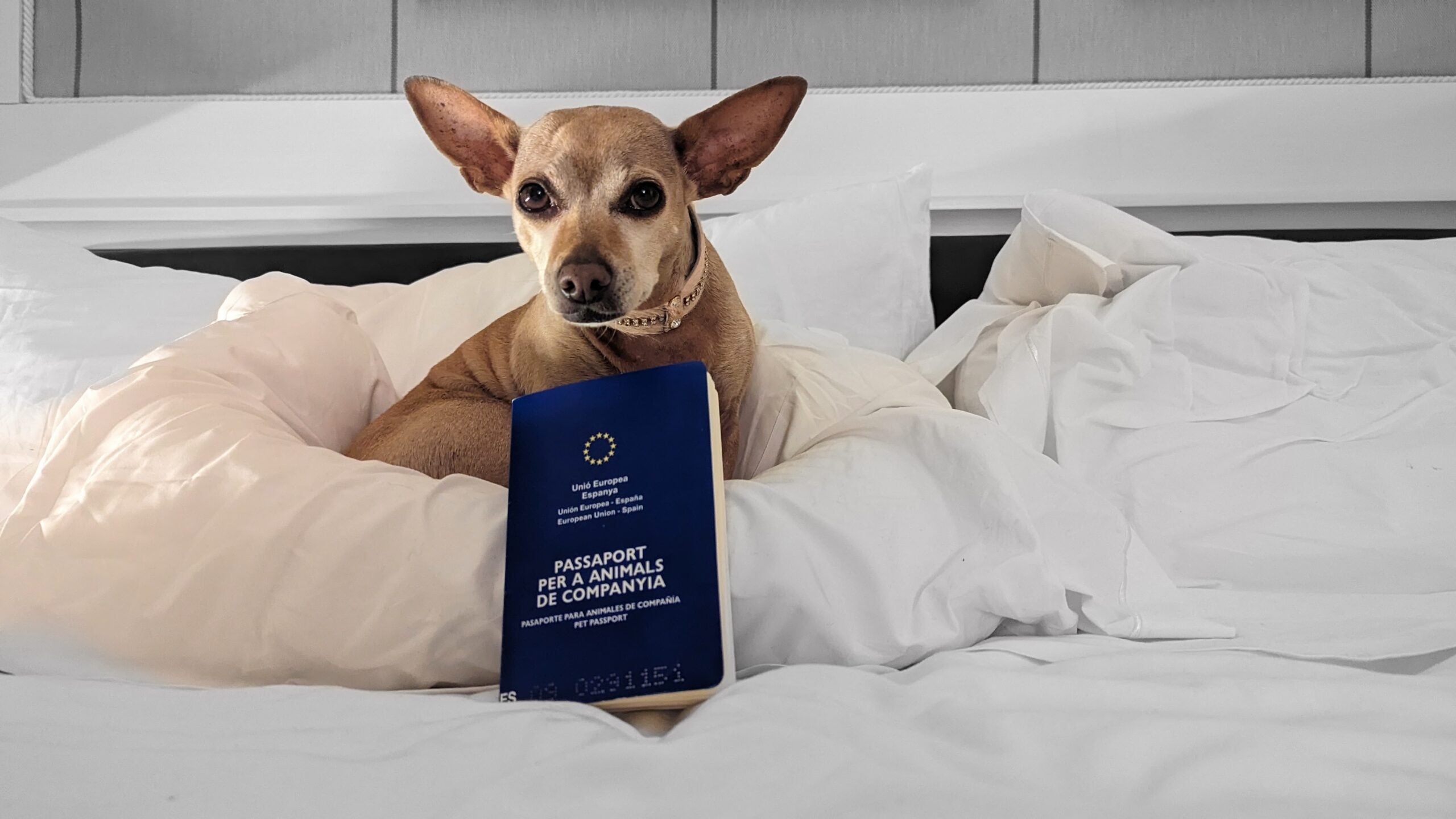
In 2023, my dog Poppy flew United Airlines 37 times, vacationed in Aruba and Mexico , and, most exciting of all, got her European Union pet passport in Barcelona.
Poppy, who is trained to assist me with a psychiatric disability, flies free as my service animal . However, we were spending a small fortune each year on international health certificates (around $300 per certificate) required each time an American dog enters any country other than Mexico and Canada.
Having an EU pet passport eliminates this step and allows Poppy to travel freely to EU countries — as well as Switzerland, Norway and much of the Balkans — for the next three years. This is a great cost-cutting measure for travelers who frequently visit Europe with a pet.
Getting an EU passport for Poppy in Spain was much easier than I expected. As I learned, Barcelona is the perfect destination to go through the process.
Pups are everywhere in this city, and it's hard to walk for more than a minute without your doggo sharing sniffs with another canine. There are also fantastic dog-friendly hotels , restaurants, Europe's only dog water park, beaches and even some attractions you can visit with your fur child.
Here's everything you need to know about the EU pet passport process. Note this article pertains to American dogs traveling to and from the EU. Every country has different entry requirements. So, if your dog doesn't live in the U.S., you'll need to check with your home country about the requirements if you plan to travel back and forth.
What is an EU pet passport?
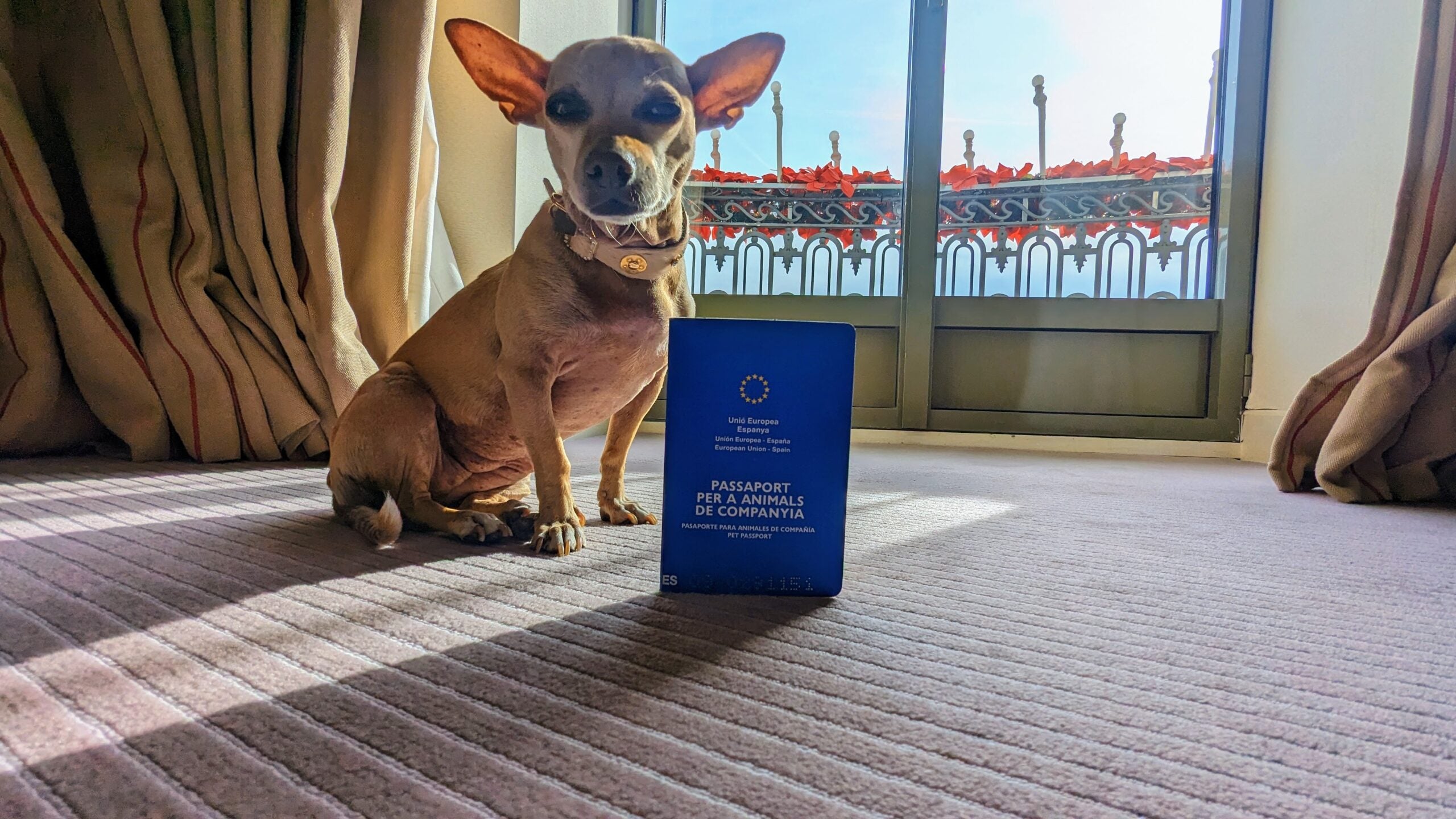
An EU Pet Passport is a document issued by an official veterinarian in a country within the EU that contains health information related to a specific pet. It cannot be obtained in the U.S. The passport is a blue booklet that resembles a human EU passport and even has space for a photo of your pup (though this is not mandatory).
What is mandatory is that your dog be revaccinated for rabies by the EU veterinarian that issues the passport. So, you must take your dog to Europe to get vaccinated. The trickiest part of this process is that your dog must be vaccinated against rabies twice if you are traveling to Europe and not moving there. This is because to return to the U.S., you will need a valid rabies certificate issued by an accredited American veterinarian. Think of it this way: A rabies vaccine basically serves as your pup's passport, so they will be dual citizens.
"Luckily, there are no proven negative effects of double vaccinating a dog against rabies, so long as the vaccines are not given within a few months of each other," Poppy's veterinarian, Dr. Bethany Yurek, who practices in Colorado, told me. Poppy's vaccines are spread out 1.5 years apart, which resulted from lucky timing, but if the vaccines are given about six months apart, you should be good to go.
Of course, it is always best to consult your veterinarian before deciding to revaccinate before expiration. You will also want to request three-year rabies vaccines.
Why get an EU pet passport?
If you plan to travel to Europe multiple times over three years (the length of the longest rabies vaccine), an EU pet passport will save you thousands of dollars and a lot of time.
Without one, you will have to take your dog to its veterinarian to get an EU international health certificate issued and then endorsed by a vet at the U.S. Department of Agriculture. The entire process must be done within 10 days of entering the EU, and it'll cost around $300.
You can use your health certificate to enter multiple EU countries for up to three months on a single visit, but you cannot use the health certificate for a second visit later. So, even though I got a health certificate when I took Poppy to Italy previously, it was not valid for this trip to Spain.
Obtaining an EU pet passport (besides being adorable looking) allows you to travel back and forth to EU countries, Switzerland, Norway and much of the Balkans without any other paperwork for as long as the EU-issued rabies vaccine is valid.
To maintain your dog's EU passport, you must schedule their next rabies vaccine in Europe before it expires.
Can dogs living outside the EU get the pet passport?
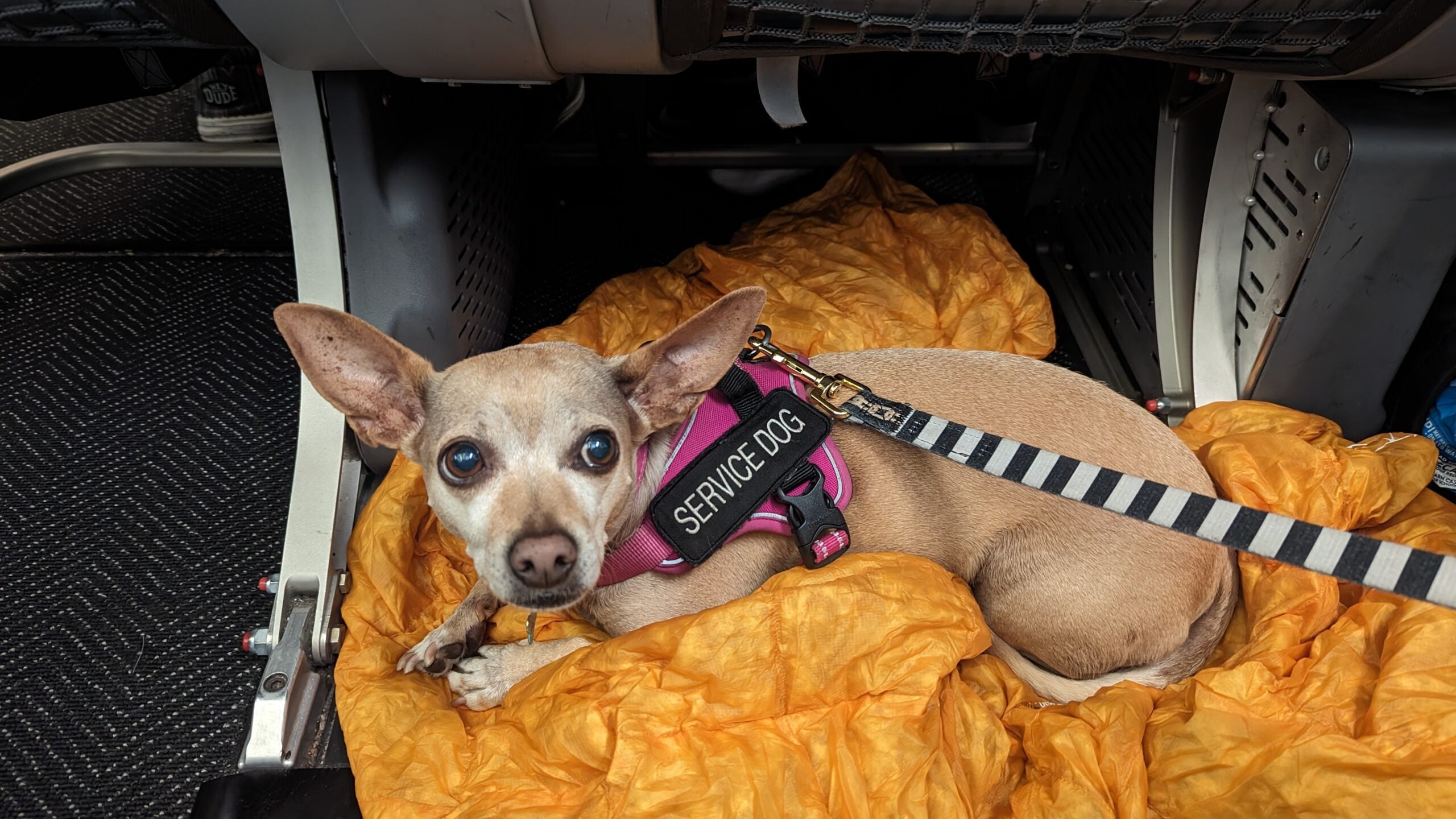
Yes. "The purpose of the EU Pet Passport is to simplify travel between EU Member States, but the EU has also allowed it to be used for pets returning to the EU from other countries as long as it is a non-commercial movement," according to the USDA. Noncommercial movement means you are not importing more than five animals to sell them. The passport is designed for pets only.
What is the process for getting an EU pet passport?
Getting an EU pet passport was a lot easier than I expected. I used TomVets in Barcelona; I found the company by quickly searching Google for vets with good reviews issuing EU pet passports to visitors. I reached out via WhatsApp and received a response in English within a day.
Dr. Tommaso Piermarini makes home vet visits. He came directly to the Majestic Hotel & Spa , where we were staying, to administer the rabies vaccine and issue the passport. It was so convenient that it immediately brought my stress levels down. I filled out some quick paperwork online before the visit, and that was it.
On the appointment day, Dr. Tommaso showed up promptly and spoke fluent English. We went to my room, and the process took less than 30 minutes. When he left, Poppy had a shiny new passport. The cost was also very reasonable at 155 euros ($167).
Barcelona is ideal for a Spanish citizenship vacation

Besides the ease of getting the EU pet passport here with a mobile veterinary service like TomVets, Barcelona is a fantastic doggy vacation destination. In addition to its Mediterranean climate, great food and beautiful beaches, the city welcomes pups with exuberance.
I stayed at the Majestic Hotel & Spa , an elegant neoclassical property on the city's famous shopping street, Passeig de Gracia, in the trendy Eixample neighborhood. Welcoming guests since 1918, it's the city's most famed luxury hotel.
The Majestic welcomes small canine guests with its Very Important Pet package ; the package includes a personalized welcome card, toys, treats, bottled water, a comfortable bed, food and water bowls to use during your stay. Dogs must weigh about 20 pounds or less — the same size pup that can travel as a pet in airplane cabins.
The hotel has various accommodation options, but in honor of Poppy's Spanish citizenship milestone, we stayed in one of the Majestic Suites. The massive room featured multiple balconies offering jaw-dropping, panoramic city views; a separate bedroom and living space; a giant walk-in closet; and a marble bathroom.
Don't skip sunset drinks and a bite to eat at the Majestic's rooftop terrace bar — where you can, of course, bring your pup. The 360-degree views of the city serve as the perfect backdrop for a photo sesh with your best friend. The sunsets seem to go on forever with an everchanging display of vibrant colors.
The hotel also has a fantastic spa, and I got rid of my jet lag with a luxe two-hour body and facial treatment.
Dog-friendly attractions and restaurants

Across the street from the Majestic is Casa Batllo . Considered one of Spanish architect Antoni Gaudi's greatest masterpieces, it was created in the early 1900s for a wealthy family. Nowadays, it is an immersive architectural museum experience and one of the few attractions of its kind that welcomes dogs. Poppy swapped tea with more than one canine visitor while I got lost in its trippy light shows, shimmering tile facade, undulating curves and other swirling shapes. If you visit during summer, Casa Batllo often has live music and drinks on its roof terrace.
The Majestic's central location makes it easy to access some of Barcelona's best neighborhoods for walking. The Gothic Quarter and the Born are within a 30-minute walk of the hotel. Most shops in Barcelona allow dogs, and many restaurants also welcome pets on their patios. Some places — like La Carioca , which serves Brazilian-inspired food and drinks — even include pups inside.
Related: 10 best dog-friendly destinations to explore this summer
Barcelona is also home to Europe's first water park for dogs. AquaPark Canino is a must for pups who like to swim. The park, open from June through September, has two large swimming pools, a dune area for rolling, gardens for frisbee or ball-catching sessions, and even a restaurant where you and your pup can dine.
In winter, you can walk your dog along Barcelona's beachfront and miles of gold sand. However, in summer, you'll need to stick to Llevant Beach, Playa de Les Salines and Cala Vallcarca, which are dog-friendly.
The city also has several dog-friendly parks and gardens, including most parts of Park Guell , another Gaudi-designed masterpiece. Parc de la Ciutadella, Parc del Clot, Parc de la Barceloneta and Joan Miro Park also welcome woofers.
Finally, if your pup likes to shop, you must head to Barcelona Dogs in the Born. The shop carries one-of-a-kind designer collars and matching leashes as well as harnesses and coats for dogs and cats. Poppy chose a beautiful pink suede collar adorned with filigree crystals to celebrate her Spanish citizenship.
Related reading:
- Key travel tips you need to know — whether you're a beginner or expert traveler
- The best travel credit cards
- Where to go in 2024: The 16 best places to travel
- 6 real-life strategies you can use when your flight is canceled or delayed
- 8 of the best credit cards for general travel purchases
- 13 must-have items the TPG team can't travel without
Didn't find what you need? Use the search!
Pet Keen is reader-supported. When you buy via links on our site, we may earn an affiliate commission at no cost to you. Learn more .
Traveling With a Dog to Europe: 6 Things To Consider (Vet Approved)

Vet approved
Reviewed & Fact-Checked By
Dr. Marta Vidal-Abarca
Veterinarian, BVSc GPCert (Ophthal) MRCVS
The information is current and up-to-date in accordance with the latest veterinarian research.
Exploring Europe’s rich history, unique landscape, and all-around wonder is always more enjoyable when you have quality company on your journey. It’s a perfect opportunity for adventurous dog owners to share life-long memories with their best friends.
Europe offers countless dog-friendly locales and activities to make every trip unique and fulfilling, but proper preparation takes much more than packing a travel bag. Ensure the safest, most satisfying journey possible by considering these six points when traveling with your dog to Europe.
The 6 Things to Consider When Traveling With a Dog to Europe
- 1. Check Your Destination Country’s Health Requirements
Check your destination country’s health certification requirements as soon as you decide to travel with your dog to Europe. While EU countries generally use the same rules, some nations, like Iceland and the U.K., have unique travel stipulations.
Research whether the country you plan to visit restricts specific breeds and which vaccination, worming treatment, health exams, and documentation you need to comply with their rules.
- 2. Research Safe Flight Options
Ideally, your dog will fly with you in the airplane cabin. Though cargo holds are generally safe, a long flight to Europe can be stressful and potentially hazardous for your pet.
Research airlines that accept pets in the cabin since not all of them do. Check for rules around weight limits, allowable carrier types, and health requirements to find one that will let you keep your pet by you r side on your outbound and return flight (if there is one!).
- 3. Update Your Dog’s Microchip
European countries require incoming pets to be identified with a microchip or transponder, which they verify by scanning and matching your dog’s microchip number to your paperwork. A non-compliant nine or 10-digit chip may not be scannable. The 15-digit microchip meets ISO standards 11784/11785, making it readable anywhere.
Getting an ISO-compliant chip is a critical first step to accomplish at least a month ahead of tim e. Make sure you match the date of the implantation of the microchip with your dog’s rabies vaccine (see point number 3) . If you’re unsure whether your dog has a valid chip, your vet can do a quick scan and provide all the information.
If your dog has a non-ISO chip, speak to your vet about the best options. It’s generally okay to give your dog a new microchip when they have a non-compliant one, as anyone scanning them can differentiate between the chips to get the necessary information. However, your vet will help you with this decision.
Update your contact information in the microchip’s database. While you must have a valid chip to enter Europe with a dog, it’s also a crucial backup during your stay in case your dog wanders off. Keeping up-to-date information on a scannable microchip is the surest way to significantly increase your chances of reuniting with a lost pet.
- 4. Get Your Dog a Rabies Vaccine
After resolving your pet’s microchip, they’ll need a rabies vaccine at least 21 days before traveling. Three weeks is the time it takes for your dog’s antibodies to deve lop, ensuring they are protected against the disease during their trip.
Ask your vet about the longevity of the various vaccination options. To save time, your dog can get a rabies vaccination well before the trip as long as it won’t expire while you are in Europe. Primary vaccines are usually valid for 1 year, while follow-up boosters might be good for up to 3 years, but this depends on the type of vaccine and the country’s requirements.
The critical point to consider is that you should only do this if your dog already has an up-to-date microchip. If the rabies certificate doesn’t indicate the microchip number matching it to your dog, it won’t matter whether they’re vaccinated.
- 5. Acquire a “Non-Commercial” Health Certificate
When your dog has the necessary treatments, you can acquire the “commercial” or “non-commercial” EU animal health certificate. An EU animal health certificate is a type of document that contains specific information about your pet (identity, health, rabies vaccinations ) and is based on an EU standard model. The non-commercial health certificate will be the one to choose if you travel alongside fewer than five dogs.
You need an accredited veterinarian to issue the certificate within 10 days of the arrival date. If your vet doesn’t have USDA certification, they can at least refer you to a local vet who does. After completing the health certificate, you’ll send it to your state’s USDA Endorsement Office .
You only have 10 days to get the endorsement. Play it safe by submitting your certificate as early as possible in that window and choosing overnight shipping on return paperwork to receive it faster. Once you have the health certificate, it’s va lid for travel between EU countries for 4 months as long as the rabies vaccine does not expire.
- 6. Give Your Dog a Tapeworm Treatment If Needed
Depending on where you travel in Europe, your dog may need tapewo rm treatment 24–120 hours before arriv al. All details of the treatment must be entered in your pet’s passport or EU health certificate. Th e following countries require tapeworm treatment for incoming dogs:
- United Kingdom
A vet must administer the treatment containing Praziquantel to work against Echinococcus multilocularis . You’ll need a record of the treatment on your health certification or pet passport. Unless your dog is in Europe for more than 4 months or falls ill, this may be the only vet trip you’ll need to make during your travels.
Adventuring in Europe is an exciting opportunity many pets don’t get to enjoy. Dog-friendly tourist sites, hotels, and eateries abound, offering no shortage of unique stories to bring home with every trip. Research and plan your itinerary to confirm dogs are welcome everywhere you want to visit, and consider these six essential points to ensure the smoothest experience while traveling with your dog to Europe.
Last but not least, don’t forget to check the requirements to return to your home country once your trip to Europe has finished. Work with your vet to get this information right, as most countries have easily accessible online information about the requirements for dogs returning back home.
- https://www.aphis.usda.gov/aphis/pet-travel/take-pet-to-foreign-country
Featured Image Credit: Frau aus UA, Shutterstock
Nicole Cosgrove
Lead Pet Expert & Pet-ditor in Chief
Related articles
How much exercise does an australian shepherd need vet approved advice, when will my labradoodle calm down facts & faq.
Search our database of over 16780 posts with up-to-date information from our experts and veterinarians.
Want to talk to a vet online?
Whether you have concerns about your dog, cat, or other pet, trained vets have the answers!
9 Best Places to Travel with a Dog in Europe [Mega Guide]
Imagine embarking on a getaway with your furry best friend, where every moment is a joyful adventure! 💭 We've shared the most dog-friendly countries of Europe & some other useful insights to be aware of. Read on and get ready for your adventure! ✈️ 🐶
Are you dreaming of exploring Europe's charming cities, picturesque landscapes, and rich history? Well, good news! You can do it all with your four-legged companion by your side.
Traveling with a dog in Europe is not only possible but also incredibly rewarding. In this guide, we'll walk you through a list of the most dog-friendly destinations in Europe. So, grab your leash, and let's embark on a European adventure like no other!
🐾 Can You Travel Around Europe with a Dog? Absolutely! Europe is known for its pet-friendly culture and welcoming attitude towards dogs. From strolling through historic streets to hiking in breathtaking mountains, there's a world of possibilities for you and your furry travel buddy.
Table of Contents
What is the Most Pet-Friendly Country in Europe?
Where can i take my dog in europe, what is the best way to travel long distance with a dog, plan your pawsome european adventure, 🇫🇷 france - paris: a pet-friendly adventure, 🇮🇹 italy - rome: a roman holiday with your pooch, 🇪🇸 spain - barcelona: a bark-tastic getaway, 🇩🇪 germany - berlin: a dog-friendly exploration, 🇳🇱 netherlands - amsterdam: canine adventures in the dutch capital, 🇦🇹 austria - vienna: an austrian adventure with your pup, 🇨🇭 switzerland - zurich: alpine adventures with your canine companion, 🇭🇷 croatia - split: coastal adventures with your four-legged friend, 🇵🇹 portugal - lisbon: coastal charm with your canine companion, what are the requirements for a dog to travel to europe.
- Is Europe More Dog-Friendly Than America?
- Final thoughts
Spain boasts numerous dog-friendly beaches, parks, and hiking trails, ensuring your pup can enjoy the great outdoors. Many restaurants and cafes in Spain also welcome dogs on their outdoor terraces, allowing you to savor delicious Spanish cuisine with your loyal companion by your side.
Determining the most pet-friendly country in Europe can be subjective and dependent on various factors. While the UK is known for its pet-friendly culture and laws, there are other European countries that also excel in being pet-friendly.
Below are a few countries in Europe that are known for their pet-friendly attitudes and policies.
Here's a list of 10 b est places to travel with a dog in Europe:
- Car : Traveling by car can be one of the most convenient options when you have a dog. You have control over the environment, and it allows for more flexibility. Be sure to secure your dog safely with a harness or crate while driving. Also, plan regular breaks for your dog to stretch, drink water, and relieve itself.
- Trains : Many train services in Europe are pet-friendly, especially smaller regional trains. Larger trains, like high-speed trains, may have specific rules, so it's essential to check with the train company in advance. Generally, small dogs may be allowed to travel in a carrier or bag, while larger dogs might need a leash and muzzle.
- Buses : Local buses often allow small dogs to travel in a carrier or bag. Larger dogs may be required to wear a muzzle and leash. Check with the bus company for specific rules.
- Flights : If you're traveling a long distance, flying may be necessary. Airlines have varying policies on traveling with pets in the cabin or as cargo. Smaller dogs may be allowed in the cabin if they fit in an airline-approved carrier. Larger dogs may need to be transported as cargo, which requires additional planning and considerations for their safety and comfort.
- Ferries : If you're traveling to an island or coastal destination, ferries may be an option. Many ferries allow dogs, but rules and facilities can vary, so it's advisable to check in advance.
- Public Transportation : In cities, public transportation policies for pets can vary widely. Some cities are very pet-friendly, while others may have restrictions or require pets to be in a carrier. Research the public transportation policies of your specific destination.
- Walking and Hiking : If you plan to explore a city or go hiking, walking is often the best mode of transportation for your dog. Be sure to check leash laws and any local regulations regarding dogs in public spaces.
- Rental Cars : When renting a car, inquire about the rental company's pet policy. Many rental companies allow pets, but some may charge an additional fee or have specific requirements.
Regardless of the mode of transportation you choose, it's essential to prepare in advance. Ensure your dog is comfortable with the chosen method, and bring necessary supplies like food, water, waste bags, and a familiar blanket or toy to help them feel at ease during the journey. Always check the specific pet policies and regulations of the transportation provider or destination you plan to visit to ensure a smooth and stress-free trip for both you and your dog.
Speaking of travel adventures with your four-legged companion, we've crafted an amazing app just for you! It will guide you to dog-friendly destinations and exciting activities, spill the beans on pet-welcoming hotels and dining spots, and even help you sort out transportation.
☑ Customized itineraries for you and your furry friend
☑ Dog-friendly accommodations, transport, and restaurants
☑ Expert travel tips and advice
We did some research for some short itineraries in the countries mentioned above with the most pet-friendly locations to help you better decide your next trip with your pup:
Day 1: Arrival in the City of Love - PARIS 💕
- Accommodation : Welcome to Paris! Check into Le Meurice, a luxurious hotel known for its pet-friendly hospitality.
- Transport : Paris is a pedestrian-friendly city. Explore neighborhoods like Le Marais and Montmartre with your furry friend.
- Food : Begin your culinary journey at Le Saint Régis, a charming riverside restaurant that welcomes pets.
- Attractions : Visit Montmartre and let your dog play in the pet-friendly Parc des Buttes-Chaumont.
Day 2: Parisian Delights 🥐
- Accommodation : Enjoy another night at Le Meurice, where your pet is pampered.
- Transport : Paris is incredibly pet-friendly for public transport. Dogs are allowed on buses, trams, and the metro.
- Food : Savor French delights at Le Volpi e l'Uva, a dog-friendly wine bar with an inviting outdoor terrace.
- Attractions : Explore the magnificent Palace of Versailles, where your leashed dog can join you in the gardens.
Day 3: Riviera Bliss 🛥
- Accommodation : Head south to Nice on the French Riviera and stay at the pet-friendly Hotel Negresco.
- Transport : Stroll along the pet-friendly Promenade des Anglais and enjoy the stunning views of the Mediterranean.
- Food : Dine at Le Plongeoir, a restaurant with a pet-friendly terrace hanging over the sea.
- Attractions : Discover the pet-friendly Villa Ephrussi de Rothschild and take a scenic walk along the Mediterranean coast.
Day 1: Embrace the Eternal City - ROME 🏛
- Accommodation : Settle into the pet-friendly comforts of the Hotel Artemide in the heart of Rome.
- Transport : Explore Rome's historic center on foot, with your dog by your side.
- Food : Satisfy your appetite with traditional Italian cuisine at Tazza d'Oro, a cafe with pet-friendly outdoor tables.
- Attractions : Wander to the iconic Colosseum and Roman Forum, where dogs are typically allowed on leashes.
Day 2: Florence - The Artistic Gem 🛵
- Accommodation : Travel to Florence and enjoy a pet-friendly stay at Hotel Savoy.
- Transport : Discover the city's artistic treasures on foot or hire a pet-friendly taxi for convenience.
- Food : Sip on wine and savor Tuscan flavors at Le Volpi e l'Uva, a wine bar that welcomes canine companions.
- Attractions : Explore the stunning Boboli Gardens, a peaceful oasis where dogs are welcome.
Day 3: Venetian Adventures 🎭
- Accommodation : Conclude your Italian journey in Venice at Bauer Palazzo, where pets are treated with love and care.
- Transport : Venice is a pedestrian paradise, and your dog can join you on water taxis and vaporettos.
- Food : Indulge in fresh seafood at Al Timon, a pet-friendly restaurant with Grand Canal views.
- Attractions : Treat your furry friend to a dog-friendly gondola ride and visit the historic Doge's Palace.
Day 1: Welcome to Barcelona 🎢
- Accommodation : Start your adventure at Hotel Arts Barcelona, where pets are embraced.
- Transport : Barcelona is pedestrian-friendly, and your dog can accompany you on public transport.
- Food : Head to Can Majo, a beachfront restaurant with pet-friendly outdoor seating, for a delicious meal.
- Attractions : Begin with a visit to Park Güell, where your dog can join you on its many pathways.
Day 2: Exploring the City 🌆
- Accommodation : Enjoy another night at Hotel Arts Barcelona, a pet-friendly haven.
- Transport : Explore the city's vibrant neighborhoods and attractions, like the Gothic Quarter and Sagrada Familia.
- Food : Discover pet-friendly cafes like El Jardi de l'Abadessa and indulge in Spanish flavors.
- Attractions : Take a leisurely walk through the picturesque streets of El Born, stopping for tapas along the way.
Day 3: Beachside Relaxation 🏖
- Accommodation : Spend your final day in Barcelona at the Meliá Barcelona Sky.
- Transport : Take your dog to the pet-friendly Barceloneta Beach for a relaxing day by the sea.
- Food : Enjoy seafood at Salamanca, a restaurant that offers pet-friendly terrace seating.
- Attractions : Wrap up your trip with a visit to the Montjuïc Castle and its dog-friendly grounds.
Day 1: Welcome to Berlin 🍻
- Accommodation : Start your adventure in Berlin at the pet-friendly Hotel Adlon Kempinski.
- Transport : Berlin is a dog-friendly city. Use public transport, or explore on foot with your furry companion.
- Food : Experience the city's pet-friendly cafe culture at locations like Café am Neuen See.
- Attractions : Begin with a visit to the Berlin Wall Memorial, which allows leashed dogs.
Day 2: Art and Culture in Berlin 🏰
- Accommodation : Enjoy another night at the Hotel Adlon Kempinski, where your pet is treated with care.
- Transport : Explore the city's many art galleries, museums, and historical sites with your dog.
- Food : Savor German cuisine at dog-friendly restaurants like Prater Garten.
- Attractions : Visit Tiergarten, a massive urban park where your dog can roam freely.
Day 3: Nature and Relaxation 🌳 🥨
- Accommodation : Spend your final day in Berlin at Hotel Adlon Kempinski.
- Transport : Take a leisurely stroll along the Spree River or enjoy a pet-friendly boat tour.
- Food : Wrap up your trip with a meal at Das Lokal, a pet-friendly restaurant with a welcoming atmosphere.
- Attractions : Explore Grunewald Forest, where your dog can join you on scenic hikes.
Day 1: Arrival in Amsterdam 🌿
- Accommodation : Start your Dutch adventure at the pet-friendly Pulitzer Amsterdam.
- Transport : Dogs are allowed on trams and ferries in Amsterdam, making it easy to get around.
- Food : Explore pet-friendly cafes and restaurants in the city, like Café Hegeraad.
- Attractions : Take a relaxing stroll along the picturesque canals with your dog.
Day 2: Exploring Amsterdam 🚲
- Accommodation : Enjoy another night at the Pulitzer Amsterdam, where pets are treated like family.
- Transport : Continue your exploration of Amsterdam's charming neighborhoods and iconic landmarks.
- Food : Indulge in Dutch cuisine at dog-friendly spots like Cafe-Restaurant De Ysbreeker.
- Attractions : Visit the famous Anne Frank House, where your leashed dog is welcome in the courtyard.
Day 3: Parks and Canals 🥏 🌳
- Accommodation : Spend your final day in Amsterdam at the Pulitzer Amsterdam.
- Transport : Explore Amsterdam's famous parks and canals, where your dog can join you on leisurely walks.
- Food : Wrap up your culinary experience at a pet-friendly eatery like Waterkant.
- Attractions : Discover Vondelpark, a pet-friendly oasis, and take a scenic boat tour on the canals with your dog.
Day 1: Arrival in Vienna ☕️ 🐕
- Accommodation : Begin your Austrian adventure at the pet-friendly Hotel Sans Souci Wien.
- Transport : Vienna's public transport system is pet-friendly. Leash up your dog and hop on trams and buses.
- Food : Enjoy a Viennese coffeehouse experience at pet-friendly cafes like Café Schwarzenberg.
- Attractions : Start with a visit to the historic Hofburg Palace and its dog-friendly gardens.
Day 2: Cultural Exploration 🕍
- Accommodation : Enjoy another night at Hotel Sans Souci Wien, where your pet is warmly welcomed.
- Transport : Explore Vienna's cultural treasures, including museums, palaces, and the historic city center.
- Food : Savor Austrian dishes at pet-friendly restaurants like Figlmüller Wollzeile.
- Attractions : Visit the Schönbrunn Palace Gardens, a vast area where dogs are allowed on leash.
Day 3: Vienna's Green Spaces 🌱
- Accommodation : Spend your final day in Vienna at Hotel Sans Souci Wien.
- Transport : Take your dog to Prater Park, an expansive green space perfect for leisurely walks.
- Food : Wrap up your Austrian culinary journey at a pet-friendly dining spot like Gasthaus Pöschl.
- Attractions : Explore Belvedere Palace and its dog-friendly grounds before bidding Vienna farewell.
Day 1: Welcome to Zurich 🇨🇭
- Accommodation : Start your Swiss adventure at the pet-friendly Baur au Lac.
- Transport : Zurich is pet-friendly when it comes to public transport. Dogs are allowed on trams and trains.
- Food : Experience Swiss cuisine at pet-friendly cafes like Schwarzenbach.
- Attractions : Begin with a leisurely walk along Lake Zurich's promenade with your dog.
Day 2: Exploring Zurich 🎒🗻
- Accommodation : Enjoy another night at the Baur au Lac, where pets are treated with care.
- Transport : Explore Zurich's cultural and historical sites, including the Old Town and museums.
- Food : Indulge in Swiss fondue at dog-friendly restaurants like Swiss Chuchi.
- Attractions : Take a scenic hike in the nearby Swiss Alps, with your dog by your side.
Day 3: Nature and Relaxation 🍃 🦋 🐕
- Accommodation : Spend your final day in Zurich at the Baur au Lac.
- Transport : Enjoy a peaceful day by pristine lakes in the Swiss countryside, accessible by train with your dog.
- Food : Wrap up your Swiss culinary journey at a pet-friendly eatery like Zeughauskeller.
- Attractions : Discover the beauty of Uetliberg Mountain, a pet-friendly hiking destination with panoramic views.
Day 1: Arrival in Split 🌞
- Accommodation : Begin your Croatian journey at the pet-friendly Hotel Park Split.
- Transport : Stroll along the pet-friendly Split waterfront and explore the city's historic center.
- Food : Enjoy Mediterranean cuisine at dog-friendly restaurants like Bokeria Kitchen & Wine.
- Attractions : Visit Diocletian's Palace, where dogs are often allowed in the open areas.
Day 2: Coastal Exploration ⛴
- Accommodation : Enjoy another night at Hotel Park Split, known for its pet-friendly amenities.
- Transport : Take a local ferry with your dog to explore nearby islands or relax on dog-friendly beaches.
- Food : Savor seafood at Perivoj, a restaurant with a pet-friendly terrace overlooking the sea.
- Attractions : Discover the pet-friendly Marjan Hill, a natural park with hiking trails and stunning views.
Day 3: Beaches and History 🗿 🌊
- Accommodation : Spend your final day in Split at Hotel Park Split.
- Transport : Enjoy a day at the dog-friendly Bacvice Beach or explore nearby dog-friendly beaches and coves.
- Food : Wrap up your Croatian culinary experience at Villa Spiza, a restaurant that welcomes pets.
- Attractions : Explore Klis Fortress, a historic site where leashed dogs are often allowed.
Day 1: Arrival in Lisbon 🚃
- Accommodation : Start your Portuguese adventure at the pet-friendly Memmo Príncipe Real.
- Transport : Lisbon's trams and some buses allow dogs, making it easy to explore the city.
- Food : Dine at pet-friendly cafes like Café Tati and Fábulas to taste Portuguese flavors.
- Attractions : Take a leisurely walk in the pet-friendly Jardim da Estrela, a beautiful garden.
Day 2: Exploring Lisbon 🐾
- Accommodation : Enjoy another night at the Memmo Príncipe Real, where your pet is a cherished guest.
- Transport : Continue your exploration of Lisbon's historic neighborhoods, like Alfama and Bairro Alto.
- Food : Experience Portuguese cuisine at pet-friendly restaurants like Tasca do Chico.
- Attractions : Visit the famous Pasteis de Belém bakery, where you can enjoy pastries with your leashed dog on the terrace.
Day 3: Coastal Delights 🌊
- Accommodation : Spend your final day in Lisbon at the Memmo Príncipe Real.
- Transport : Take a scenic tram ride to the coastal town of Cascais, known for its pet-friendly atmosphere and stunning seaside views.
Exploring Cascais 🏝
- Beach Time : Head to the picturesque Praia da Conceição or Praia da Rainha, where dogs are often welcome on the sandy shores.
- Lunch : Enjoy a seafood feast at one of the pet-friendly restaurants with oceanfront terraces, such as Mar do Inferno.
- Cascais Marina : Take a leisurely walk along the Cascais Marina promenade, where you can watch boats and enjoy the fresh sea breeze with your furry companion.
- Cultural Visit : Explore the Museu Condes de Castro Guimarães, a pet-friendly museum housed in a beautiful historic mansion.
- Return to Lisbon : In the late afternoon, catch the tram back to Lisbon, savoring the coastal views one last time.
- Farewell Dinner : For your last evening, dine at a pet-friendly restaurant in Lisbon's historic Alfama district, like Pateo 13.
Traveling with your dog to Europe typically requires a few essential steps:
- Microchipping: Ensure your dog has a microchip with your contact details.
- Rabies Vaccination: Make sure your dog is up-to-date on their rabies vaccination, and this should be administered at least 21 days before traveling.
- Pet Passport: Obtain a pet passport from your veterinarian, which includes vaccination records and identification.
- Tapeworm Treatment: Some countries may require a tapeworm treatment within a specified period before entry.
- Health Certificate: Obtain a health certificate from your vet shortly before departure.
🌍 Is Europe More Dog-Friendly Than America? 🌎
While Europe is renowned for its dog-friendly attitude, the United States also boasts many pet-friendly destinations. Ultimately, the level of dog-friendliness can vary from place to place, both in Europe and the USA. It's essential to research and plan your trip carefully to ensure a smooth and enjoyable experience for both you and your furry companion.
Which European country loves dogs the most?
💗 After our research seems that Germany is for sure the European country that loves dogs the most. It's commonly believed that Germany has a strong love for dogs due to cultural factors, dog-friendly policies, infrastructure, and a thriving dog-related community.
Final thoughts 💭
Traveling with your dog in Europe is not only possible but also a fantastic way to create lasting memories together. The continent offers a plethora of pet-friendly destinations and welcoming cultures, making it an ideal choice for dog owners seeking adventure.
How about an article that explores the Challenges of Traveling with Dogs in Europe's Less Pet-Friendly Countries? 🌍🐕
Least Dog-Friendly Countries in Europe: Restrictions to Know
Hepper is reader-supported. When you buy via links on our site, we may earn an affiliate commission at no cost to you. Learn more .
Traveling With a Dog to Europe: 10 Vet-Approved Tips
By Jessica Kim
Updated on Apr 9, 2024
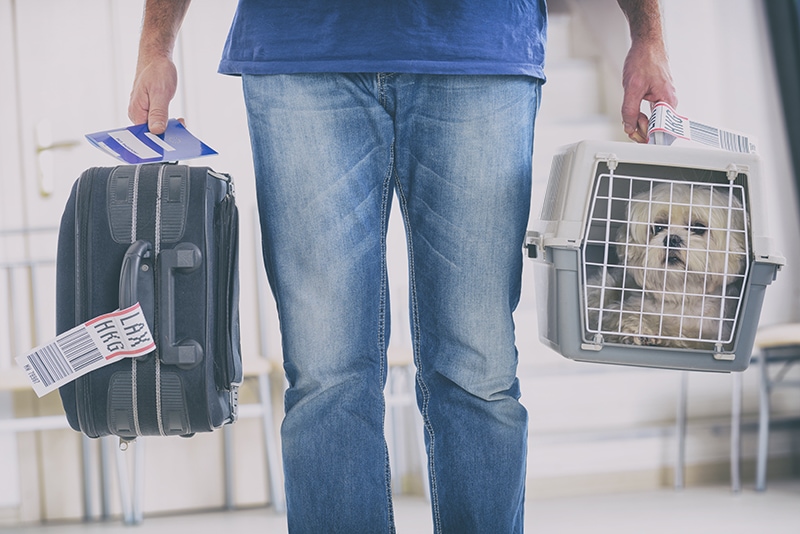
Vet approved
Reviewed & Fact-Checked By
Dr. Maja Platisa
In-House Veterinarian, DVM MRCVS
The information is current and up-to-date in accordance with the latest veterinarian research.
Traveling to Europe with your dog is a great way to create fun memories and make your travel experience unique. However, there’s no denying that it takes extra time and planning to ensure your dog is ready to travel. You’ll have to make sure that you obtain all the necessary travel documents and work with airline companies and hotels that can accommodate dogs.
It can feel overwhelming as you’re trying to figure out how to travel with your dog to Europe. So, we’ll go over the basics of what you need to do to ensure that you and your dog can travel together.
The 10 Tips for Traveling With a Dog to Europe
1. research the destination country’s travel policy.
Before you start booking flights, make sure to familiarize yourself with your destination country’s pet travel laws. If you’re going to a country that is a member of the European Union, you can start your research by viewing the European Union’s travel requirements for pets. Just keep in mind that while most countries in the European Union have similar travel policies, some can have slightly differing requirements for the types of vaccinations your dog will need.
2. Get Your Dog Microchipped
In order to enter a European Union country, your dog must be microchipped. It’s most convenient to use an ISO-compliant microchip, as customs officials will have scanners for these types of microchips. If your dog hasn’t been microchipped with an ISO-compliant microchip, you can either bring your own scanner for your dog’s current microchip or have your veterinarian implant a second one.
Microchipping is still important even if a country doesn’t require it. Traveling can be stressful for dogs, and they’re often more prone to wandering off and getting lost. So, getting your dog microchipped and updating the information associated with the microchip is a standard practice for pet travel.
3. Schedule a Veterinarian Appointment
One of the most significant documents you’ll have to obtain is a pet health certificate. You can start to apply for this certificate by visiting a federally-accredited veterinarian, which is a veterinarian that’s authorized to endorse pet health certificates. A federally-accredited veterinarian can conduct a physical exam and make sure that your dog gets all the vaccines, tests or treatments that are required by the country you’re entering.
Keep in mind that some European countries have varying waiting periods for dogs that can enter their country after they’ve gotten a specific vaccine. So, it’s extremely important to schedule a veterinarian appointment as soon as possible in case your destination country requires a waiting period.
4. Receive a USDA Endorsement
Many countries require a health certificate that’s endorsed by the USDA. You can obtain a USDA endorsement by having an accredited veterinarian complete, sign, and date a health certificate. The veterinarian will submit the health certificate to the USDA or provide sufficient paperwork so that you can submit it yourself. The processing period can vary, and it can take several weeks for the paperwork to be processed and endorsed.
5. Book Flights With the Right Airlines
Make sure to read through each airline company’s pet travel policy because they can differ from one another. For example, some companies don’t allow dogs to travel in cargo, and others won’t allow pets on flights that last over a certain number of hours. It’s also important to find out if a company has breed restrictions and won’t allow certain dog breeds on their flights.
It’s best to contact an airline company directly to get the most updated information on their pet travel policies. A representative will be able to walk you through all the documents you need to obtain and ensure that your dog is able to travel with them.
6. Find a Pet-Friendly Hotel
It can take some time to find a pet-friendly hotel abroad, so try to begin your search as soon as you can. Pet-friendly hotels will have their own rules and regulations with dogs on their premises. Most won’t allow unleashed dogs in shared spaces, and some won’t allow dogs to remain unattended in their rooms. As with airline companies, it’s best to contact pet-friendly hotels directly to get their most updated pet policies, as they can change at any time.
7. Purchase an Airline-Approved Travel Crate
Once you’re ready to book a flight with an airline, check to make sure that you have a dog crate that’s compliant with the airline’s requirements. Dogs traveling in-cabin must remain in their crates throughout the duration of the flight, and they must be stowed beneath your seat. So, it’s important to find a crate that’s both comfortable for your dog and in compliance with the airline’s dimension and size requirements.
If you’re looking for a new travel dog crate, it’s best to start your search by asking your airline company if they have any specific recommendations. You must also get your dog acclimated and comfortable inside the crate, so it’s important to start or brush up on crate training at least a few weeks before your flight departure date.
8. Be Prepared at Customs
Make sure that you have all your paperwork in one place so that you can enter and exit customs with ease. You should have your dog’s endorsed health certificate on hand, and it’s also helpful to have their microchip ID written on any travel documents so that the customs officer can view and verify them quickly.
If your dog is traveling in cargo, you’ll receive a tracking number, also known as an air waybill number, after you’ve checked them in. Make sure to keep this number in a safe spot, as you’ll need it to claim your dog in customs.
9. Consider Getting an EU Pet Passport
If you plan to be abroad in Europe for a long time and will travel to different countries, you may want to consider getting an EU Pet Passport. An EU Pet Passport is an official health document that enables dogs to travel through EU countries with just one health document rather than having health documents for each individual country. The purpose of this passport is to make traveling with dogs easier, but it’s not necessary, especially if you only plan to visit one country.
An EU Pet Passport cannot be issued in the US , and you’ll have to schedule an appointment with an accredited veterinarian in an EU country to obtain one.
10. Take It Easy on the First Few Days in Europe
Traveling can be very stressful for dogs , so it’s important to take it easy once you arrive in Europe. Make sure to spend the rest of the day with your dog, check on their condition, and look for any signs of illness. It’ll also be helpful to map any vet clinics near your hotel in case of any emergencies.
It’ll take a few days for your dog to adjust to being in a new country, so try not to engage in any over strenuous and over stimulating activities right away.
When traveling to Europe with dogs, it’s best to have as much time as possible on your side.
Getting a USDA endorsement on health certificates can take several weeks, and some countries have vaccination waiting periods. So, make sure to contact a federally-accredited veterinarian and start the process of getting a health certificate right away. If you have any questions about pet travel , it’s best to contact the USDA or the embassy of your destination country to obtain the most accurate and updated information.
- https://www.avma.org/resources-tools/pet-owners/petcare/microchips-reunite-pets-families/microchipping-faq
- https://www.aphis.usda.gov/aphis/pet-travel/pet-travel-info-and-guidance-document/pet-travel-guidance
- https://www.aphis.usda.gov/aphis/pet-travel/by-country/eu/pet_travel-european_union_pet_passports
Featured Image Credit: Monika Wisniewska, Shutterstock
Related Articles
Further Reading
Black Doberman: Facts, History & Origin (With Pictures)
By Elizabeth
Apr 22, 2024 - 6 min read
Can a Maltipoo Eat Human Food? Vet-Reviewed Facts
Mar 18, 2024 - 5 min read
How to Groom a Bloodhound: 7 Expert Tips
Mar 1, 2024 - 6 min read
Vet Articles
Latest Vet Answers
The latest veterinarians' answers to questions from our database
Do Cats Normally Breathe Faster When They Purr? Our Vet Explains
Answered by Dr. Iulia Mihai
Rabies in Dogs: Causes, Signs & Care Guide
Betta Fish Gill Flukes: Causes, Signs, Treatment & Prevention
Answered by Dr. Luqman Javed, DVM (Vet)
Can Dogs Eat Barley? Our Vet Explains The Nutrition Facts
Kidney Disease in Cats: Causes, Signs & Treatments (Vet Approved)
Answered by Dr. Chantal Villeneuve, MS BVetMed (Vet)
7 Neurological Issues in Dogs & Common Signs to Keep in Mind (Vet Approved)
Cat food recalls
Have a cat? Stay on top of cat food recalls here >
Dog food recalls
Have a dog? Stay on top of dog food recalls here >
Have a question? talk to a vet online for advice >


- Application Requirements
Cookies on GOV.UK
We use some essential cookies to make this website work.
We’d like to set additional cookies to understand how you use GOV.UK, remember your settings and improve government services.
We also use cookies set by other sites to help us deliver content from their services.
You have accepted additional cookies. You can change your cookie settings at any time.
You have rejected additional cookies. You can change your cookie settings at any time.
Register to vote Register by 18 June to vote in the General Election on 4 July.
- Passports, travel and living abroad
- Travel abroad
Taking your pet dog, cat or ferret abroad
Travelling to an eu country or northern ireland.
When travelling to an EU country or Northern Ireland, your pet needs:
- a microchip
- a valid rabies vaccination
- an animal health certificate , or a valid pet passport that’s accepted in the country you’re travelling to
- tapeworm treatment for dogs if you’re travelling directly to Finland, Ireland, Northern Ireland, Norway or Malta
These requirements also apply to assistance dogs.
Check the rules of the country you’re travelling to for any additional restrictions or requirements before you travel.
If you have a pet passport
You cannot use a pet passport issued in Great Britain (England, Wales and Scotland).
You can only use a pet passport if the country you’re travelling to accepts passports for pets coming from Great Britain. The passport must have been issued in one of the following places:
- an EU country
- Faroe Islands
- Liechtenstein
- Northern Ireland
- Switzerland
- Vatican City State
You should check if it’s accepted before you travel and find out if you need any other supporting documents .
If it is not accepted, you’ll need an animal health certificate instead.
Travelling from Great Britain to Northern Ireland
If you have a pet passport issued in Northern Ireland, contact your vet for advice before travelling.
Read the rules about taking pets to Northern Ireland on the NIDirect website before you travel.
Arriving in an EU country or Northern Ireland
You’ll need to go through a travellers’ point of entry when you arrive in an EU country or Northern Ireland.
You may need to show your pet’s animal health certificate or a valid pet passport, containing proof of their:
- rabies vaccination
- tapeworm treatment (if required)
Repeat trips to an EU country or Northern Ireland
Your pet will need a new animal health certificate for each trip to an EU country or Northern Ireland.
Your pet will not need a repeat rabies vaccination so long as its rabies vaccinations are up to date.
Your dog will need tapeworm treatment for each trip if you’re travelling directly to Finland, Ireland, Malta, Northern Ireland or Norway.
Travelling with more than 5 pets
You cannot take more than 5 pets to an EU country or Northern Ireland unless you’re attending or training for a:
- competition
- sporting event
You’ll need written evidence of registration for the event when you travel.
All your pets must:
- be attending the event or training
- be over 6 months old
- meet all the other requirements for pet travel to that country
Exporting pets for commercial purposes
Read the Border Operating Model if you want to export pets to an EU country or Northern Ireland for commercial reasons such as change of ownership.
Related content
Is this page useful.
- Yes this page is useful
- No this page is not useful
Help us improve GOV.UK
Don’t include personal or financial information like your National Insurance number or credit card details.
To help us improve GOV.UK, we’d like to know more about your visit today. Please fill in this survey (opens in a new tab) .

Driving Through Europe with a Dog: The Ultimate Guide
Are you traveling in europe with a dog.
We asked nomad expert Julie from WarrenJulieTravel for her top tips on how to get around with your pups .
Embarking on a European adventure is a dream for many people, and what better way to experience the diverse landscapes, cultures, and cuisines of this continent than by hitting the road with your faithful fur baby?
Driving through Europe by car with a dog can be an incredibly rewarding experience, offering flexibility, freedom, and the opportunity to create unforgettable memories together. However, it requires careful planning and consideration to ensure a smooth and enjoyable journey for both you and your furry friends.
We have been doing this now for over three years and have first-hand experience. Here’s a comprehensive guide to help you navigate the ins and outs of traveling Europe by car with dogs.

Paperwork for Driving in Europe with a Dog
Before setting off on your road trip, make sure you have all your paperwork ready for driving in Europe with a dog. Thorough preparation is essential. Start by meticulously researching the rules and regulations for traveling with a dog in the countries you plan to visit.
While most European countries welcome dogs, each may have different requirements regarding vaccinations, microchipping, and documentation . It’s crucial to comply with these regulations to avoid any complications during your journey.
Ensure your dogs are up to date on vaccinations, including rabies , as this is typically a requirement for entry into most European countries. The three-year rabies vaccination is not recognized in Europe, so opt for the one-year rabies vaccination prior to your travels.
Additionally, consider obtaining an EU Pet Passport , which consolidates your pet’s health records and facilitates travel within the European Union. We were able to obtain ours without residency in the European country of Bulgaria.
I highly recommend you contact the veterinarian’s office and inquire whether they will issue the EU pet passport. The issue most people seem to face is not having a European address. A suggestion to overcome this hurdle is to use the address where you are staying in the country.
Pro Tip: The country of Spain is known for having the easiest rules for obtaining the EU pet passport, so if your itinerary can include Spain, it may behoove you to consider traveling there first.
Most importantly if your travels have you entering any of the Balkan countries and then entering EU countries, obtaining the rabies titer test is mandatory.
Check the regulations for countries throughout Europe here .
Tips for Car Hire in Europe with a Dog
1. dog-friendly .
Before booking a car for your trip, verify with the car hire company in Europe whether they permit dogs to accompany you during the ride. Numerous car hire companies have restrictions against allowing dogs inside their vehicles.
If dogs are permitted, carefully review all terms and conditions before booking, as there may be additional fees involved.
Pro Tip: Thoroughly review all terms and geographical limitations. Some companies impose significant fines for crossing international borders not included in the rental agreement.
2.Sliding Doors
If feasible, opt for a car hire equipped with sliding doors. Parking spaces in Europe tend to be narrow, posing challenges in opening traditional doors for dogs to exit or be lifted out. This choice can minimize the risk of inadvertently damaging adjacent vehicles.
3.Choose a Compact Car
In Europe, prioritizing smaller cars facilitates simpler parking and maneuvering through exceedingly narrow streets. Contemplate hiring the smallest car that accommodates both you and your dog comfortably, while still enabling parking in tight spaces and navigating through narrow alleyways and crowded streets with ease.
4.Fuel Efficiency
Fuel in Europe is extremely expensive . When selecting a rental car, look for a fuel-efficient vehicle that will still allow you to have plenty of cargo space to fit your gear and your dog.

Essential Packing for an EU Road Trip with a Dog
Packing for your dog is just as important as packing for yourself. Here are some essential items to bring along for your road trip with a dog.
1. Food and Water
Pack enough food for the duration of your trip, as well as collapsible bowls and plenty of water to keep your dog hydrated during long drives.
As we travel full time with our fur children, we carry a one month’s supply of kibble in our car from destination to destination. It is important that you research the brand that you are using for availability. We have opted for Farmina N and D because it is most often readily available throughout Western Europe as well as the Balkans.
Traveling by car allows us to also provide homemade dog food for our pups. We travel with a plug-in cooler that keeps the dog food cold and is also great for anything we need to refrigerate along the way.
2. Bedding and Comfort
Bring along your dogs’ favorite blankets or bedding to provide them with a sense of familiarity and comfort in unfamiliar surroundings. One of the perks of traveling by car is the ability to carry your personal possessions. Our dogs love their beds and ride far more smoothly on each adventure when these are placed in the back seat.
3. Safety Gear
Invest in a sturdy harness or seat belt restraint to secure your dog safely in the car. This is a mandatory requirement in several countries within the EU as well as the UK.
Check out this guide to help your pet feel more comfortable in the car .
Additionally, consider bringing a travel crate for times when your dogs need to be confined, such as during hotel stays. In the beginning of our travels, we used a crate in every place we stayed. After several months of traveling, we felt comfortable leaving them alone and unconfined. We tested them for short periods of time to ensure they were ready for this type of freedom.
4. Health and First Aid Kit
Pack a first aid kit specifically for your dogs, including items such as bandages, antiseptic wipes, and any necessary medications. One thing is for sure, when you travel with dogs, the unexpected can and will always happen!
5. Toys and Entertainment
Keep your dogs entertained during long stretches of driving by bringing along their favorite toys or puzzle feeders to keep their minds stimulated. Our dogs appreciate the familiarity of their toys. When we arrive to a new place that is unfamiliar to them, their eyes light up when they see their toys. It is like home to them.

Plan Your Road Trip with Your Dog
When planning your route, consider your dogs’ needs and preferences and opt for scenic routes with plenty of opportunities for rest stops and outdoor activities.
One of our favorite strategies is to pack a picnic lunch in our plug-in cooler for long stretches between countries. It is the perfect way to give them a nice respite from monotony and saves us a bit of money too!
Research dog-friendly attractions, parks, and hiking trails along the way to ensure your furry companions get plenty of exercise and stimulation during your journey.
Dog Friendly Accommodation in Europe
Finding dog friendly accommodation is crucial when traveling with a dog in Europe. Fortunately, many hotels, guesthouses, and vacation rentals across the continent welcome dogs. However, it’s essential to confirm pet policies and any additional fees or restrictions beforehand.
Websites and apps specializing in dog friendly accommodations can be valuable resources for finding suitable places to stay. Make sure you read the fine print of each lodging option. On more than one occasion, we were surprised to find that the place we were staying in was imposing a daily dog fee.
If it is a long-term stay, consider reaching out to the host and negotiating before booking. We have found several places that restrict the size and quantity of dogs allowed in their rentals.
Be Respectful and Responsible and Clean Up After Your Dog
While exploring Europe with your dogs, it’s important to be respectful of local customs and regulations regarding pets. Always clean up after your dogs and dispose of waste properly. In many of the western countries in Europe, fines are imposed for failure to clean after your pet.
Keep your dogs leashed in public areas unless otherwise indicated, and be mindful of other travelers, wildlife, and residents.
How to Find a Vet in Europe
Finally, prepare for emergencies by researching veterinary clinics and pet hospitals along your route. Save emergency contact numbers for veterinarians and animal control agencies in each country you plan to visit.
During our travels, we had three emergency visits. The care we have received has been excellent and far less expensive than we had in the United States.
Pro Tip: Google maps has been very helpful for us during these situations. We simply type in veterinarian near me and look for the best reviewed.
Final Thoughts: Traveling in Europe by Car with Dogs
Traveling Europe by car with dogs can be an enriching and memorable experience for both you and your furry companions. With careful planning, preparation, and a sense of adventure, you can create unforgettable moments exploring the diverse landscapes and cultures of this beautiful continent together. So, pack up the car, buckle up your pups, and get ready for the journey of a lifetime!
Do you need help getting your dogs to Europe? I share everything you need to know about flying with small and big dogs

About the author: Julie and Warren have been traveling with their two dogs in Ecuador and Europe for 4 years. They purchased a car for their slow travels around their continent. If you are interested in slow travel or a nomadic lifestyle, subscribe to their YouTube channel to learn tons of tips and tricks. They also provide resources if you are looking for international health insurance .
—–We love traveling and we love our dogs
It’s not always easy to combine the two especially when that means getting on flights or crossing borders. We brought our first dog from Kenya to California, and a few years later she went with us to Ecuador before returning to California where we settled down for a while. Now we are gearing up for a new adventure as we look to bring Sam and Denver on our next global journey. This site is a gift of love to my dogs and to others who love their pets so much, they can’t imagine leaving them behind
Similar Posts

5 Best Dog Friendly Weekend Breaks in Albania
Have you been wanting to take a dog friendly weekend getaway, day trip or vacation in Albania? Check out these ideas! Albania is a actually a treasure trove of dog-friendly…

Flying With A Big Dog: Travel Tips For Ease & Safety
Are you planning to fly with a big dog? Get a step-by-step guide that provides travel tips for ease and safety

Your Dog is Refusing to Get into the Car: 7 Fascinating Reasons and What You Can Do About It
Got a dog that refuses to get in the car? You’re not alone! Many of us dog owners have been there, trying to wrangle our furry friends into the back…

Flying With Your Pet? Guess Which U.S. Airport Is Leading the Pack in Pet-Friendly Travel
If you’re flying in or out of Nashville International Airport® (BNA®) with a pet, you’re in luck. They have really elevated their Pet Relief options. The newly redesigned Nashville airport…

How Do Dogs Go to the Bathroom on a Plane? Prep, Training, & More
You probably arrived at this article because you are planning on taking your dog on a flight. You wonder, how do dogs go to the bathroom on a plane? Or…

Traveling Cross Country with a Dog: Great Travel Hacks + Guide
Have you been wondering about the best ways to take a cross country road trip with your dog? We have driven over 100,000 miles on the road with our dogs….
Official website of the Best Destinations in Europe.

Best destinations 2024

Christmas markets

Ski Resorts

Romantic destinations

Hidden gems

Best beaches

Best landscapes

Family destinations

Best National Parks

More inspiration

City breaks

Beach destinations

Cultural destinations

Shopping destinations

Sustainable tourism

Destinations for nature

Culinary destinations

Ski destinations

Christmas destinations
Book your flight

Compare low cost flights to Europe countries then book your airline tickets directly by clicking through to agency and airline sites.
Find your hotel

Big savings on hotels in thousands European destinations. Read hotel reviews & find the best price on hotels for all budgets.
Tours & Activities

Discover Europe’s biggest collection of things to do and guided tours. Whatever you want to do you’ll find it here. Best price guarantee !
- City Breaks
- Christmas
- Ecotourism
- Trip Finder
- Best destinations 2024
- Best beaches
- Romantic destinations
- Best hidden gems
- Best landscapes
- Best ski resorts
- Best Christmas markets
- More inspiration
- Tours & Activities

❤ Join us on :

Best dog friendly destinations in Europe
Offer your loyal friend a nice holiday

Best Dog Friendly Destinations in Europe
Normal 0 21 false false false MicrosoftInternetExplorer4
You love your dog and you do not want to travel without it? We are animal lovers too and we have selected for you the destinations where your dog will not be looked at as an alien .
Choose your accommodation at the best price . Click on the " pet friendly " option in our filter search list and offer your loyal friend a nice holiday in the best pet friendly destinations in Europe .

Transylvania
Transylvania is a perfect destination for dog lovers who want to discover sublime landscapes, medieval towns, castles and historic town centres with their 4-legged friends.
Transylvania, probably one of the most beautiful regions of Romania, is world famous for its major cities such as Sibiu (twice awarded among the most beautiful destinations in Europe), Alba Iulia , Cluj-Napoca , Sighișoara, Brasov; those historic cities have an incredible architectural, cultural, religious and gastronomic heritage.
Perfect for trips with your dog in spring, summer or autumn, Transylvania is also worth a visit at Christmas since it is one of the most beautiful Christmas markets in Europe, especially those of Sibiu, Brasov, Cluj -Napoca.
While walking through the streets of Sibiu look up: roof houses have eyes ! Do not miss to visit Bran Castle, Dracula’s place either; do not worry for your dog: Dracula is only interested in human blood.
Discover some of the most beautiful landscapes in Europe during your stay in Romania and do not miss visiting sustainable tourism destinations awarded by the European Commission such as Alba Iulia . Not far from there you can discover "Râpa Roșie" a geological formation which will take you into the landscapes of the American Farwest. Want to blow up your Instagram account? Visit Sighișoara a city full of colours.
This year, travel with your favourite friend and treat yourself to a dog friendly stay in Romania. Select the “ dog-friendly ” option and choose from over 100 dog-friendly accommodations .
Book your flights to Sibiu and your room at the " Continental Forum Sibiu ". It is a dog-friendly hotel in the centre of Sibiu.

Dalmatia , this beautiful region of Croatia, which gave its name to the famous "Dalmatian dog" is obviously a pet friendly destination.
Book your best activities in Dalmatia such as a visit to Trogir, Split or the Krka national park and book your pet friendly hotel at the best price in Dalmatia from our selection of over 1,000 dog friendly accommodations. Click on the " pet friendly " option and see all available accommodations in Dalmatia.

Venice is not only the city of lovers, it is also the city of pet lovers with more than 500 pet-friendly accommodations from the most famous palaces such as the Baglioni Hotel Luna or the Westin Europa & Regina to dozens of affordable hotels and appartments; treat your pet to an unforgettable stay in Venice such as a traditional gondola experience , a boat trip to Murano island or a ticket to the Peggy Guggenheim Museum.
Click on the " pet friendly " option and discover all available accommodations in Venice.

Walloons are friendly and pet friendly people who love their region; there is an incredible offer of more than 1300 pet friendly hotels in Wallonia.
Book your hotel at the best price for you and your pet in the most beautiful towns in Wallonia such as Durbuy , Liège, Namur or Mons. Click on the "pet friendly" option to see all available accommodations in Wallonia.

Paris is one of the best destinations in Europe with more than 1,000 pet friendly establishments , hotels, appartments. Even the sublime Sofitel Paris Le Faubourg will welcome you and your pet during your stay in Paris.
Enjoy this warm welcome and let your pet walk through the parks in Paris such as the Parc des Buttes Chaumont or the Jardins du Luxembourg. If your pet wants to rest comfortably at the hotel, take advantage of it and offer you one of the best activities in Paris such as the visit of the Eiffel Tower, the Louvre or a cruise on the Seine.
Click on the " pet friendly " option to see all available accommodations in Paris.

Many people give up travelling with their pets because they are not treated with respect or consideration. This will not happen in a pet friendly country such as Portugal .
Portuguese people are also dog lovers among their many other qualities. More than 400 establishments in Lisbon are pet friendly. Book your hotel at the best price as well as your best activities for a holiday with your pet in Portugal. Do not forget to click on the " pet friendly " option to discover all the available accommodations.

With more than 340 pet-friendly hotels, Madrid is one of the best pet-friendly destinations in Europe . Book your pet-friendly accommodation at the best price in Madrid such as the magnificent Westin Palace Hotel .
If you want to refresh yourself during your stay in Madrid, treat yourself to a hotel with a rooftop pool like the Catalonia Gran Via .
Book your pet-friendly hotel in the capital of Spain as well as your best activities as a Madrid Royal Palace guided tour of the Prado museum. Do not forget to click on the "pet friendly" option to discover all the available accommodations in Madrid.

With nearly 300 pet friendly accommodations , Santorini , the beautiful island located in the Aegean Sea is a paradise for you and your dog. You will be happy to stroll around in the alleys.
Choose your pet friendly accommodation at the best price in Santorini, your favourite activities and have an unforgettable holiday in one of the Greek Islands.
Click on the " pet friendly " option to see all available accommodations in Santorini.

The capital of Latvia is a wonderful destination ; it has been selected by thousands of travellers as one of the best destinations for a city break in Europe. With more than 230 pet friendly accommodations , Riga is also one of the best pet friendly destinations in Europe .
Book your hotel, B&B, guesthouse, appartment at the best price in Riga as well as your favourite activities such as walking tour of Riga’s beautiful art nouveau architecture.
Click on the " pet friendly " option to see all available accommodations in Riga.

Cadaques is a charming fishing village where the eccentric Salvator Dali used to have a holiday as well as his more moderate but equally brilliant friend, Marcel Duchamp.
Treat yourself to a piece of history of art, sun and blue waters in this superb destination. Choose from over 130 pet friendly establishments, hotels, appartments, at the best price for a holiday under the sun of Cadaques. Click on the "pet friendly" option to discover all available accommodations in Cadaques.

More than 50 establishments are pet friendly in Bruges . The town is a perfect destination for travellers with pets. Discover all the beauties and treasures of Bruges with your pet.
Book your hotel at the best price and your favourite activities in Bruges such as a private walking tour or a beer & chocolate tasting in Bruges. Click on the "pet-friendly" option to see all available accommodations in Bruges.

Plan your trip to Europe
Hotels, Apartments, B&B...
Fresh deals every single day
Thousands reviews you can trust

Tours, Sightseeing & Activities
Discover Europe’s biggest collection of things to do and guided tours.
Whatever you want to do you’ll find it here.

More destinations
- Best of Europe
- Best Dog Friendly destinations in Europe
Best in Europe
Best Destinations 2024
Best Beaches 2024
Best Romantic Destinations
Best ski resorts
Best Christmas markets 2024
Best beaches in Europe
Sustainable tourism in Europe
European Best Destinations
EDEN Destinations
Connect with us
Subscribe to discover latest travel inspiration, tips and deals from European Best Destinations.
My Newsletter
Best in Europe.
Your ultimate bucket list to travel in Europe

destinations 2024

Most exclusive
destinations

sustainable destinations

romantic destinations

fairy tale destinations

places to visit Netherlands

Art Nouveau destinations

places to visit in Portugal

medieval destinations

Family holiday

hidden gems

blue water destinations

for digital detox

Green Capitals

open-minded destinations

natural wonders in France

hidden gems in Italy

islands in Greece

things to do in Austria

European Best Destinations ®
- Scroll to top
How to Live Abroad
- The World's Best Places to Retire
- Travel—How, When, and Where to Go
- Real Estate Overseas
- Earn, Bank, Diversify, Invest
- Retirement Planning
- How to Move Out of the U.S.
- All Destinations
- Editor's Choice
- Daily e-Letter
- Our Experts
- Testimonials
Traveling to Europe with a Dog: How to Take Your Dog to Europe - IL

I was talking to a sassy American woman on the cusp of retirement. She was buying my car and asked why I was selling a fairly new vehicle with such low mileage. When I told her I was going to Italy —with no plans to return—she got a dreamy, faraway look in her eyes…then looked a little sad. She would love to go to Europe, she said, but she couldn’t bear to leave her pets behind.
That’s when I gave her the good news: You can take your pets from the U.S. to Europe. In fact, today I’m sitting in a cozy apartment overlooking a moody autumnal landscape in Riga, Latvia, with my dog, Luna, snuggled up on the couch next to me.
Since that conversation, Luna has been to 19 European countries, and we’ve already booked #20 (Lithuania) and started dreaming about #21 (Greece).
So…how did I, a U.S. citizen, get Luna, a U.S.-born pooch here?
Research, patience, and paperwork. Here are some simple steps that will get you and your dog safely, legally, and happily to Europe.
1. Make sure your dog is healthy, microchipped, and ready for travel.
To travel internationally with your dog, you’ll need to get an international standard microchip (HomeAgain is a common brand) and make sure your dog is up-to-date on his or her vaccines (especially the rabies shot, of which the most recent shot must be given at least 21 days and no more than 12 months before your trip).
Many countries, including all those in the European Union, require pet dogs, cats, and ferrets to be microchipped before travel. A microchip compatible with ISO standard 11784 or 11785 is recommended. If your pet has a different microchip, consider buying a microchip reader and taking it with you. And note that, if you have to get your dog microchipped, you must do it before you get your dog’s latest rabies vaccine, so at least three weeks before your trip.
2. Check the dog travel policies of your preferred airline.
On some airlines, like Delta, XL Air, or Air France, a few small dogs are allowed to travel in-cabin, while large dogs travel as cargo. Other airlines require that all pets travel as cargo. Keep in mind that many airlines don’t accept pets in cargo during the hot summer months, as this area isn’t air conditioned while the plane is on the runway.
3. Check the requirements and fill out the paperwork for your first destination.
Bear in mind the requirements are set by the country of destination, not the U.S. If you are arriving directly in Italy, you’ll need a veterinary certificate in English and Italian. If you are flying into France , you’ll need one in English and French. And if you are cruising or flying into the U.K., there are a few extra guidelines you’ll need to follow and extra fees you’ll need to pay, which you can find on the DEFRA website .
For any of these countries, you’ll need a USDA-approved vet to fill out the above mentioned paperwork, usually within 10 days of travel (in the case of the U.K., within 5 days). Make sure to ask the vet about their certification. Then you can either mail your papers or drive over to the nearest USDA office for a stamp of approval. This stamped paperwork is what the customs officials will want to see when you arrive.
Keep in mind that each USDA office has slightly different policies (for example: in San Diego, I had to show up between certain hours and wait in line for my paperwork approval; in Denver, I had to make an appointment), so contact your local office ahead of time to find out about appointments, fees, and payment options for the fees.
4. Make sure you’re ready for travel.
If you have a nervous dog, ask your vet about safe sedatives for the trip and make sure to bring your Thunder Shirt or a comforting toy. This is only recommended for dogs traveling in-cabin where you can supervise them.
If you’re flying with your pet in-cabin, you’ll need a soft-sided, flexible pet carrier that will fit under the seat (and don’t trust the marketing—you can find airline seat measurements at www.dogjaunt.com and measure carriers to make sure they’ll fit). You may also want to bring treats to keep blood sugar levels up, a portable water bowl, and pee pads (if your dog is trained to use them), which you can take to the bathroom for a mid-flight potty break.
If your dog is flying as cargo, make sure your hard-sided case meets the airline’s requirements (which vary from airline to airline and can be found on the airline’s website) and consult with your vet about how much food or water to leave with your pet.
5. When traveling between European countries…
The USDA paperwork is officially good for travel within the E.U. for up to 90 days. If you are traveling in or moving to the E.U. for more than 90 days, you’ll need to complete one final step: getting your European pet passport. This passport documents all vaccinations and health check-ups and allows your dog to travel freely in between European countries.
To get a pet passport, you’ll need to make an appointment with a local vet in your first destination. They’ll check your vaccination records (so make sure you have those) and your pet’s microchip and fill out a small passport style booklet that declares your pet micro-chipped and healthy. Usually, this process can be done in the office same day, but it’s always smart to give yourself an extra day or two just in case (my first pet passport, for example, ended up taking two days and two visits due to a typo).
A handful of European countries have additional requirements for pet travel, so if you’re traveling to multiple countries, always make sure to check the official requirements before you go. Norway, and the U.K., for example, require a tapeworm treatment administered by a vet five days (or less) before you cross their borders. And if the U.K. executes a no-deal Brexit this year, there will be additional paperwork required to travel between the E.U. and the U.K.
European countries not yet in the E.U. are also subjected to additional requirements (Montenegro, for example, is a high rabies risk country and you will need a blood titer test done by an E.U.-approved lab at least 30 days before your trip if you want to re-enter the E.U. after visiting the pretty coastal vacation spot).
6. Finally, enjoy your new home.
Dogs are absolutely adored in France, Italy, and other European countries. They’re often allowed in restaurants, cafés, bars, and shops. Overall, Europe is far more pet-friendly than the U.S.
Related Articles
Europe’s Top 5 Affordable Retirement Havens
11 Places in Europe Where You Can Retire on $35,000 a Year
5 Months on the Road Discovering Europe’s Best Culinary Delights
How to Get an EU Pet Passport in 2023

With an EU Pet Passport, your dog, cat or ferret can can travel through the EU and other non-EU countries. So, if you’re planning a trip around Europe, you don’t have to leave your furry friend at home!
In this article we will discuss everything you need to know on how to get a pet passport in the EU.
What is an EU Pet Passport?
An EU Pet Passport is a compilation of documents that your pet needs in order to travel to EU countries. With an EU pet passport, your dog, cat or ferret will be able to travel freely through the EU without enduring a quarantine period. Essentially, a pet passport demonstrates that your pet is fit and healthy to travel.
The documents required to travel depend on which country you are travelling from, and which country you are entering. Each country has different rules and requirements to export and import pets. These also vary between pet species. We will discuss the requirements in detail below.
Country Categories.
The requirements for travel to EU Member States with your pet depends on the country you are travelling from.
There are 4 categories of countries . The category your country falls into will determine the preparations you need to make for your pet to travel. Details for each category are set out below:
Category 1 (EU Countries).
Austria, Belgium, Bulgaria, Croatia, Republic of Cyprus, Czech Republic, Denmark, Estonia, Finland, France, Germany, Greece, Hungary, Ireland, Italy, Latvia, Lithuania, Luxembourg, Malta, Netherlands, Poland, Portugal, Romania, Slovakia, Slovenia, Spain and Sweden.
Category 2.
Andorra, Switzerland, Faeroe Islands, Gibraltar, Greenland, Iceland, Liechtenstein, Monaco, San Marino, Vatican City State.
Category 3.
Ascension Island, United Arab Emirates, Antigua and Barbuda, Argentina, Australia, Aruba, Bosnia and Herzegovina, Barbados, Bahrain, Bermuda, Bonaire, Sint Eustatius and Saba (the BES Islands), Belarus, Canada, Chile, Curaçao, Fiji, Falkland Islands, Hong Kong, Jamaica, Japan, Saint Kitts and Nevis, Cayman Islands, Saint Lucia, Montserrat, North Macedonia, Mauritius, Mexico, Malaysia, New Caledonia, New Zealand, French Polynesia, Saint Pierre and Miquelon, Russia, Singapore, Saint Helena, Sint Maarten, Trinidad and Tobago, Taiwan, United States of America, American Samoa, Guam, Northern Mariana Islands, Puerto Rico, US Virgin Islands, Saint Vincent and the Grenadines, British Virgin Islands, Vanuatu, Wallis and Futuna.
Category 4.
An unlisted country is any country not listed in the list of EU or non-EU countries. These countries have not applied or been accepted for listed status because of less robust veterinary or administrative systems or higher rabies incidence. The rules for taking your pets to these countries, or returning to the EU from these countries are different than they are for EU member states and listed countries.
How do I get a EU Pet Passport.
Traveling from within the eu (category 1), microchipping..
The first step towards obtaining an EU pet passport is to ensure your pet has a microchip. The microchip should comply with ISO standards and be implanted by a qualified professional. The unique identification number linked to the microchip will serve as a permanent and secure form of identification for your pet.
Rabies Vaccination.
To obtain an EU pet passport, your pet must be up-to-date on their vaccinations. The core vaccinations include rabies, which is mandatory for travel within the EU. Ensure your pet receives the rabies vaccination at least 21 days before your intended travel date. You do not have to wait the 21 days if your pet has had yearly or 3 yearly booster vaccinations.
Depending on your destination within the EU, additional vaccinations may be required, so consult with your veterinarian.
Pet Passport Application.
Contact your veterinarian or a designated animal health authority in your country to obtain an EU pet passport application form. Complete the form accurately and include all necessary information, such as your contact details, pet’s identification details, vaccination records, and health certificate. Review the form thoroughly to avoid any errors or omissions that could delay the process.
Submit the completed application form, along with any required supporting documents, to the appropriate authority in your country. Pay any applicable fees, which may vary depending on your location.
Once your application is reviewed and approved, you will receive an EU pet passport for your furry friend. This document contains crucial information about your pet, including their identification details, vaccination records, and your contact information. Ensure all the details are accurate and check for any errors.
Tapeworm Treatment.
If you are traveling to the UK, Ireland Finland, Norway or Malta, dogs will need a tapeworm treatment. Your dog must be treated against tapeworms between 24 hours (1 day) and 120 hours (5 days) before entering these countries. If you fail to have your dog treated within this time scale, then he or she may be put into quarantine for up to 4 months. The treatment must be administered by a vet and officially recorded in your pet’s passport.
Traveling from outside the EU (Category 2, 3 & 4)
If you are traveling to the EU from a non-EU country, the process will be slightly different. It will also vary depending on whether you are traveling from a group 2, group 3 or group 4 (unlisted) country.
You will require a microchip and rabies vaccination, as well as the following.
Animal Health Certificate.
If you are traveling to an EU country, from a group 2, group 3 or group 4 (unlisted) country, you will need to get your dog, cat or ferret an animal health certificate. This will need to be obtained within 10 days of travel and must be signed by an official veterinarian.
Your pet’s animal health certificate will be valid after the date of issue for:
- 10 days for entry into the EU or Northern Ireland
- 4 months for onward travel within the EU
- 4 months for re-entry to GB
Your pet will need a new animal health certificate each time you travel to an EU country or Northern Ireland from Great Britain.
Rabies Blood Test.
If you are traveling from a group 4 (unlisted country), your dog, cat or ferret will need a rabies blood test. A blood test must be taken at least 30 days after your pet’s rabies vaccination and the blood test must show the vaccination was successful. The date of the vaccination counts as day zero not day 1. You must then wait 3 calendar months from the date the blood sample was taken before travelling.
How long does it take to get an EU Pet Passport?
The time it takes to get an EU Pet Passport depends on where you are traveling from. In most instances, it should take under a month. This is the case when applying from within the EU, or when traveling from a group 2 or group 3 country. However, if you are traveling from a group 4 (unlisted country) it can take up over 4 months.
If you are based within the EU, or are traveling to the EU from a group 2 or group 3 country, the process is simple. You must visit the vet with your dog, get them microchipped and vaccinated against rabies. You must then wait 21 days before traveling. If traveling from group 2 or 3 you will also need to obtain an animal health certificate.
However, dogs traveling to the EU from unlisted countries require a rabies blood test. This can take over 4 months to complete. This is because you must wait 30 days after your dog’s rabies vaccination before doing the blood test. You also have to wait 3 calendar months from the date of the blood sample, before traveling.
How much does an EU Pet Passport cost?
The cost of a EU Pet Passport can vary drastically between €20 and €448+. The price you pay will depend on the following:
- The country you get your pet’s passport in
- The veterinary clinic that you visit
- The species of your pet
- Whether your pet already has a microchip and rabies vaccination
Firstly, different countries and veterinary clinics will have different prices for an EU pet passport. If you want to save some money, check the prices of a few different veterinary clinics.
Additionally, some pets species may require more treatments and vaccines than others. For example, only dogs will require tapeworm treatments when travelling to the UK, Ireland, Finland, Norway and Malta.
If your pet already has a microchip, and a recent rabies vaccination, you will probably pay less for your EU pet passport. This is because you will only be paying for the health check and the documents.
For more information on the cost of an EU Pet Passport, check How much does an EU Pet Passport cost? .
Advantages of getting an EU Pet Passport
The main reason to get a pet passport is to facilitate the ease of travel throughout the EU. However, there are many more benefits of getting an EU pet passport:
- Easy travel inside EU – through European borders, including the UK, Norway, Switzerland, and the Balkans.
- Easy travel outside EU – to the UK, Norway, Switzerland, the Balkans, the US and other countries.
- Avoid quarantine – when traveling within the EU and to many non-EU countries, your pet will not need to endure a length quarantine period.
- Organisation – all of your pet’s medical records are stored in one location.
- Healthy pet – getting an EU pet passport forces you to regularly check your pet’s health.
With an EU pet passport, your dog, cat or ferret will be able to travel through the EU with ease. The pet passport contains all the required documents to show customs officials that your pet is healthy and fit for travel. Additionally, an official EU pet passport will also allow your pet to travel to countries outside of the EU.
With an EU pet passport, your pet will not be required to ensure a lengthy quarantine period. However, there may be some exceptions to this when traveling outside of the EU.
As well as hassle-free border crossing with your pet, a pet passport will eliminate the need to fill out confusing paperwork. All of your pet’s medical records will be stored in one place, making it easy to manage.
How to use an EU Pet Passport.
You pretty much use it just as you would your own passport!
When crossing a border, you will need to inform the customs agent that you are bringing your pet. If you are booking a flight or traveling on a train, inform the travel company that you will be traveling with a pet. It’s important to do this as some companies do not allow pets. It is easier if you are traveling in a car.
When at the border, you will simply need to present your passport, along with your pet’s passport.
It is important to keep in mind that vaccinations must remain up to date in order for your pet’s passport to be valid. Additionally, remember to check border requirements prior to entry in case the country has additional requirements.
Can my dog travel to the EU without an EU Pet Passport?
Yes, they can.
If you are traveling from outside the EU with your pet, you will need an animal health certificate instead of an EU Pet Passport. This will need to be issued by an official veterinarian.
Once you arrive in the EU, you are are able to apply for an official EU Pet Passport, which would make traveling in between EU countries easier.
How has Brexit affected an EU Pet Passport issued in the UK?
An EU pet passport issued in the UK will not be valid for travel to the EU.
Before your dog, cat or ferret can travel, you’ll need to take the following steps:
- You must have your pet microchipped and vaccinated against rabies.
- You must obtain a AHC from an accredited vet 10 days before travel.
Your pet will need a new health certificate for each trip to the EU.
Related post : How Much Does a Dog Passport Cost in the UK?
Frequently Asked Questions [FAQs]
How long is EU Pet Passport valid for?
A pet passport is valid for life as long as your pets rabies vaccination is in date.
Can I get my puppy or kitten an EU Pet Passport?
Many countries require that dogs and cats are a minimum of 4 months old. This is because many countries require rabies vaccinations which can only be administered to pets over the age of 3 months. Most of the time you must wait 28 days after the vaccination, before entering a country. This is the case for entering the US. Additionally, proof of age should be available.
What if I lose my EU Pet Passport?
If a passport is lost or stolen, it can be replaced as long as you have evidence of the animal’s vaccination record and blood test result (if applicable). Both records must also show your pet's microchip number. Details of the lost or stolen passport, including its serial number, country and date of issue (if known) should be recorded on the Pet Passport Control Sheet. We recommend that you scan photos of your pet passport in case you lose it.
Can I get an EU Pet Passport outside of the EU?
Unfortunately no. An EU pet passport must be issued by an official veterinarian within the EU. You can however travel to the EU with an animal health certificate issued by an official veterinarian in your country and apply for an EU pet passport once in the EU.
Bottom Line
Obtaining an EU pet passport for your dog, cat or ferret is relatively simple. The requirements for travel to EU Member States with your pet depends on the country you are travelling from. If you are applying for an EU pet passport from within the EU, you’ll simply need a microchip and rabies vaccination. If traveling from outside the EU, you will also need an animal health certificate and potentially a rabies blood test. It’s important to note that each country may have slightly different requirements. So, be sure to check the import regulations for your specific destination country.
Hope you have found this helpful – happy travels!
Related articles:
- How Much Does an EU Pet Passport Cost?
- What is The Pet Travel Scheme (PETS)?
- How Much Does a Dog Passport Cost in the UK?
- How to get a US Pet Passport
- 21 Airlines That Allow Flying With Dogs In Cabin [Pet Policies]
Related Articles

Flying with Puppies: All you need to know!
![dogs europe travel Photo of Importing Cats to Canada [2023 Requirements, Processes & Cost]](https://www.petsthattravel.com/wp-content/uploads/2020/10/import-cats-canada-390x220.jpg)
Importing Cats to Canada [2023 Requirements, Processes & Cost]
![dogs europe travel Photo of Bringing Pets to Japan [Pet Passport 2023 Guide]](https://www.petsthattravel.com/wp-content/uploads/2020/10/bringing-pets-japan-pet-passport-390x220.jpg)
Bringing Pets to Japan [Pet Passport 2023 Guide]
![dogs europe travel Photo of Importing Cats to Singapore [Pet Passport Guide 2023]](https://www.petsthattravel.com/wp-content/uploads/2020/10/importing-cats-singapore-390x220.jpg)
Importing Cats to Singapore [Pet Passport Guide 2023]
Leave a reply cancel reply.
Your email address will not be published. Required fields are marked *
Save my name, email, and website in this browser for the next time I comment.
- Travel with pets
Everything You Need To Know About Traveling With Pets To Europe
Flying your dog, cat, or any pet, for that matter, to Europe can send even the most seasoned of travelers into a panic. Reading through airline pet policies, ticking the travel essentials off your packing list, and deciding whether you’ll be flying with your pet in the cabin or cargo is time-consuming and complicated, but we’re here to relieve some of your worries.
Keep reading as we answer all of your top questions and concerns, including the best airlines for traveling with dogs or cats, the fees you can expect to encounter, what countries require quarantine for your beloved pet, and all the need-to-know tips for traveling with your pet on a plane for the first time.
- Can You Fly Internationally With A Pet?
Perhaps the first thing you’ll ask yourself when planning a trip to Europe is whether you can take your furry companion with you or not. While there’s no definitive answer, you can usually take your pet with you, though it will largely depend on the airline and your destination. Luckily, many countries that are European Union members follow the same policies and procedures.
Some airlines allow you to travel with your pet domestically but not internationally. If you’re flying with your dog with United or flying with your cat with Delta , for example, you can rest easy knowing your furry companion can fly overseas with you. On the other hand, flying with dogs with American Airlines is only possible within North America. The same goes for anyone flying with cats or dogs with Southwest.
Another important factor to consider is the type of animal your pet is, as it can be much more challenging to travel with exotic animals than with traditional domestic pets like cats or dogs. Before booking any flights, it’s worth comparing different airlines and import protocols, but we’ll get into more detail about all that throughout the article.
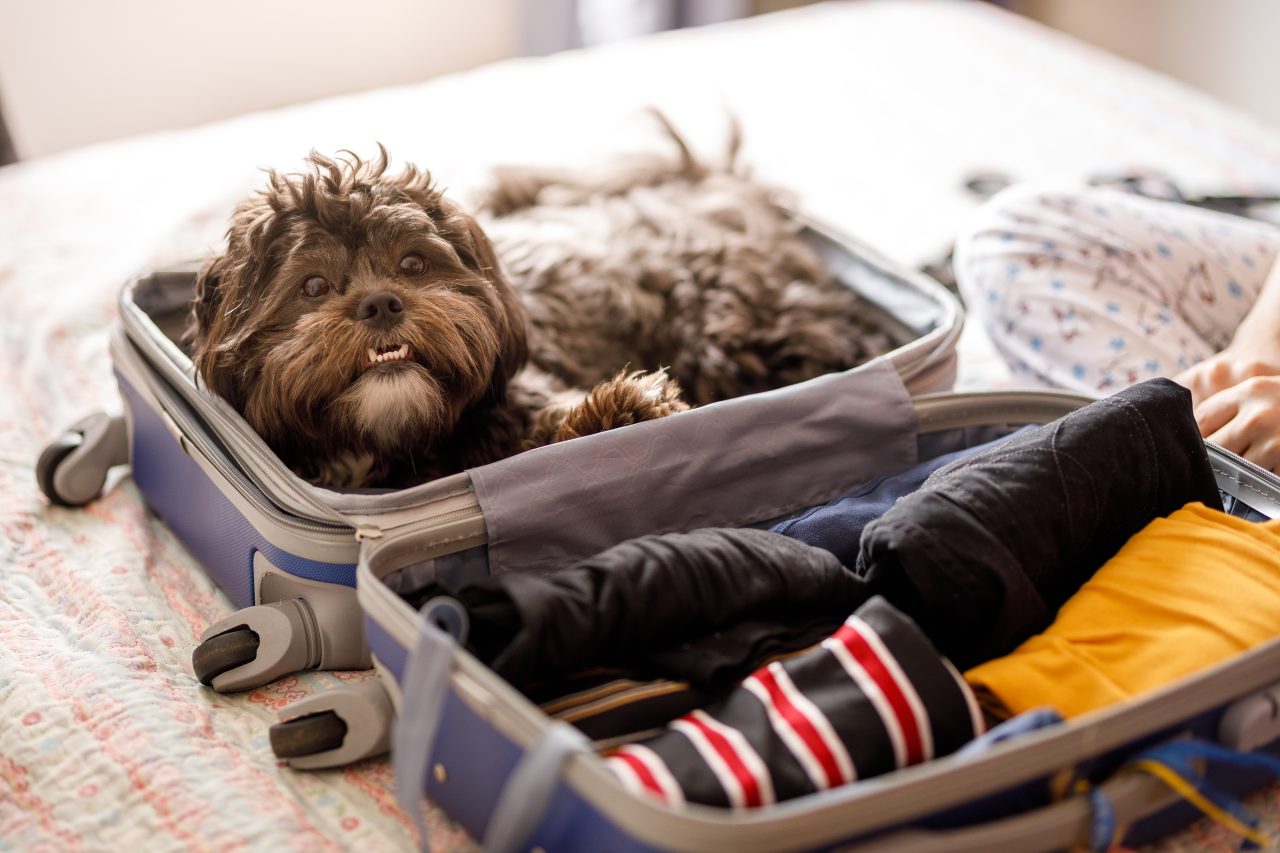
- How Much Does It Cost To Bring A Pet On An International Flight?
You’ll quickly see that there are a lot of variables when it comes to flying with animals. Flying with big dogs in the cabin domestically will be a completely different experience than traveling with a cat to Europe, and that extends to the prices you can expect to find.
Before we get into comparing the prices from some of the most popular airlines flying to European countries, it’s a good idea to consider whether your pet can join you in the cabin or if they’ll have to fly as cargo or checked baggage in the hold. Keep in mind that you may not be able to bring your pet on vacation at all, as some airlines only allow animals onboard if you’re flying with service dogs.
Let’s take a look at the fees for international travel with animals from a range of airlines, mostly relevant for anyone traveling with a dog on a plane or a cat.
Note: Pets flying as ‘checked baggage’ will travel in the hold on the same flight as you, while animals flying as ‘cargo’ may travel on a different plane to you. Airlines will usually try to ensure your pet reaches the final destination at a similar time to you, where possible.
- Can You Bring Pets To European Countries?
While many countries welcome pets, you’ll find that a significant number of them will only accept animals that have traveled in the hold. In other cases, your destination may permit you to bring particular pets, usually dogs and cats, into the country. However, flying with other animals, like reptiles or rodents, may be prohibited.
Many European nations will allow flying with your dog or cat in the cabin, but you may be transiting in a country with stricter regulations.
Some countries that only allow pets to fly in the hold include:
- New Zealand
- United Arab Emirates
- All countries within the United Kingdom
- What Countries in Europe Can My Pet Travel To?
Animal lovers can breathe a sigh of relief, as there are plenty of international dog-friendly and cat-friendly travel destinations in Europe. While it’s vital to do research specific to your final country, as well as any locations along the way if your itinerary includes stopovers, here are some popular countries that welcome pets without the need for quarantine. These are specifically related to dogs and cats.
- Most EU countries, including Germany, Italy, France, Spain, The Netherlands, Belgium, Croatia, Czechia, and Austria.
- Switzerland

- Pet-friendly adventures: traveling to Germany with your beloved companion.
- Italian escapade with your pet: explore the possibilities of travel.
- Pack your bags and paws: pet travel made easy to France.
- Wander Spain alongside your pet: unleash memorable journeys.
- Furry friend included: embark on a journey to the Netherlands with your pet.
- Experience Belgium together: unforgettable travel with your pet.
- Tail-wagging travels: navigate Croatia with your faithful pet.
- Pet-ready for Czechia: search for ultimate pet-friendly flights with your furry friend.
- From home to Austria: pet-friendly travel options await your journey.
- Embark on a pet-friendly journey: find flights for your furry friend to explore Switzerland
- Wings for paws: discover Norway — one of the best pet-friendly countries in Europe
- Furry companion’s adventure awaits: explore and book pet-friendly flights to Turkey
- What Airlines Allow Pets In The Cabin Internationally?
Here, we’ve broken down the airlines that allow pets on international flights to travel in the cabin, though this will sometimes change based on the connecting and final destinations, as some countries won’t permit pets to travel in the cabin even if the airline allows it. Animals traveling in the cabin must usually be small and fly in carriers that fit easily under the seat.
As a side note, while the United Kingdom is in Europe, it’s not in the EU and has many different regulations, which you can find here. As such, animals, except service dogs, can only travel in the hold when entering the U.K.
Below, you’ll find some pet-friendly airlines that fly to Europe and what animals they allow in the cabin.
U.S. Airlines:
- Delta – Dogs, cats, household birds
- United – Dogs, cats
European Airlines
- K.L.M – Dogs, cats (within Europe)
- Lufthansa – Dogs, cats
- Air France – Dogs, cats
Other International Airlines
- Air Canada – Dogs, cats
- Turkish Airlines – Dogs, cats, household birds
- What Documents Will I Need For Flying With My Pet To Europe?
After you’ve picked your holiday destination and airline, the next thing you’ll want to start thinking about is the documentation you need. In order to comply with the airline and country requirements, you should consider how to obtain a health certificate, if your destination imposes quarantine for animals, and what vaccines your pet needs.
We’ve put together all the must-know information about the documents you’ll need to help you get organized for your flight.
What Are Pet Health Certificates for International Travel?
Many countries have their own particular health certificate requirements, but you may find yourself visiting somewhere that doesn’t require a country-specific document.
If this is the case for you, getting a United States Department of Agriculture (USDA) International Health Certificate from a certified vet if flying from the U.S. is best. This will usually contain relevant information about your pet’s health and your contact details, confirming they’re safe to travel.
Check with your airline to see their health certificate requirements, as some airlines will ask for them to be dated no more than 10 days before the flight.
Are There Any Specific Health Certificates For Pet Travel I Should Use?
Pet owners traveling with their cat or dog to Europe, specifically to an EU country, will need to get an EU animal health certificate issued within 10 days before the animal enters the Union.
It’s helpful to know that non-EU European countries, such as Switzerland, will often accept this document too. However, if you’re traveling to a European country outside the EU, be sure to double-check that the EU health certificate is accepted.
What Do I Need To Know About International Health Certificates For Dogs?
Health certificates can vary depending on the animal, but let’s take a look at what an example of this document for a dog would contain and how to get one for your pup. You’ll need to make an appointment with a certified vet authorized to provide health certificates. It’s best to aim for a visit less than 10 days before your trip, but your destination and airline may have different time frames, so it’s a good idea to find out their requirements first.
When you’ve booked your dog in for their check-up, the vet will examine your pooch and determine whether it’s safe for them to travel. Dogs that are older, prone to certain illnesses, or in poor health may not be given the go-ahead from the vet, so it’s essential to be aware of this when planning your vacation.
If the vet is happy to let your pet travel, they’ll issue a health certificate filled with important information about your dog. This usually includes your dog’s age, breed, size, microchip number, and vaccination history, stating that your pet is free from disease and in good health. Completed health certificates will also include your contact details.
Do I Need Any Other Pet Travel Documents?
The most commonly required travel documents for your pet include:
- International health certificate
- Vaccination records (especially for rabies)
- Microchip (15-digit numbers are preferred in Europe)
While you may have three separate documents, all of this information is often contained in the health certificate, helping you cut down on the paperwork you’ll need to organize.
When animals travel on a separate plane to their owner, there are generally some additional documents to fill out, such as a written declaration that you’ve permitted another person or a transporting company to fly with your pet.
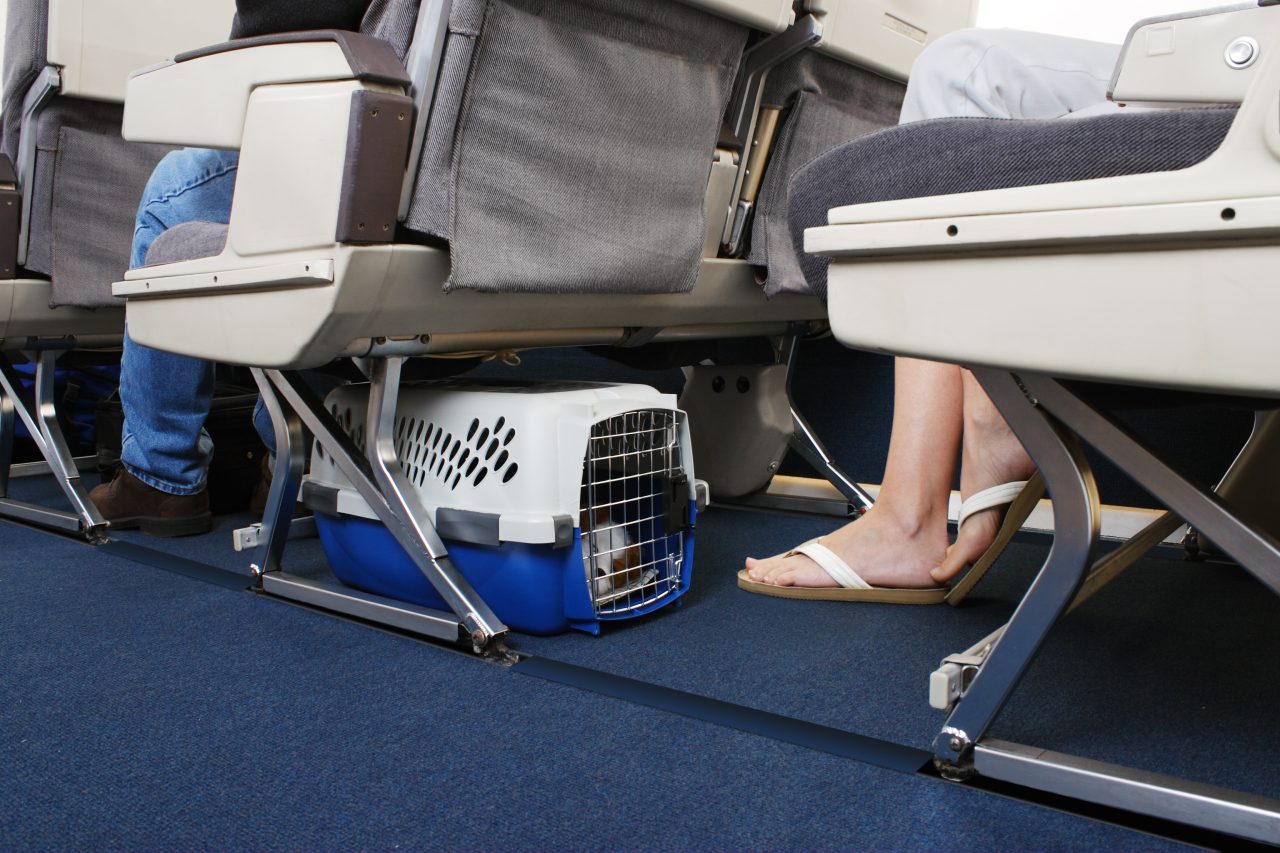
- Will My Pet Need To Be Quarantined In Europe?
Quarantine will surely be a concern for any pet owner, but there’s no need to worry about this when visiting Europe. Provided you have supplied the necessary documents, you’ll be able to reunite with your pet an hour or two after landing. After you’ve collected any checked baggage, you can go to an assigned section in the arrivals area and pick up your companion.
While this is true for dogs, cats, and ferrets, you’ll need to research country-specific regulations if flying with reptiles, birds, rabbits, and aquatic animals.
- What Vaccinations Will My Pet Need to Enter Europe?
There are a few vaccines and treatments that your pet must have before traveling to Europe, such as:
- Rabies: Dogs, cats, and ferrets must be fully vaccinated against rabies and have received their first shot at least 21 days before entering the EU.
- Rabies test: Dogs, cats, and ferrets entering the EU from certain countries must also undergo a blood test to check for rabies immunity. This includes European countries like Albania, Montenegro, and Serbia.
- Tapeworms: Dogs traveling to Ireland, Northern Ireland, Finland, Norway, or Malta must have anti-Echinococcus treatment before departure.
- Avian Influenza H5 and H7: Needed for birds entering the EU and administered no more than 60 days before travel.
What Is A Pet Passport, And Do I Need One For My Pet?
You’ll often hear the terms ‘pet passport’ and ‘animal health certificate’ used interchangeably, but they can mean different things.
Technically speaking, pet travel certificates are issued for single trips or within short periods. In the EU, these last for four months, provided you don’t leave and re-enter the Union. These permit pets to travel for a given number of days, but owners will need to get a new certificate for any additional trips once they’ve expired.
Pet passports are commonly used and issued in EU countries. Unlike health certificates, they don’t expire as long as they’re kept up-to-date with vaccine requirements. Though they’re accepted when flying between EU countries and other European destinations, like Switzerland, Iceland, and Monaco, they can’t be obtained or issued in the U.S. or U.K.
As a result, anyone flying from the United States or the United Kingdom to most European countries will require an animal health certificate rather than a pet passport.
Is It Possible To Get An International Pet Passport?
At present, there’s yet to be a standard international pet passport that’s widely accepted in most countries. EU pet passports are great to use if you reside in a member country or other select European countries, but these can’t be used elsewhere.
For this reason, animal health certificates continue to be the norm for most destinations.
- What Will I Need For Flying To Europe With A Pet From The U.S.?
To help you prepare for your visit to Europe from the U.S. with your pet, here’s a list of things you’ll need:
- A valid health certificate that states your pet is up-to-date with rabies vaccinations, fit to travel, and in good health.
- Once a certified vet completes the certificate, it must be sent to the USDA for approval and returned to you.
- Details of your pet’s microchip information (10-digit numbers are standard in the U.S. and are not accepted in the EU. You’ll need to get a 15-digit ISO-compatible microchip).
On a side note, if you need to change your pet’s microchip from a 10-digit to a 15-digit chip, it’s vital to know any vaccinations your pet received with the original chip will be invalid. This can be frustrating if you’re coming from the U.S., but knowing in advance can save you from taking your pet for additional rabies shots before getting a new microchip.
- What Should I Know Before Flying With Pets To France?
Although most regulations and requirements are standard amongst EU countries, there can be some variances between countries. Here are some things to be aware of when traveling to France with your pet :
- Pets can enter France in the cabin, as checked baggage or cargo.
- If arriving from a non-EU country by air, pets can only enter at Paris, Lyon, Toulouse, Marseille, Nice, or Reunion airports.
- Rabies vaccinations can’t be administered before puppies or kittens are 12 weeks old, meaning traveling to France with young animals may not be feasible.
- Mastiffs and pit bulls are prohibited. Other breeds, like rottweilers and Staffordshire terriers, can only enter France as guard dogs.
- Birds must be quarantined for 30 days before or 30 days after flying to France.
- Fly with your beloved pets to Paris .
- Book your pet-friendly adventure: explore Lyon getaways .
- Search for pet-friendly flights: Toulouse awaits .
- Discover new horizons: fly with pets to Marseille .
- Explore Nice: find flights to journey with your pet .
- What Should I Know Before Flying With Pets To Italy?
Another hugely popular European destination, Italy , has some of its own requirements for animals entering the country, such as:
- Pets like dogs, cats, and ferrets from non-EU countries can only enter Italy by air at Rome, Turin, Milan, Pisa, or Bologna airports.
- Pet birds can only fly to Rome or Milan Malpensa airports .
- Rottweilers are not allowed to travel to Italy.
- You can take up to five animals in total to Italy, including exotic pets like common reptiles and small turtles, as well as rodents and rabbits.
- Unleash adventures: book pet-friendly flights to Rome.
- Your furry friends deserve the best: fly to Turin with them .
- Unlock exploration: fly with your pets to Milan.
- Wings for wanderlust: discover pet-friendly flights to Pisa.
- Pets included: search for flights and explore Bologna together

- What Do I Need To Know About Flying With A Cat To Europe?
Much like flying with small dogs, taking a flight with a cat is considerably more straightforward than traveling with large dogs on planes. Unless you happened to be flying with an exceptionally huge cat, that is!
Cats are often some of the easiest pets to travel with, as you can take them into the cabin with you as long as your airline and destination permits it. In Europe, only a handful of countries prohibit pets in the cabin, such as those in the U.K.
Flying with your cat internationally should be pretty uncomplicated as long as you have completed all the necessary checks and paperwork.
- What Are The Rules For Flying With Emotional Support Pets To Europe?
Emotional support animals are subjected to the same rules as other pets for the most part. This means that, unlike trained service dogs, when you’re flying with therapy dogs, there’s no guarantee that they can travel in the cabin with you.
Your animal must meet the airline’s size, breed, and temperament requirements to fly in the cabin. As we’ve previously mentioned, some airlines and countries require all animals to travel in the hold, with the exception of service dogs.
Therefore, you must be aware of the criteria you must meet for your pet to travel with you. If an airline allows pets in the cabin, usually the animals must:
- Be a well-behaved cat or dog.
- Weigh less than 7-9kg.
- Comfortably fit in a soft or hard-sided carrier within specific dimensions that can be placed under the seat.
However, it’s worth getting in touch with different airlines, as some of them may have looser rules for flying with a large dog.
- What Are Some Other Tips For Flying With Pets To Europe?
Take a look at some of our other top tips to make your travel experience to Europe with your pet as smooth as possible!
- Start planning your trip earlier than you usually would. Giving yourself extra time will allow you to compare different airlines, read up on safety requirements, stock up on travel accessories, and plan when to take your pet for their health certificate check-up.
- Research the requirements of the European country you’re traveling to, particularly if it’s a country that’s not an EU member.
- Ensure your airline permits pets to fly to the country you’re visiting. For example, flying with dogs with JetBlue might be possible in the U.S., but they don’t allow animals on European routes, even if the final and connecting destinations welcome pets.
- Check that your destination is pet-friendly, as you could find that you can’t bring your furry friend into many businesses and spaces in some countries. Fortunately, most European countries are welcoming to pets, but it’s always best to do plenty of research.
- Book your flight early if possible, as many airlines cap the number of animals traveling per plane. Other airlines only allow you to add a pet to your booking within 14 days before departure.
- Try to stick to direct flights whenever possible. Connecting flights can make flying more stressful for you and your pet. The additional documentation, different protocols, new rules, and added fees associated with layovers can make connecting flights a logistical nightmare. Your pet will likely be faced with more unfamiliar faces and surroundings, too, so direct flights are best to minimize your four-legged friend’s anxieties.
- Begin crate training your pet a few months in advance, mainly if they’re not used to spending hours at a time in kennels or carriers. Make the crate a comfortable space where they feel inclined and safe to enter.
Want more interesting tips and information on traveling? Read more Kiwi.com articles!
- Introduction
- What Is A Pet Passport

Frequently asked questions
- Travel with kids
Breed Explorer
Choosing the right breed.
- Find Your Match Answer a few simple questions and find the right dog for you
- Compare Breeds Compare up to 5 different breeds side by side
- Find a Puppy Browse the AKC Marketplace to find the right puppy for you
Prospective Owners
- Choose Your Breed
- Why Get a Dog?
- Finding a Responsible Breeder
- Getting Started in Dog Sports
- All About Puppies
Additional Resources
- Find a Purebred Puppy
- Register Your Dog
- Find a Breed Club
- Most Popular Dog Breeds
- For Dog Breeders
- For Dog Owners

Browse By Topic
- Dog Dental Health
- Dog Nutrition
- Dog Training
- Travel & Adventure
- Life With Dogs
- Flea & Tick
- Senior Dog Health
- Dog Breeding
- All Categories
Tools & Quizzes
- Dog Name Finder Browse our extensive library of dog names for inspiration
- Can My Dog Eat____? Find out the best and worst foods for your dog and which to avoid
- AKC Magazines
- Newsletters
- Press Center
- AKC Detection Dog Task Force
- AKC Canine College
- Government Relations
- AKC Education
- AKC Library & Archives
- Shop By Breed
- Gifts for Dog Lovers
- Dog Supplies
- AKC Pro Shop
- DNA & Health Testing
- DNA Kit Activation
- Breeder Reports
- AKC Competitor Reports
- Register a Purebred Dog
- Register a Litter
- Enroll a Mixed-Breed Dog
- Registration Downloadable Forms
- Find a Puppy
- AKC Rescue Network
- PuppyVisor Search Counselor
- Breeder Referral Contacts
- Canine Good Citizen (CGC)
- GoodDog Helpline
- Find a Training Club
- Find a Dog Groomer
- AKC Pet Insurance
- AKC Reunite Microchips
- AKC Veterinary Network
- AKC S.A.F.E. Grooming Program
- Breeder Toolkit
- Breeder E-Z Reg
- Breeder Of Merit Program
- Bred With H.E.A.R.T Program
- Breeder Education
- Browse All Services
Featured Products
Video training consultations, getting started in dog sports.
- Intro to Dog Sports
- Canine Partners / Enroll Mixed Breed
- Titles & Abbreviations
- Which Sport Should You Do With Your Dog?
- Get Started in Dog Training
- Virtual Dog Sports & Events
Featured Events
- See Upcoming Events
- AKC National Tracking Invitational
- AKC National Championship
- AKC Agility Invitational
- Obedience Classic
- AKC Meet the Breeds
- AKC National Obedience Championship
- AKC Rally National Championship
Browse All Dog Sports
- Match Shows
- 4-6 Month Beginner Puppy
- Puppy of Achievement
- National Owner Handled Series
- FSS Open Show
- Public Service Dog
- Diving Dogs
- Search & Rescue
- Parent Club Title Recognition
- Field Events for Hounds
- Coursing, CAT & FAST CAT
- Herding & Farm Dog
- Pointing Breeds
- Spaniels & Flushing Breeds
- Junior Showmanship
- Juniors in Companion Events
- Juniors in Performance Events
- PeeWee Special Attractions
- CGC & AKC S.T.A.R. Puppy
- AKC Trick Dog
- AKC Therapy Dog
- AKC Fit Dog
- AKC Temperament Test
RESOURCES FOR DOG SPORT PARTICIPANTS
- Event Search
- Title Application Portal
- Downloadable Forms
- Rules & Regulations
- Online Event Management
- Points & Awards
- Judging Resource Center
- Judges Directory
- Judges Education - AKC Canine College
- AKC Weekly Winners
- Event Cancellations
- Award Corrections
- AKC Contact Info for All Sports
- AKC Registered Handler Program
- Junior Resources
- Cluster Coordination

Find a Club
- Search All AKC Clubs
- Find an Event
Clubs Offering:
- Training Classes
- How to Form a Dog Club
- About Club Relations
- Club Bylaw Services
- AKC Club Governance and Issues Resources
- Club Development Department
- Promote a Club
- Club Resources
- AKC Centennial Clubs
For Delegates
- Delegate Portal
- Delegate Directory & Search
- Delegate Meeting Dates
- Board Minutes
- Delegate Standing Committees
- Perspectives Newsletter
- AKC Gazette
- The Role of an AKC Delegate
- The Importance of Your AKC Delegate
- Government Relations Department
- Legislative Alerts
- AKC PAC and Legislative Support Fund
- Overview of Collections
- Breed Club Archives
- Search the Library Catalog
- How to Visit and/or Donate
- Expert Advice
International Dog Travel: How to Travel Abroad With Pets
- airline travel
- international
Traveling or moving to another country can require a lot of planning and effort. Depending on your destination, there are vaccinations, visas, and paperwork to contend with. And that’s just for the humans! If you take your dog with you on your travels or relocation, the necessary research and preparation are even greater. It’s not as simple as a pet passport. (Although read on for more information about that.)
The United States doesn’t determine the requirements for dog travel – each destination country has its own set of policies with respect to examinations and health tests, vaccinations, medical treatments, and paperwork. That means you need to be diligent when planning your trip and investigate what your dog needs for each country on your itinerary.
Getting Help With Dog Travel Requirements
The Animal and Plant Health Inspection Service (APHIS) of the United States Department of Agriculture (USDA) is a great resource for dog travel guidance. Their website lists helpful references and answers frequently asked questions . Their international pet travel checklist is a great place to start.

APHIS also offers a country-by-country listing of travel requirements. Because there are no worldwide regulations, this listing allows you to determine exactly what you need to do for each destination you plan to visit with your dog. For example, one country might require your dog to be microchipped whereas another might not. Or your dog might need tapeworm treatment for a certain country. Keep in mind that you should check these requirements every time you travel because they can change frequently.
You should also verify your research with the consulate or embassy of the country you plan to visit in order to ensure you haven’t missed anything. It’s your responsibility, not your veterinarian’s or travel agent’s, to make sure your pet has met every requirement of the new country. If you fail to meet the requirements, you might not get the necessary health certificate beforehand and will likely encounter problems when you arrive at your destination.
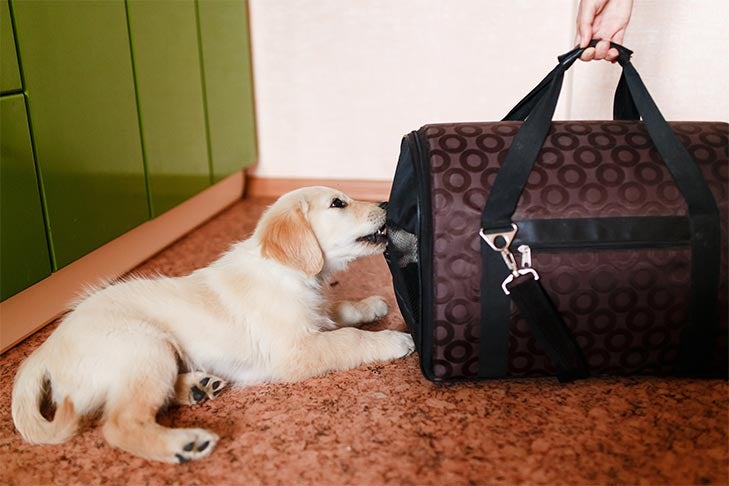
What is a Health Certificate for Dog Travel?
Most countries will need a health certificate for your dog before allowing entry. This paperwork is also known as an international health certificate, an export certificate , a veterinary certificate, or a veterinary health certificate. Regardless of the name, a health certificate is issued by your local veterinarian after he or she examines your dog and performs or verifies all the vaccinations, treatments, and testing required by the destination country. Your vet will need to fill in the certificate before signing and dating the document.
If you plan on visiting more than one country, note that your dog’s health certificate is not universally valid for all countries. Because each country has its own set of requirements, there is no one-size-fits-all standard certificate. Your dog will need a health certificate valid for the first destination country. Then the requirements for additional countries will depend on the mode of transportation, for example, car versus ship. The length of time your dog will be spending in each country may also be a factor. You are responsible for determining what is necessary at each border. For help with dog travel to multiple countries, contact your local APHIS Veterinary Services Endorsement Office .
Finally, the company transporting your dog , whether it’s an airline , cruise line, or pet shipping company, may have additional conditions above and beyond the health certificate for the destination country. For example, there may be crate and shipping requirements. Be sure to check with everyone involved in your dog’s travel to ensure you meet all requirements along the way. You don’t want to have your travel hit a snag before you even leave the United States.
APHIS Endorsement of Your Dog’s Health Certificate
Although not a condition for all destination countries, many also require the health certificate be endorsed by APHIS after the vet has completed his or her part of the paperwork. This is a final review process so APHIS officials can verify the accuracy of the health certificate and double check it meets the requirements of the destination country. You don’t have to take your dog to the APHIS office; however, APHIS will need the original health certificate as well as all supporting paperwork like test results and vaccination certificates. You can either mail your documents to your local APHIS Veterinary Services Endorsement Office or arrange for an in-person appointment. Be aware, there is a user fee for health certificate endorsement .
When APHIS endorsement is necessary, be aware that the vet who issues the health certificate in the first place must be USDA-Accredited. If your regular vet does not meet these standards, you will need to find a USDA-Accredited vet in your area before starting the process.
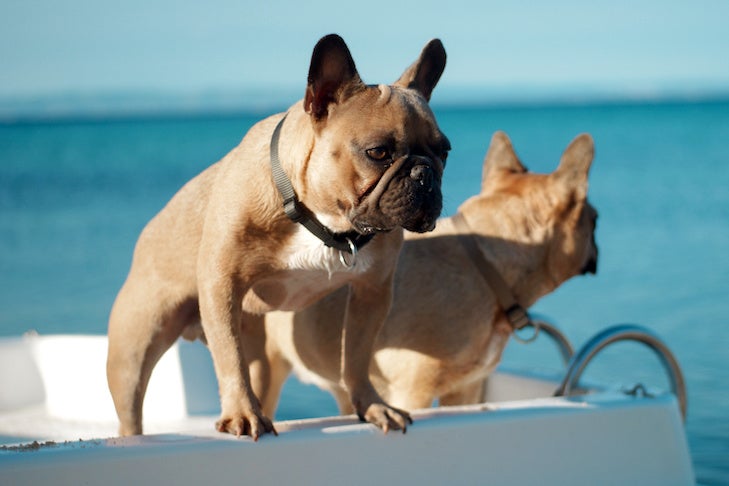
Veterinary Help With Dog Travel
Based on your research and consultation with your vet, you should know the necessary steps for completion of your dog’s health certificate. For example, does your dog need any vaccinations, treatments, or tests? Is a microchip required? You could be looking at multiple appointments to get everything taken care of. Therefore, it’s essential you leave enough time to get everything done. You might need to start planning many months in advance.
You also need to look at the time frame in the destination country’s regulations. For example, your dog might need to have his physical exam in a certain window of time before travel. Or vaccinations might need to be given so many weeks in advance. Some treatments can take time to take effect. All these factors mean you should meet with your vet to start the process as soon as you know your travel details.
Don’t forget about potential diseases and parasites that might be found in the destination country. There may be medications available to protect your dog, such as for heartworm. Although heartworm preventative is recommended year-round , even in the northern United States, many dog owners with snowy winters confine heartworm medication to the warmer months of summer. But depending on your destination country, you might need to consider a preventative regardless of the season. Do your research and consult with your veterinarian about any conditions your dog might be at risk for during your travels.
Be aware that most countries will need your vet’s original ink signature on the health certificate. But in this online world, it’s not surprising that APHIS has a digital system for health certificates as well. However, whether your vet can use the digital system is up to the destination country. To help clarify each country’s requirements, APHIS has developed a color-coding system on their country by country listings. For example, red means original ink from both the issuing vet and the APHIS official. This will be clearly explained on each country’s page, so when researching your destination country, keep an eye out for what exactly is needed on your dog’s certificate.

Pet Passports
Although some people might use the term pet passport to refer to any documentation that is required for dog travel, the European Union (EU) does issue an official Pet Passport . These documents are obtained from an official vet in any member country of the EU or any other designated country. The purpose is to simplify travel between countries in the EU. Note that you cannot obtain an EU Pet Passport in the United States.
Returning to the United States
When you bring your dog back to the U.S., you will have to meet the rules set out by the U.S. Centers for Disease Control and Prevention . First, all dogs must appear healthy before being allowed into the country. Second, a Rabies vaccine certificate may be needed depending on where your dog has been prior to arrival in the United States. There are no exceptions to these rules even if your dog is still a puppy, a service animal, or an emotional support dog. If you fail to follow these rules, your dog may be denied entry into the U.S.
Be aware that other government departments have their own additional requirements for bringing dogs into the U.S. For example, if your dog has been in a country where screwworm is known to exist, entry to the U.S. will only be allowed with a certificate signed within the last five days by a full-time veterinary official from the region of origin. The certificate must declare the dog free from screwworm or state the dog was treated until free of the disease. Finally, each state can have its own state regulations concerning dog travel, so check with your destination state’s State Department of Agriculture or the State Veterinarian’s Office to ensure you can bring your dog back home at the end of your travels.
Share a few contact details to get your FREE e-book
Moving with your pet
- Our Mission
- Our History
- Minutes & Reports
- Awards & Honors
- Board of Directors & Executive Officers
- Newsletter Subscriptions
Top Services +
- Dog Training Help
- Shop AKC Store
Top Resources +
- Delegates Portal
- Rules, Regulations & Policies
- Answer Center
- Judges' Directory
- Inspections & Compliance
- Working It Out℠ Guide & FAQs
- Active Shooter & Mass Attack Safety Resources
Get Involved +
- Attend a Dog Show
- Participate in an Event
- Donate to AKC
- Find a Dog Club
- AKC Humane Fund
Favorite Things +
- Watch Dog Shows
- Top 100 Girl Dog Names
- Top 100 Boy Dog Names
- Hypoallergenic Dog Breeds
- Why Do Dogs Eat Poop?
- Why Is My Dog Limping?
- How to Remove a Tick
- How to Potty Train a Puppy
- CBD Oil for Dogs
- Best Dog Podcast
- Best Calming Treats for Dogs
- Advertise With AKC
- Terms of Use
- Privacy & Cookies
- CA Privacy Rights
- Website Info & FAQs
- Linking Policy
- Material Reproduction Policy

The Man in Seat 61
How to travel into Europe
Taking your dog by train.
- Buy train tickets
- Buy ferry tickets
- Book a hotel
- Privacy & cookies
- Home
Train travel UK & Ireland...
Train travel in europe..., train travel in asia..., train travel in africa..., train travel in america..., train travel in australasia, how to take your dog by train.
This gets asked surprisingly often, as it's difficult and expensive to send dogs, cats or other pets by air, and pets find it very stressful alone in the hold of a plane. So why not take your dog by train or ferry, the civilised and comfortable option? Unfortunately Eurostar doesn't allow dogs on trains to/from London, except guide dogs. But there are alternatives - this page explains the options for civilised & enjoyable train & ferry travel between the UK and European destinations with your dog, cat or other pet.
Microchip, vaccinations, health certificate
Before you start, you'll need to make sure your dog or pet is fitted with a microchip and has an up-to-date rabies vaccination. Call your vet, they can advise you.
To take a pet from the UK to the EU , see your vet no more than 10 days before you travel for a simple health check and to get a health certificate. Expect this to cost £180 (yet another a Brexit cost as the UK is no longer a member of the Pet Passport scheme). The certificate is a 10-page document with more stamps than a 1970s Soviet transit visa which allows you to take your pet into the EU for up to 4 months and to re-enter the UK within 4 months. You can have more than one pet on the same health certificate. For certain countries you'll also need a tapeworm treatment, including Ireland, Northern Ireland, Norway, Finland & Malta.
A day or two before you return to the UK , make a vet's appointment. The vet gives your dog a tapeworm tablet and fills in/stamps the relevant section on the form. This must be done no less than 24 hours and no more than 120 hours (5 days) before you enter Great Britain. Expect this to cost around €40. This allows you to return to the UK.
For full details on how to take a pet abroad, see www.gov.uk/guidance/pet-travel-to-europe-after-brexit .
For full details on how to bring a pet into the UK, see www.defra.gov.uk/wildlife-pets/pets/travel .
Tip: As you can't take meat or dairy products into the EU, only take enough regular pet food for the Channel crossing. Take kibble for the onward journey, or stock up with wet food once on the Continent.
Step 1, taking a pet on British trains
This bit is easy. You can take dogs, cats and other small animals free of charge on all British trains, up to a maximum of two per passenger, as long as they don't endanger or inconvenience passengers or staff. Dogs must be kept on a lead unless inside a carrier. Dogs without leads, cats, birds and small animals must be carried in an enclosed cage or pet carrier which must be rigid and not open (to prevent escape) and the animal able to stand and lie down in comfort. Animals and containers must not occupy seats or a charge may be made. If you want to use a Caledonian Sleeper to or from Scotland, you'll need to pay a fee, see here . For full details of dog & pet regulations on British trains see www.nationalrail.co.uk/on-the-train/train-travel-with-pets . So far, so good.
Step 2, getting across the Channel
Option 1 , london to holland with stena line.
I highly recommend this option for both comfort and simplicity for travel with your dog between the UK and the Continent. It's an ideal route for the Netherlands, Germany, Austria, Poland, Czechia, Scandinavia and so on. It's a round-about route to France, Spain, Switzerland & Italy, but because it's so dog-friendly & inexpensive with really easy integrated train-to-ferry and ferry-to-train connections on either side of the Channel, it's a surprisingly good option even for that. It may also avoid the need for an overnight stay in Paris because after an overnight sailing to Hoek in a cosy pet-friendly cabin you can catch a morning high-speed train to Paris in time for an afternoon TGV to Barcelona, Switzerland or Milan.
What is Stena Line Rail & Sail?
Stena Line Rail & Sail is an integrated train & ferry service between London & the Netherlands run jointly by Greater Anglia & Stena Line. One ticket bought at www.stenaline.co.uk covers the whole journey from London or any East Anglia rail station to Hoek van Holland. It works in both directions, of course, but I'll describe the outward journey from the UK here.
You take the 18:45 train from London Liverpool Street station to Harwich and your dog travels with you on the train. At Harwich, the train arrives alongside the ferry terminal at around 20:45. It's totally painless: You walk straight off the train into the ferry terminal, through passport control (where your dog or cat's pet passport will be checked too) and onto the luxurious Stena Line superferry to Hoek van Holland.
You enter the ship via the passenger gangway onto Deck 7.
If you've booked a pet-friendly cabin , take your dog or cat by lift or stairs up to deck 10, where all the pet-friendly cabins are. All cabins have a shower, toilet, free WiFi and satellite TV. Your pet stays with you in the cabin, they are not allowed on the rest of the ship. If your pet needs a pee or poo, go down the Red Stairs to Deck 7 and press the white button to open a door to a small outside deck area where they can get some air, have a little exercise and do their business. Inevitably, we refer to this as the poop deck.
If you've booked a kennel , you take your dog up two decks by lift or stairs to the Guest Services desk on Deck 9, which is the main passenger deck with all the bars, lounges & restaurants. The Guest Services staff will give you a kennel number in either Kennel A or Kennel B, and give you the 4-digit code to access the kennels. You then go down one deck on Red Stairs to the kennels on Deck 8. The kennels have a sink with running water, and they provide blankets for dogs to sleep on, but you should take your own pet's water bowl, food bowl and perhaps their favourite toy. If your pet needs a pee or poo, go down one deck on the same Red Stairs to Deck 7 and press the white button to open a door to a small outside deck area where they can get some air, have a little exercise and do their business.
After settling your pet into their kennel you can settle in to your own private en suite cabin on Deck 10 or 11 and perhaps have a late dinner in the ship's restaurant or a nightcap in the bar on Deck 9. All cabins have a shower, toilet, free WiFi and satellite TV. Channel 6 on the TV shows CCTV pictures of the kennels, with close-ups of individual cages. You can visit your dog at any time during the crossing, although pets are not allowed in the public areas, other than to reach the Customer Services desk on embarkation, or to reach a pet-friendly cabin.
The ferry sails at 23:00 every day and arrives at Hoek van Holland at 08:00 next morning, Dutch time.
You now collect your dog from the kennels, if they need a pee you can take them to that small outside deck area on Deck 7. You then walk off the ferry into the terminal and out onto the adjacent railway station for the frequent metro train to Schiedam & Rotterdam. Dogs travel for free on the RET metro trains. You can use any contactless bank card to travel, just touch in and out at the start and end of the metro journey.
Get off the metro in Schiedam Centrum for a frequent NS (Dutch Railways) InterCity train to Amsterdam, arriving Amsterdam Centraal around 10:25. In the reverse direction, you'd leave Amsterdam Centraal around 18:46, the ferry sails from Hoek around 22:00 arriving Harwich at 06:30, you reach central London around 08:50.
Or continue to Eendrachtsplein station in Rotterdam city centre, from where it's then an 800m 10-minute walk to Rotterdam Centraal . Or continue to Rotterdam Alexander for NS trains to Utrecht, Groningen and so on.
You'll find full details, photos & a video guide on the Stena Line Rail & Sail page .
Onward trains to Germany, Austria, Switzerland, Italy, Eastern Europe etc...
Direct daytime trains link Amsterdam with Germany and Switzerland - in many cases these go via Utrecht, and changing at Utrecht saves going all the way into Amsterdam. Regular daytime trains link Rotterdam with Brussels and Paris. All of these trains take dogs, sometimes free, sometimes for a fee, sometimes with a child rate ticket.
Or take the Nightjet sleeper from Amsterdam to Basel, Zurich (change for Italy), Munich, Innsbruck or Vienna (change for Bratislava, Budapest, Zagreb). Dogs are carried on Nightjets for €29 paid on board the train, as long as you and your party occupy a whole compartment.
You'll find specific timetables for journeys between London and each of the following countries here: Belgium , Italy , Switzerland , Germany , Austria , Denmark , Hungary , Czech Republic & Poland .
Onward trains to Paris (for France, Switzerland, Spain, Italy)
Take the metro from Hoek van Holland to Eendrachtsplein station in Rotterdam city centre, dogs go free of charge on the metro. It's then an 800m 10-minute walk to Rotterdam Centraal .
Then take a Eurostar (formerly Thalys) high-speed train from Rotterdam Centraal to Paris Gare du Nord , you'll usually find a 10:58 arriving 13:38. Dogs can travel in any class on Eurostar (formerly Thalys) trains for €30, you pay the dog fee on board to the conductor. Book your own ticket from Rotterdam to Paris from €35 online in advance at www.sncf-connect.com (don't bother trying to add a dog to the booking, this doesn't work with Eurostar (formerly Thalys) .
How much does it cost?
You'll find specific fare & booking information for journeys between London and each of the following countries by clicking the relevant link: Netherlands , Belgium , Italy , Switzerland , Germany , Austria , Denmark , Hungary , Czech Republic & Poland .
...and to take a dog or cat?
On the train from London to Harwich your dog travels free. On the ferry, you must reserve a kennel (£23) or pet-friendly cabin during the online booking process. On the Dutch domestic trains between Hoek van Holland, Rotterdam & Amsterdam or Utrecht, small dogs or cats in containers on your lap travel free of charge, but if you have a larger dog you'll need to buy a dog day-ticket (Dagkaart Hond) for €3.30, you may be able to buy this at the Guest Services desk on deck 9 on board the Stena Line ferry, otherwise buy it at Schiedam station. On the international daytime trains from Amsterdam or Utrecht to Germany and Switzerland, cats and small dogs (up to cat sized) in containers go free, larger dogs on leads require a child rate ticket which you can buy online exactly as you would for a child, although unlike kids they don't qualify for the free kid with an adult deal.
How to buy tickets for you & your dog, step 1 :
Book your Rail & Sail ticket from London to Amsterdam online at www.stenaline.co.uk . You simply need to choose a pet-friendly (animal) cabin at the cabin stage plus the 'pet in cabin' option at the extras stage, or just add a pet in kennel at the extras stage.
How to buy tickets, step 2 :
You now need to book the onward trains to your European destination. Booking usually opens 90 days ahead, you cannot book before reservations open. Trains from Amsterdam to Cologne, Frankfurt and Switzerland pass through Utrecht so it's quicker to pick them up there rather than going all the way into Amsterdam, unless you really want to. For daytime travel from Amsterdam or Utrecht to Germany or Switzerland, book your own ticket at int.bahn.de . Small (cat-size) dogs & cats in containers go free, if you have a larger larger dog it travels at the child rate (either full-fare Flexpreis or discounted Sparpreis , it doesn't matter) so simply use int.bahn.de again to buy a child ticket, I recommend buying this as a separate booking to avoid the system automatically offering the 'Child under 15 accompanied by an adult goes free' offer which doesn't apply to dogs! There are Nightjet sleeper train from Cologne to Innsbruck (for Italy) & Vienna (for all points east) and you can easily book these online at int.bahn.de . Onward connections from Innsbruck to Italy or Vienna to Budapest can be booked at www.oebb.at .
Inward one-way tickets : Note that www.stenaline.co.uk can only book one-way or return tickets starting in the UK. One-way or return tickets starting in the Netherlands must be booked at the Dutch version of the Stena Line website, see the advice here .
Option 2, London to Paris via the Newhaven-Dieppe ferry
See the London/Brighton-Newhaven-Dieppe-Paris timetable on the London-Paris by train & ferry page . This is the cheapest option if you're heading for France or Spain.
Step 1, take a train to Newhaven Town , see www.nationalrail.co.uk for train times.
Up to 2 dogs of any size go free of charge on British trains, just buy a ticket for yourself.
Step 2, take a DFDS ferry from Newhaven to Dieppe , check ferry times at www.dfds.com .
DFDS allows you to take a cat or dog with you as a foot passenger on these routes.
Only small and medium size dogs are carried, according to DFDS customer services. That means I'd expect them to have no problem with springer spaniels, but they won't carry great Danes or St Bernards. You'll have to call them to check whether your labrador will fit their kennels.
If the animal is small and in a carrier, the pet & carrier are handed to staff at check-in and returned to you after the crossing. Larger dogs have to be booked in one of the ship's 3 kennels, although you can visit the pet in the middle of the crossing by taking an appointment at the reception desk.
To book as a foot passenger with a pet you must call DFDS on 033 058 787 87 if you're in the UK or 0809 541 890 if you're in France or +44 33 058 787 87 from outside either country. You cannot book online if you're taking a pet!
Step 3, take a French train from Dieppe to Paris St Lazare , book this at www.thetrainline.com .
Dogs can be taken on all French trains. Small dogs (under 6Kg) placed in containers not exceeding 45cm x 30cm x 25cm pay no more than €5.10 per journey. Larger dogs muzzled and on leads pay half the 2nd class full fare (even travelling in 1st class).
You can buy a ticket in English at the official French Railways website www.sncf-connect.com (for English scroll to the bottom and change France to Europe (other countries). You add a dog to the booking by clicking the Add button (English version) or Ajouter (French version) before running the enquiry.
Once in Paris, you can take onward trains to Spain, Portugal or the South of France, as shown in step 3 below.
Option 3, London to Paris by train + taxi with Pet Travel Abroad .
For France, Spain or Portugal you really need to go via Paris. As Eurostar won't take pets and most Channel Ferries won't let foot passengers take pets either, here is a solution which works well, although it's not cheap:
Step 1, travel from London to Folkestone by train.
You can use any normal British domestic train, dogs go free. There are hourly or half hourly trains from London Charing Cross, Waterloo East or St Pancras to Folkestone Central, check train times & fares at www.nationalrail.co.uk .
Step 2, book a taxi from Folkestone to Calais via the Eurotunnel shuttle with Pet Travel Abroad .
Book your trip by calling Pet Travel Abroad (part of Folkestone Taxis) on 01303 246 925 (+00 44 1303 246925 from outside the UK), see their pet transport page at pettravelabroad.co.uk .
They can take you and your dog and up to 3 other passengers from Folkestone Central station to Calais Ville or Calais Fréthun stations for around £190 plus the cost of the Eurotunnel ticket, typically £164, but this can vary.
You and your dog remain together in the taxi throughout the journey via the Channel Tunnel car shuttle train. Pet Travel Abroad (part of Folkestone Taxis) has been highly recommended by several travellers, further feedback is always appreciated.
Of course, a cheaper solution is to get a friend to drive you to Calais and drop you at the station, using a cheap day return ferry ticket - try www.dfds.com or www.poferries.com . The dog remains inside the car on the ferry car deck.
Step 3, take a French domestic train from Calais Ville or Calais Fréthun to Paris .
To check train times use www.raileurope.com (in £ or €) or www.thetrainline.com (in €). On French trains, small dogs under 6 Kg placed in containers not exceeding 45cm x 30cm x 25cm pay no more than €5.10 per journey. Larger dogs muzzled and on leads pay half the 2nd class full fare, even travelling in 1st class. For onward train travel with your dog to Spain, Italy, Portugal and so on, see the following section.
How to plan your trip.
The French trains from Calais to Paris are irregular and less frequent than the British ones, so start by picking a suitable afternoon train from Calais to Paris and work backwards. Ask Folkestone Taxis what time you need to leave Folkestone Central in their taxi to make this train. Then work out a train from London (or your local station) to Folkestone Central with plenty of time in hand.
This blog may inspire you: Argo, the dog who took the train to Italy .
Option 4, Hull-Rotterdam or Newcastle-Amsterdam by ferry
You can take a dog as a foot passenger on P&O Ferries Hull-Rotterdam route, with pet-friendly cabins & kennels. Book online and add a pet plus pet-friendly cabin or kennel at www.poferries.com . More about the Hull-Rotterdam ferry route .
You can also take a dog as a foot passenger with pet-friendly cabins on DFDS overnight Newcastle-Amsterdam ferry. However, you can't book online as a foot passenger with a pet, you need to book by phone, so check sailing times at www.dfds.com then call DFDS on 0871 522 9955. More about the Newcastle to Amsterdam ferry route .
Back to top
Step 3, taking pets on trains in mainland Europe
Once safely across the Channel, you can take a dog or cat with you on most trains across Europe, sometimes free, sometimes for a small charge, sometimes with a normal child-rate ticket. In sleeping-cars and couchettes on overnight trains, you can generally only take a dog if your party occupies all the berths in a compartment.
From the UK to France
Eurostar doesn't take dogs and nor do most ferry companies unless you are a motorist. P&O used to allow foot passengers to take dogs, but have stopped doing in 2012. However, DFDS will take caged pets if you're a foot passenger on their Newhaven-Dieppe route.
So either travel from London to Newhaven by train, take a DFDS ferry to Dieppe as a foot passenger with your pet in a cage as explained above in option 2 , take a taxi to Dieppe station and a train to Paris, or travel from London to Folkestone by train, pay Folkestone Taxis to shuttle you through the Tunnel from Folkestone Central station to Calais Ville station, then take a train to Paris as explained above in option 3 .
Or you can travel from the UK to Paris via Hoek van Holland using option 1 , it's a round-about route, but so easy, dog-friendly, inexpensive and avoids the need for an overnight stop in Paris as you can sail overnight from Harwich to Hoek van Holland in a cosy pet-friendly cabin, catch the metro to Rotterdam and a morning high-speed train to Paris, then take an afternoon train to almost anywhere in France, even Nice & the south coast.
Pets on trains within France
Dogs can be taken on all French trains. Small dogs (under 6 Kg) placed in containers not exceeding 45cm x 30cm x 25cm pay €7 per journey. Larger dogs muzzled and on a lead pay €7.
You can buy a ticket in English at the official French Railways website www.sncf-connect.com , you add a dog to your booking by clicking the Add travellers, pets & bicycles button before running the enquiry.
To the Netherlands
From the UK to the Netherlands
I recommend travelling via the Harwich-Hoek van Holland superferry as shown in option 1 above . Once at Hoek van Holland your Dutch Flyer ticket is valid to any Dutch station, not just Amsterdam. You can book from London to Amsterdam or any Dutch station online at www.stenaline.co.uk , adding a kennel during the booking process.
Alternatively, you can also take a dog as a foot passenger with pet-friendly cabins on DFDS overnight Newcastle-Amsterdam ferry, but you must book by phone, check sailing times at www.dfds.com then call 0871 522 9955. P&O take dogs with foot passengers on their overnight Hull-Rotterdam ferry, see www.poferries.com .
Pets on trains within the Netherlands
On Dutch trains, small dogs or cats in containers placed on your lap travel free of charge, if you have a larger dog on a lead you will need to buy a Dagkaart Hond (dog day-ticket) for just over €3. You can check details for this at the Dutch Railways site www.ns.nl .
To Switzerland
From the UK to Switzerland
You should use the train & ferry service from London to Amsterdam via the Harwich-Hoek van Holland ferry, as explained in option 1 above . For details of the London to Switzerland journey via this route see the Switzerland page , which has timetables & fares. You can book the London-Amsterdam part of the journey online at www.stenaline.co.uk , adding a reserved kennel during the booking process. You'll then find daytime trains from Utrecht to Basel & Zurich, which you can book online at int.bahn.de .
Pets on trains within Switzerland
Dogs of any size can travel for half the 2nd class fare on any Swiss train (for longer journeys there's a Dog Day card), small dogs up to 30cm high at the shoulder can travel free if they are in a carrier, you'll find information on the Swiss railways website www.sbb.ch and you can easily buy Swiss tickets at the station when you get there.
From the UK to Italy, via Hoek van Holland
Travel overnight from London to Hoek van Holland using the Harwich-Hoek van Holland ferry as explained in option 1 above .
I'd then suggest travelling from Amsterdam to Munich by daytime trains, then overnight again from Munich to Venice on the excellent Nightjet sleeper train. You'll find full details of these trains and how to book them in the via Harwich section of the London to Italy page .
Dogs travel on the German-run trains between Amsterdam, Cologne & Munich under the same arrangements as for trains within Germany explained in the To Germany section below .
Dogs are carried on the Nightjet sleeper from Cologne to Innsbruck or Vienna for €29, as long as you and your party occupy a whole compartment. You don't need to book the dog, you just pay the extra €29 to the staff on board the train.
First book the London-Amsterdam part of the journey online at www.stenaline.co.uk , adding a reserved kennel during the booking process.
Then book Amsterdam-Munich followed by Munich-Venice using www.thetrainline.com . Then buy a separate 2nd class child ticket for your dog from Amsterdam to Munich as explained in the To Germany section below .
Then travel onwards from Venice to other Italian cities. See the Pets on trains within Italy section below.
Alternatively, you can take daytime trains from Utrecht to Basel or Zurich, book these online at int.bahn.de . Stay overnight in Basel or Zurich. Then take a Zurich to Milan EuroCity train, which you can book online at www.sbb.ch . Dogs under 30cm high at the shoulder in a carrier travel free on this EuroCity train and on onward trains within Italy. Dogs over 30cm high and not in a carrier must have a ticket, usually charged at half the 2nd class fare, which you can buy at the station in Zurich for about £35.
From the UK to Italy, via Paris
Step 1, Eurostar doesn't take dogs, so travel from London to Paris via Folkestone/Newhaven & Paris using option 2 or option 3 above, both involving ferry or EuroTunnel to France then domestic French train to Paris. You may need to stay in Paris overnight. Or use option 1 via Hoek van Holland, it's a round-about route, but so easy, dog-friendly, inexpensive and avoids the need for an overnight stop in Paris.
Step 2, you can then take one of the three daily Paris-Turin-Milan TGV trains in 1st or 2nd class with any size of dog muzzled and on a lead for €20, or a small dog/cat in a pet carrier not exceeding 45cm x 30cm x 25cm for €7. You can book yourself and your dog from Paris to Milan at www.sncf-connect.com , look for the Add Travellers, animals, bicycles button and add a dog on a lead or in a carrier before running the enquiry.
Step 3, take an onward train from Milan or Turin to anywhere in Italy, see the Pets on trains within Italy section below.
Dogs are also carried on Trenitalia's competing Paris-Milan Frecciarossa , dogs under 5 Kg go free, dogs 5-50 Kg €30, all dogs must travel in Standard or Business class Allegro cars. See the London to Italy page for details of times, prices and how to buy tickets. The £10 fee for taking a dog on the Paris-Milan TGV must be paid by phone, it cannot be booked online.
Pets on trains within Italy
Dogs and pets are carried on most Trenitalia trains, free in a carrier (maximum size 70cm x 30cm x 50cm) or at half the 2nd class fare if on a lead and muzzled, for full details to www.trenitalia.com and look under Services for Transport of pets .
You'll need to carry the dog's pet passport or health certificate, and yes, you will need to use a muzzle if your dog isn't inside a carrier. You aren't allowed to take dogs on regional trains between 07:00 & 09:00 weekdays. You aren't allowed to take a dog in Premium or Executive classes on Frecciarossa high-speed trains . You can only take a dog in sleepers or couchettes if your party occupies the whole compartment.
From the UK to Barcelona, Madrid, Malaga, Valencia, Alicante...
Step 2, you can then take one of the twice-daily Paris-Barcelona TGV trains with any size of dog muzzled and on a lead on for €20, or a small dog/cat in a pet carrier not exceeding 45cm x 30cm x 25cm for €7. More about the Paris-Barcelona TGV journey .
You can buy a ticket for yourself and your dog from Paris to Barcelona at www.sncf-connect.com , look for the Add Travellers, animals, bicycles button and add a dog on a lead or in a carrier before running the enquiry.
Step 3 if your dog is under 10 Kg, you can then travel from Barcelona direct to Madrid, Malaga, Valencia or Alicante, see the Pets on trains within Spain section below.
Step 3 if your dog is 10-40 Kg, you can travel from Barcelona to Madrid on certain AVE trains, then from Madrid to Malaga, Valencia or Alicante also on certain trains only, see the Pets on trains within Spain section below.
From the UK to San Sebastian
Step 1, Eurostar doesn't take dogs, so travel from London to Paris via Folkestone/Newhaven & Paris using option 2 or option 3 above, both involving ferry or EuroTunnel to France then domestic French train to Paris. Or use option 1 via Hoek van Holland, it's a round-about route, but so easy, dog-friendly, inexpensive and avoids the need for an overnight stop in Paris.
Step 2, you can then take one of the regular TGVs from Paris Montparnasse to Hendaye on the Spanish border, a stone's throw from San Sebastian. These also take dogs of any size muzzled and on a lead for €20, or a small dog/cat in a pet carrier for €7.
You can buy a ticket for yourself and your dog from Paris to Hendaye at www.sncf-connect.com , look for the Add Travellers, animals, bicycles button and add a dog on a lead or in a carrier before running the enquiry.
Step 3, the half-hourly trains from Hendaye to San Sebastian run by Euskotren take dogs of any size, muzzled and on a lead, or in a pet carrier, buy that ticket when you get to Hendaye. More about the Paris-San Sebastian journey .
Pets on trains within Spain
Dogs under 10 Kg in pet carriers (maximum size 60cm x 35cm x 35cm) can be taken on most Renfe long distance trains either free or for a small fee, see www.renfe.com/es/en/viajar/informacion-util/mascotas (please let me know if that link stops working).
In general, larger dogs are not allowed at all on Spanish medium & long-distance trains . I gather this is a cultural thing, as large dogs are generally regarded as working animals (for example, guard dogs) not pets in Spain. Disappointingly, that not only goes for national operator Renfe, but for open-access competitors Ouigo and Iryo , too.
However, as from June 2023, dogs up to 40 Kg are allowed on certain Barcelona-Madrid, Madrid-Malaga, Madrid-Alicante & Madrid-Valencia AVE trains, for a fee, muzzled, with a 40-minute check-in and some forms to complete. See www.renfe.com/es/en/viajar/informacion-util/mascotas (please let me know if that link stops working). Dogs up to 40 Kg are only allowed 2 or 3 designated trains per day on each of those routes, there's a list of trains linked from that page. Feedback would be appreciated!
More about train travel in Spain . Buy Spanish train tickets with dog added at www.renfe.com .
To Portugal
From the UK to Portugal
Eurostar doesn't carry dogs, so first travel from London to Paris using either option 2 or option 3 above. You'll then need to stay overnight in Paris. Then travel from Paris to Lisbon as shown on the London to Portugal page .
They key issue is that dogs over 10 Kg aren't carried on trains beyond Madrid.
From the UK to Germany
Step 1, first travel from London to Amsterdam via the overnight Harwich-Hoek van Holland ferry, see option 1 above .
Step 2, check train times & buy tickets from Amsterdam Centraal to anywhere in Germany at int.bahn.de . On the German-run international IC & ICE trains between Amsterdam and Cologne, Frankfurt, Hannover & Berlin, the same arrangements apply as for German domestic travel explained below.
Alternatively, the overnight European Sleeper between Rotterdam/Amsterdam & Berlin takes dogs for free if you and your party occupy a whole couchette or sleeper compartment, see the European Sleeper page for more information .
Pets on trains within Germany & on international trains between Amsterdam & Germany
Small dogs & cats in containers go free. Larger dogs pay the child price.
You can buy tickets for you and your dog at int.bahn.de . Click the From field to open the details panel, click on Passengers, bicycles , click on Add , click on More passenger types and add a dog to the booking.
Dogs not in carriers must be on a lead and (in theory at least) muzzled. In practice you'll seldom see dogs muzzled). Dogs classed as 'dangerous breeds' aren't carried on trains in Germany.
To Austria , central & eastern Europe
From the UK to Austria & central Europe
I recommend travelling from London to Amsterdam via the overnight Harwich-Hoek van Holland ferry, see option 1 above . For details of a journey from London to various countries via this route, click the relevant destination link: Austria , Hungary , Czech Republic , Poland .
For Austria
Step 1, book the London-Amsterdam part of the journey online at www.stenaline.co.uk , adding a reserved kennel during the booking process.
Step 2, book a late afternoon train from Amsterdam Centraal to Cologne Hbf at int.bahn.de . On trains between Amsterdam and Cologne, small dogs and cats in containers go free, larger dogs pay the child rate, you can buy child tickets for your dog online at int.bahn.de , but do this as a separate booking from your own ticket to avoid the 'child under 15 accompanied by an adult goes free' offer which doesn't apply to dogs! Note that dogs classed as 'dangerous' breeds aren't carried on trains in Germany.
Step 3, then use www.oebb.at to book the Nightjet sleeper from Cologne Hbf to Munich Hbf , Innsbruck or Vienna Hbf . Change in Munich for Salzburg. Dogs are carried on the Nightjet sleeper from Cologne to Innsbruck or Vienna for €29 paid on board the train, as long as you and your party occupy a whole compartment.
Pets on trains within Austria
Small dogs (meaning cat-size) or cats in containers go free, larger dogs require a child ticket, which can be booked online at www.oebb.at .
For Hungary
Travel to Vienna as above. On onward trains from Vienna to Budapest, small dogs (meaning cat-size) or cats in containers go free, larger dogs require a child ticket, which can be booked online at www.oebb.at .
Dogs aren't allowed in MAV (Hungarian Railways) sleeping-cars or couchette cars at all, which rules out the Munich-Budapest and Zurich-Budapest sleeper trains.
To Denmark , Sweden, Norway
From the UK to Scandinavia
I recommend travelling from London to Amsterdam via the overnight Harwich-Hoek van Holland ferry, see option 1 above . For details of a journey from London to various countries via this route, click the relevant destination link: Denmark , Sweden , Norway , Finland .
Step 1, you can book the London-Amsterdam part of the journey online at www.stenaline.co.uk , adding a reserved kennel during the booking process.
Step 2, check train times & buy tickets from Amsterdam Centraal to Copenhagen at int.bahn.de . An overnight stop in Hamburg may be necessary.
On the German-run international trains between Amsterdam, Hamburg & Copenhagen, small dogs and cats in containers go free, larger dogs pay the child rate. You can buy child tickets for a larger dog online at int.bahn.de , although do this as a separate booking from your own ticket to avoid the child under 15 accompanied by an adult goes free offer which doesn't apply to dogs. Note that dogs classed as 'dangerous' breeds aren't carried on trains in Germany.
Step 3, dogs can go on the Copenhagen-Stockholm X2000 trains , but you can't take a pet in 1st class and you need to use the special pets allowed section of the train in 2nd class. You can reserve seats in this section when booking at www.sj.se or call their telesales line.
From the UK to Greece
Step 1, travel from London to Venice via Harwich-Hoek and Munich exactly as shown in the To Italy section above .
For more information
For information on the transport of dogs and other pets in particular countries, search the website of the relevant national train operator. There is a list of links to each operator's website on the useful links page .
Feedback requested!
Feedback from anyone who takes their dog or cat into Europe by train would be very welcome.
Traveller's reports
Dog owner Wendy Shillam reports : "We've been taking our dog abroad since the rules changed 9 years ago. Firstly I agree that its mad that Eurostar doesn't allow dogs, especially as it would be a good earner for them and they need the money! I wrote to the COE but got no reply. The most comfortable and quickest way for dogs to cross the channel (though not always the cheapest) is by car with Eurotunnel . They just stay in the car with you and there is no bother. Once, we then left our car at the Calais 'parkway' station, but on returning we saw that quite a few cars - not ours thank goodness - had been broken into. It is a very desolate spot and no security as far as I can see. But it is free parking. Once across the channel be careful which train you get from Calais - some especially on Sundays are really slow. We also have taken the motorail train from Düsseldorf, it's not too far and then you can get a car-carrying overnight train from Düsseldorf to Italy, the south of France or Austria . Dogs are accepted on these German motorail trains in the sleeper cabins and we have never had a problem. Our dog Astrid, a nine year old Mini Schnauzer, has lasted 17 hours on a train with no ill effects - overnight she just settles down to sleep, generally taking up most of my bunk! The steward will tell you if there are longer stops which allows you to give your dog a 'comfort' walk. The irony is that if we could travel on Eurostar we would never dream of taking our car with us at all! On Spanish trains dogs should be muzzled - the guard did let us get away with it, but if Astrid had been a bigger dog there might have been trouble. Also beware if you plan to travel with your dog by bus in Spain. They insist that the dog goes in a casket (which you have to bring) in the hold underneath the seats, which I suspect on a hot day is tantamount to animal cruelty! Astrid has been most comfortable and spoilt in France, Italy, Belgium and Sweden. Also remember that if you are going to the South dogs need to be protected against a nasty bug called lishmania which can cause a chronic disease with no cure - but drugs can control it. So always check with a vet who knows about foreign travel well before you go."
Back to home page
- Skip to content
- Skip to primary sidebar
- Skip to footer
Wet Nose Escapades
Learn how to travel with your dog
Traveling with Dogs on Trains in Europe: What to Know Before You Go
August 7, 2022
WOOF, thinking of traveling with your dog on trains in Europe? Keep the tail upright and sniff on!
Posted 8/5/22
In many European countries, you can wine and dine with your dog inside restaurants, hang out with your dog at pubs, and even shop for groceries with your dog. It’s no surprise that Europe has a much dog-friendlier culture than America. Taking your dog to the Colosseum in Rome or the Louvre in Paris often sounds like a far-fetched dream to many dog pawrents , but it doesn’t have to be complicated. Once you’re IN the E.U. ( sniff out my step-by-step guide HERE ), traveling throughout Europe with your dog is easier than you think.

The good news is that it’s SUPAW convenient to take your dog on most trains all over Europe. While not all trains in Europe are dog-friendly, most are. And, since most trains in Europe tend to accommodate furry passengers, traveling by train can be a fun, wanderlust experience for you and your dog. Not to bark , trains are much safer for larger dogs who must travel via cargo on planes. Plus, taking your dog on the train is not only less stressful, but also generally cheaper than air travel. Sniff out everything you MUST know before you go!
10 Tips on Traveling with Dogs on Trains in Europe
#1 Always bring your dog’s paperwork onboard , including the Vet Health Certificate or Pet Passport and any vaccination records. My humans like to keep both electronic and hard copies on them. I’ve always been surprised by how infrequently the train staff checks my paperwork, but having it handy is never a question, especially if you’re crossing borders.
#2 Do a short “test” train ride with your dog before committing to a longer journey. Just like flying, your dog’s first train ride should NOT be a 10-hour overnight train from Barcelona to Paris. Start slow with a quick 30-minute train ride to see how your dog fares with the motion before working up to a 2-hour train ride.
Like humans, dogs can experience motion sickness. This is especially the case for puppies who may not have their inner ears fully developed and experience imbalance. Symptoms include lip licking (when no food is in sight), whining, drooling, and vomiting. If this is a concern, be sure to discuss with your vet about remedies or prescribed medications like Cerenia for motion sickness.

#3 Break up a long journey so your dog can take breaks. For instance, if the trip is 6+ hours one-way, try making a quick stop after 3 hours. That way, your dog gets a breather and potty break. A few minutes of fresh air can work miracles!
#4 Get to the train station AT LEAST 30 minutes before departure , in case any issue arises with your dog’s admission. Be sure to purchase tickets online whenever possible to save time. A A BARK OF CAUTION: At the kiosks, you may often find suspicious people lurking around who will offer to “help” you in attempts to pickpocket or steal your change. GRRR. Ignore them or kindly decline their offer – BEWARE!
#5 Carry your dog on the escalators to avoid potential injury. Unless your dog is an expert escalator rider, it’s best to carry your dog up and down the escalators at the station.
#6 Find a quiet spot away from passengers and other dogs on the train, if pawssible . ARF, dogs are social creatures! Even though I would love to sniff out another furry passenger on the train, it’s pawbably best for the sake of other passengers to keep those barks low. While riding through the Alps, I sniffed out a Jack Russell fella sitting across from me and barked HELLO from inside my carrier.

And, he immediately barked back! We got out of our carriers to meet – WOOF, dog travel talk! Although our barks were minimal, nondisruptive, and did not generate any complaints, you should try to avoid sitting near another dog. In this situation, we had assigned seats so there wasn’t much we could do about it. However, if you’re on a train with unassigned seats, you should certainly try your best to find a more isolated spot.
#7 Don’t allow your dog to block the aisle on the train. ARF course, this applies to larger dogs who do not fit in a carrier. Keep the aisle clear by having your dog stay right next to you, as close as possible.
#8 Pack water, to-go bowls, food, and treats – keep them easily accessible inside your carry-on. Like in air travel, be strategic with food and water intake to balance feeding your dog and preventing accidents on the train. I usually recommend feeding a light meal at least 3 hours before heading to the train station to allow time for digestion and relief.

#9 Exhaust your dog’s energy before a train ride . Whether the train ride is 1 hour or 6 hours long, make sure your dog has peed, pooped, and exercised for a more comfortable journey. The more your dog can sleep throughout the train ride, the smoother the journey.
#10 Pack cleaning supplies for easy and quick clean-up, in case of accidents. ARF, ARF! My honest barks – I’ve never had an accident on any of the countless train rides I’ve set my furry paws on! BUT my human is always equipped with poop bags, paper towels, pee pads, dog wipes, and sanitizing wipes (for humans) – staying ready to clean up my mess without commotion.
#11 Bring a muzzle – most likely, you won’t need it if you’re traveling with a small dog, but it’s smart to have it handy if you have a large dog.
What to know BEFORE traveling with dogs on trains in Europe

#1 Dogs may not be allowed in certain carriages like first-class cars, dining cars, and sleeper cars, even if you have reserved a ticket for yourself.
#2 Eurostar, the main train that connects England and France, does NOT allow dogs unless they’re assistance or guide dogs. It often comes as a major shock and inconvenience to people trying to get their dogs into London from Paris or vice versa. The easiest way to get your dog into France or England is through the Eurotunnel, which starts at £22 per dog, each way.
#3 E.U. and U.K-recognized service dogs are always allowed to ride for FREE regardless of the size and do not need to follow carrier or muzzle rules. Keep in mind that U.S.A-defined service dogs are not recognized UNLESS they’ve been trained by an accredited organization.
#4 Dogs are not supposed to occupy a seat, no matter how small in size. However, in some countries like Italy and Spain, the enforcement seems more laxed. In the Netherlands, Austria, and Croatia, small dogs can sit on their human’s lap and don’t necessarily need to be inside a carrier.
#5 Small dogs can usually travel for free or a small fee like 7€, as long as they remain inside a carrier. Larger dogs must be muzzled and/or kept on a leash can travel for a reduced rate (e.g. 50% of the original fare).
A quick “BARK DOWN” of 8 Dog-Friendly Trains in Europe:

#1 CERCANíAS (Spain)
On RENFE (Spain’s national railway), dogs travel for FREE on all Cercanías trains. WOOF-HOO! There are currently no limitations on weight, and dogs do NOT need to travel in a crate or carrier as long as they’re on a lead. No tickets are needed for your furry traveler. ARF-mazing!
Now, barking about international routes , dogs can travel with their humans for only €15. However, dogs weighing more than 10 kg are NOT allowed on board. All dogs weighing 10 kg and under should be transported inside a crate or carrier (max dimensions: 60x35x35 cm). One dog per passenger.
#2 TRENITALIA (Italy)
Ciao! Small dogs like me can travel for FREE in both first and second class on all trains and in Executive, Business, Premium, and Standard service levels. AWOOO, the only catch is that they must remain inside a carrier with max dimensions 70x30x50 cm. Large dogs (of any size) are also allowed onboard – as long as they are muzzled and leashed. They are, however, prohibited during rush hour time of 7-9 am Mondays thru Fridays. Large dogs are also welcome on Espressi (Express), IC, ICN, Frecciabianca, Frecciarossa, and Frecciargento trains in both first and second class for a reduced ticket price of 50% of the original fare. One dog per passenger.

#3 SNCB (Belgium)
Dogs of all sizes are welcome on board via Pet Supplement ticket for only €3 one-way, which can be purchased online. Once again, it’s a small dog’s game here – small dogs like me can travel for FREE as long as we can fit in a basket, cage, or travel box no larger than 30x55x30 cm. Muzzling your dog is only “recommended,” but not required. 🙂
#4 Nederlandse Spoorwegen (Netherlands)
WOOF, small dogs can travel for FREE as long as they’re in a bag, basket, or able to sit on your lap. If you are traveling with a larger dog, you can purchase a “dog ticket” for €3.30 online. This “dog ticket” is mandatory for larger dogs and is only valid in domestic NS and Arriva trains. Large dogs must also be leashed.
#5 ÖBB (Austria)
As long as your dog is deemed “small and harmless” and can travel in carriers, he can travel for FREE on most lines. If your dog is larger in size and cannot be transported as hand luggage, then you must pay a fare, which varies based on the journey. You can get an estimate of your dog’s ticket online before booking. Your larger dog must also be muzzled and on a leash. Please confirm your travel plans before booking since their tickets are non-exchangeable and non-refundable.
#6 SNCF (France)
With a PAWSOME limit of TWO dogs per passenger, this French train is a blessing in the dog travel world. Again, dogs are allowed on all trains in France (including SNCF’s TGV, Intercités, and TER) except Eurostar. Both small dogs in a closed bag or basket and larger muzzled dogs are welcome on board. You must pay €7 for dogs weighing less than 6 kg and traveling in a bag or basket no larger than 45X30X25 cm. For dogs weighing more than 6 kg, you must pay 50% of the original fare as calculated using the standard rate per kilometer. Be sure to muzzle your larger dog and keep him by your feet (though not always enforced).

#7 National Rail (Great Britain)
Since you can take up to three items of personal luggage for FREE, you can take your dog on board for FREE if you don’t exceed the luggage allowance. If you’ve exceeded the luggage allowance, you must pay 50% of the adult fare of the journey. Dogs must either be kept inside a carrier OR on a leash and harness. On sleeper trains (Caledonian Sleeper), dogs can go onboard if you pay the heavy-duty cleaning charge. Like in France, two dogs per passenger are allowed.
#8 Hrvatske željeznice (Croatia)
Like on other trains in Europe, small dogs like me can travel on trains for FREE as long as they remain inside a carrier or transport box. Although there is no weight limit, they have a height limit of 30 cm (or 11.81 in). The good news is that a carrier or transport box is not needed if your dog is able to sit on their human’s lap (like in my case). As for dogs taller than 30 cm in height, they must be microchipped, leashed, muzzled, and travel with vaccination records/veterinary booklets. You must also purchase a discounted ticket at 50% at the cash register. On a sleeper coach, you must reserve and purchase a bed in the section for your dog (but your dog technically cannot touch the actual bed purchased. GRR). One dog per passenger.
WOOF, hope you enjoy sniffing out everything you need to know about traveling with dogs on trains in Europe! Be sure to share your dog traveling experience with me. BARK AT ME!
Markin’ it up,
Roger Wellington a.k.a. The Doob

Like my post on “Traveling with Dogs on Trains in Europe: What to Know Before You Go”? CLICK TO PIN!

Share this:
- Click to share on Facebook (Opens in new window)
- Click to share on Pinterest (Opens in new window)
- Click to share on Twitter (Opens in new window)
- Click to email a link to a friend (Opens in new window)
Love my barks? HERE ARE 2 EASY WAYS TO SHOW ME SUPPORT:

What’s Trending
- 20 BEST Human Foods for Yorkies
- How to STOP a Yorkie from Peeing in the House
- Flying Delta with a DOG: Everything You MUST Know Before You Go
- Taking Your Dog to Europe from Singapore
- Dog on a 10+ hour Flight: What to Expect
- How to Potty Train Your Dog WITHOUT a Crate
Amazon Affiliate Disclosure
Wet Nose Escapades is a participant in the Amazon Services LLC Associates Program, an affiliate advertising program designed to provide a means for website owners to earn advertising fees by advertising and linking to amazon.com, audible.com, and any other website that may be affiliated with Amazon Service LLC Associates Program. As an Amazon Associate, my humans and I earn a commission from qualifying purchases. Get more info on this website’s affiliate links here .
Let’s connect on social!
- View wetnoseescapades’s profile on Facebook
- View wetnoseescapade’s profile on Twitter
- View wetnoseescapades’s profile on Instagram
- View wetnoseescapades’s profile on Pinterest
- View UClmNVJhXEsxyjkhDhgajdkw?view_as=subscriber’s profile on YouTube
- View wetnoseescapades’s profile on Tumblr
You must be logged in to post a comment.

- Privacy Overview
- Strictly Necessary Cookies
- Cookie Policy
This website uses cookies so that we can provide you with the best user experience possible. Cookie information is stored in your browser and performs functions such as recognising you when you return to our website and helping our team to understand which sections of the website you find most interesting and useful.
Strictly Necessary Cookie should be enabled at all times so that we can save your preferences for cookie settings.
If you disable this cookie, we will not be able to save your preferences. This means that every time you visit this website you will need to enable or disable cookies again.
More information about our Cookie Policy

Advice for Travelling with a Dog in Europe
Click the country/region you are visiting on the map below for advice on parasites, diseases and recommended treatments when travelling with your dog. the information displayed on these pages only includes data from esccap member countries..
Please Note!
Generally, fleas, ticks, intestinal roundworms, Taenia and Dipylidium tapeworms and mites can be found throughout Europe therefore pet owners should protect their dog from the risks associated with these parasites. Check your dog regularly for parasites and carry a tick removal tool with you when you travel.
Ticks are widespread but different species of ticks, each bringing with it a separate risk of other infections, predominate in distinct areas of Europe, therefore advice will be provided as appropriate in each country.
- Netherlands
- Switzerland
- United Kingdom
Andora Regions
Click to view, austria regions, east austria, lower austria and vienna, portugal regions, central portugal, northern portugal, southern portugal, france regions, brittany & loire, north east & central france, south east france, south west france, spain regions, canary islands, central spain, north west spain, south eastern spain, italy regions, central italy, northern italy, southern italy, denmark regions, netherlands regions, groningen and drenthe, other dutch provinces, hungary regions, liechtenstein regions, liechtenstein, luxembourg regions, norway regions, mainland norway, germany regions, north eastern germany, north western germany, southern germany, ireland regions, north ireland, south ireland, belgium regions, northern belgium, southern belgium, poland regions, united kingdom regions, northern britain, southern britain, central britain, switzerland regions, other cantons, follow esccap.
- Get In Touch
- Tel: +44 (0)1684 585135
- Email: [email protected]
- ESCCAP Secretariat, Malvern Hills Science Park, Malvern, Worcestershire, WR14 3SZ United Kingdom
Registered Office Granta Lodge, 71 Graham Road Malvern, Worcestershire. WR14 2JS United Kingdom Registered in England and Wales ESCCAP Registration Number - 5821601
Browse our site
Session cookie.
We use a time limited cookie which is used to refer to information you enter into our website rather than storing that as less-secure cookie data. This expires after being inactive for a short time so the information is only stored briefly.
This is useful for facilities such as remembering form information so you do not have to re-enter everything if you make a mistake. This type of data is usually removed as soon as form submission is successful.
Google Analytics
This is a web analytics service provided by Google which sets cookies allowing us to see statistics of what visitors do on our website. Learn More About Google's Privacy | Opt-out of Google Analytics cookies
Google reCAPTCHA
This website uses reCAPTCHA for spam protection on our forms. Website visitors use of reCAPTCHA is subject to the Google Privacy Policy and Terms of Use .
Sharing and Social
There are no cookies used in providing the sharing buttons on this website. If you click through to these services they may use cookies or advertisements. EDAA opt-out program
Parasites & Diseases
Please consult your own veterinary professional at least one month before you travel. Treatment will vary depending on the age, health, breed, previous travel history and past vaccination record of your dog. Your veterinary professional will prescribe the appropriate products containing the necessary active ingredients for treatment prior to travel, during travel if necessary and upon your return.
Please note that generally fleas, ticks, intestinal roundworms, Taenia and Dipylidium tapeworms and mites can be found throughout Europe therefore you should protect your dog from the risks associated with these parasites. Check your dog regularly for parasites and carry a tick removal tool with you when you travel. It is also important to check for ticks when you return home.
You should make sure that you will be allowed to carry the necessary treatments with you when you travel as this may vary from country to country.
Please note that the information displayed on these pages only includes data from ESCCAP member countries.
GENERAL INFORMATION
The tick Dermacentor reticulatus is prevalent in the east of Austria and spreading throughout the country. This tick transmits the dog parasite Babesia canis .
There are no sandflies in Austria and whilst there are mosquitoes they do not transmit parasites. As there are no sandflies in Austria there is also no leishmaniosis.
Tapeworms are present throughout the whole country.
Echinococcus multilocularis
Endemic in central and eastern Europe.
Final hosts are foxes, dogs, raccoon dogs and cats, after ingestion of larval stages in intermediate hosts (mainly rodents). Dogs should be prevented from having access to raw offal and carcases. Pre-patent period is 28 days and patent period can be for several months.
Asymptomatic.
Morphology and size of proglottids on faecal samples. Egg detection with flotation, sedimentation or combined techniques (not very sensitive and Taenia -type eggs cannot be differentiated morphologically). Coproantigen detection enables detection of pre-patent infections 10 days p.i. with a sensitivity of more than 90% if more than 50 worms are present, lower if less than 50 worms are present. PCR/sequencing allows species identification (from isolated eggs or proglottids).
Red foxes, raccoon dogs and rarely dogs and cats may excrete eggs of Echinococcus multilocularis in faeces. The accidental oral consumption of E. multilocularis eggs causes alveolar echinococcosis in humans, which if untreated has potentially fatal consequences and this is therefore of major public health concern. Infection with eggs results in the formation of cysts also in animals such as pigs, horses and dogs.
VECTOR-BORNE DISEASES
Babesia canis, anaplasmosis.
Further information on pet travel can be found on the Austrian Federal Office for Consumer Health website .
Dirofilaria immitis
Portugal, Spain, South of France, Italy, Greece, Croatia, Bosnia, Czech Republic, Turkey, Hungary, Bulgaria and Romania.
Final hosts are dogs, cats and other carnivores. Rarely occurs in cats. L3 stage larvae are transmitted by mosquito vectors (intermediate host). Cutaneous infection. In dogs, pre-patent period is 4–6 months, patent period is several years. In cats, pre-patent period is approximately 8 months.
Low worm burden often asymptomatic. Infections with D.immitis may cause a severe and potentially fatal disease in dogs and cats. First clinical manifestation 5–7 months after infection: loss of condition, dyspnoea, cough. Chronic disease: cough, tachycardia, "Caval syndrome", tachypnoea. See GL5: Control of Vector-borne Diseases in Dogs and Cats.
Detection of microfilaria earliest 6 months after infection in dogs. For cats, detection of microfilaria from 8 months p.i. may be negative as levels can be very low. Detection improved by concentration of microfilaria with Difil Test or Knott’s Test. Microfilariae can be speciated using morphological, biochemical or molecular species identification in specialised laboratories only. Circulating antigens are detected from 5 months after infection with a sensitivity around 90% and approximately 100% if one female worm or more are present, respectively.
D. immitis is a zoonotic parasite, however human infection is rare.
SUBCUTANEOUS WORMS, OESOPHAGEAL WORMS
Dirofilaria repens.
Spain, South of France, Italy, Greece, Croatia, Bosnia, Czech Republic, Turkey and Hungary.
Final hosts are dogs, cats and other carnivores. L3 larvae are transmitted by mosquito vector (intermediate host). Cutaneous infection. Pre-patent period is 27–34 weeks, patent period – several years.
Mostly asymptomatic, very rarely modules or other cutaneous lesions.
Requires 2–4 ml EDTA blood. Detection of microfilariae from 6.2 months post infection. Detection improved by concentration of microfilariae with Difil Test or Knott’s Test. Microfilariae can be speciated using morphological, biochemical or molecular species identification by the use of specialised laboratories.
Yes, usually manifests itself in humans as a single subcutaneous nodule or a single worm in the conjuctiva.
Thelazia callipaeda
Italy, France (Dordogne) and southern Switzerland.
Dogs and cats probably via a dipteran arthropod vector. Pre-patent period about 3 weeks and patent period of months to years.
Blepharospasm and epiphora.
By detection of adult or larval stages from samples of the tear film from the surface of the conjunctiva.
Ixodidae or hard ticks are endemic throughout almost all of Europe, and there are more than 12 different species with varying biology and geographical distribution. Commonly found ticks are Ixodes ricinus , Rhipicephalus sanguineus and Dermacentor reticulatus . The main importance of ticks is their role as vectors of pathogenic agents which cause a range of tick-borne diseases (TBDs). Tick-borne diseases are detailed in ESCCAP Guideline 5: Control of Vector-borne diseases in Dogs and Cats.
Dermacentor reticulatus
Prevalent in the east of Austria.
Europe, from the Atlantic coast to Kazakhstan. Vector in dogs for Babesia canis.
Ticks are white with variegated brown splashes. Adult females are 3.8–4.2 mm unfed and 10 mm when engorged.
The Azores are a low risk for canine vector borne diseases (CVBD). The risk of CVBD increases from north to south reflecting climatic and seasonal changes.
Note that the period of higher infection rates from CVBD starts in March and ends in October/November with the peak season from June/July to September. Be aware that these periods can vary considerably from the north to the south of the country, making it possible for year round transmission.
Note that there are scarce data relating to the Azores and it is possible that endo and ectoparasites from mainland Portugal are present including tapeworms, roundworms and enteric protozoans.
Further information about pet travel can be found on Portugal's National Authority for Animal Health website .
Central Portugal is considered a high risk for canine vector borne diseases (CVBD). The risk of CVBD increases from north to south reflecting climatic and seasonal changes.
A wide range of gastrointestinal parasites are found in Portugal. Special attention should be taken to control tapeworms, especially Echinococus granulosus , in the central and southern areas of the country.
Rhipicephalus sanguineus and Ixodes ricinus are found throughout the country.
Rhipicephalus sanguineus
Primarily a tick of southern Europe and warmer climates. More prevalent during spring and summer but may feed all year round. In northern European countries R. sanguineus will not normally survive outdoors but may complete its life cycle inside kennels and houses.
On dogs the tick is often found in the ears and between the toes. Immature stages prefer the hair of the neck.
These ticks are yellow, reddish or blackish brown in colour. Size is highly variable and the engorged females can be 12 mm in length.
Ixodes ricinus
A three-host tick widely distributed in Europe except in northern Scandinavia.
Can be found all over the body but the main predilection sites are the non-hairy and thin-skinned areas such as the face, ears, axillae, interdigital, inguinal and perineal regions. Heavy infestations may lead to anaemia. The tick bite wound may become infected or a micro abscess may develop as a reaction to the mouthparts if the tick is forcibly removed leaving the mouthparts embedded in the skin. Attached engorged female ticks measuring up to 1 cm long are easily seen.
Usually by identifying the tick on the animal. It is more difficult to detect the small larval and nymphal stages than the males (rarely found in the case of Ixodes ) and the engorged adult females. Females can increase their weight up to 120 times as they engorge with blood prior to egg laying; when fully engorged a female tick can measure around 1 cm long and appears like a small bean hence their being called the "castor bean tick". There are different names in different countries.
Leishmaniosis
Dirofilariosis, ehrlichiosis, rickettsiosis, borreliosis (lyme disease).
Further information about pet travel can be found on Portugal's General Directorate of Food and Veterinary Medicine website .
Northern Portugal is considered a medium risk for canine vector borne diseases (CVBD). The risk of CVBD increases from north to south reflecting climatic and seasonal changes.
A wide range of gastrointestinal parasites are found in Portugal and special attention should be taken to control tapeworms.
Southern Portugal is considered a very high risk for canine vector borne diseases (CVBD). The risk of CVBD increases from north to south reflecting climatic and seasonal changes.
Note that there are scarce data relating to Madeira and it is possible that endo and ectoparasites from mainland Portugal are present including tapeworms, roundworms and enteric protozoans.
Angiostrongylus vasorum
Everywhere in endemic foci.
Final hosts are foxes and dogs. Infective larvae are ingested within molluscs or paratenic host. Pre-patent period 40–49 days, patent period up to 5 years.
After an asymptomatic period, respiratory signs such as cough, tachypnoea and dyspnoea are most obvious. Occasionally signs of coagulopathy (e.g. subcutaneous haematomas anaemia) and neurological signs are observed. Sudden death can occur even in the absence of respiratory signs.
Detection of live larvae from at least 4 g fresh faeces using the Baermann method, or microscopic detection of larvae in bronchial lavage material. A commercial serological test to detect circulating A. vasorum is now available.
Crenosoma vulpis
Focal geographical occurrence
Everywhere in Europe.
Final hosts are dogs and foxes and infection is orally from larvae within mollusc or paratenic host. Pre-patent period is 3 weeks, patent period is up to 10 months.
Respiratory symptoms, coughing and possibly exercise intolerance.
Detection of live larvae from at least 4 g fresh faeces or bronchial lavage fluid by Baermann method or microscopic detection in bronchial lavage material.
A three-host tick widely distributed in France (except in the south east). Vector in dogs for Borrelia burgdorferi (sensu lato) .
Echinococcus granulosus
Widespread in Europe.
Final hosts are dogs and rarely red foxes. Intermediate hosts are domestic ruminants, primates and humans.
Asymptomatic in dogs. Infections in cattle, sheep and pigs do not show clinical signs.
Difficult as the adult tapeworm segments are sparsely shed and small. Identification is based on size (2.0–3.0 mm), ovoid in shape with a single genital pore.
Yes, one or both lungs can be affected in the human intermediate host. If in the liver, several hydatids may give rise to gross abdominal distention. If a cyst ruptures, there is risk of death from anaphylaxis.
Taenia spp.
Dogs, cats and foxes after ingestion of larval stages in the intermediate host (cysticercus or coenurus). After a pre-patent period of 4–10 weeks and for a patent period from months to several years.
Asymptomatic except sometimes segments or proglottids are seen.
Egg detection by flotation of eggs from 3–5 g fresh or fixed faeces. Proglottids in faeces grossly visible. Taenia -type eggs in faeces (see Echinococcus for method of distinguishing Taenia- type eggs).
Transmitted by fruitflies ( Phortica variegata ). A highly endemic foci in the centre of the Dordogne administrative department.
Transmitted by ticks ( Dermacentor reticulatus ). May be highly endemic in foci of south west France.
For ticks like Dermacentor reticulatus , there are usually two peaks of activity, one from March to June and a second from September to October. In the case of alveolar echinococcidiosis, dogs (and cats) are infested when they capture small rodents and there are no seasonal variations.
ASCARIDS (Roundworms)
Toxocara canis.
Final hosts are dogs and foxes and the route of infection via ingestion of embryonated eggs from soil or on fur. Larvae in milk or paratenic hosts. In utero from dam. Pre-patent period is variable, typically 21 days after prenatal infection; 27–35 days after lactogenic infection; 32–39 days after ingestion of eggs. Patent period 4–6 months except where immunity intervenes for example in pups.
Low burden asymptomatic, higher burden may appear as cachexia and pot-bellied appearance in pups. Heavy infection can cause intestinal blockage or intussusception. A low burden in older animals is unlikely to cause clinical signs.
Egg detection by flotation from 3–5 g fresh or fixed faeces. Coproantigen assays detect infections from immature and adult worms, and are not linked to egg production. This enables identification of infections during pre-patent periods and alleviates challenges of intermittent egg shedding associated with microscopic examinations.
Yes, children at greatest risk through ingesting soil bearing contaminated eggs.
A three-host tick widely distributed in France (except in the south east). Vector in dogs for Borrelia burgdorferi (sensu lato) .
Ticks, sandflies and mosquitoes are prevalent throughout south east France.
A three-host tick and an important vector of Babesia vogeli , Ehrlichia canis , Anaplasma platys and Hepatozoon canis .
Leishmania infantum
Transmitted by sandflies which are present throughout the south east of France up to 600 metres above sea level in both urban and rural environments.
Transmitted by mosquitoes, including the tiger mosquito ( Aedes albopictus ).
Hepatozoonosis
Transmitted by the ingestion of ticks ( Rhipicephalus sanguineus ).
Transmitted by ticks ( Dermacentor reticulatus ). May be highly endemic in foci of south west France.
Ticks are found throughout Spain, active all year in the Canary Islands.
Mosquitoes are more abundant in areas of standing water and more active at dawn and dusk when exercising your dog should be avoided. Containers holding water indoors and outdoors are where females lay their eggs so ensure water in dog bowls is not allowed to stagnate. In the Canary Islands they are active all year round. Keep your dog indoors during dusk and dawn over the risk periods outlined above.
The transmission season of heartworm infection generally lasts all year round.
Further information about pet travel can be found on Spain's Ministry of Agriculture, Food and Environment website .
Ticks are found throughout Spain, most active in April to October in central Spain.
Sandflies are present in central Spain and the seasonal variation for greatest activity is from April to November.
Mosquitoes are more abundant in areas of standing water and more active at dawn and dusk when exercising your dog should be avoided. Containers holding water indoors and outdoors are where females lay their eggs so ensure water in dog bowls is not allowed to stagnate. In central Spain they are most active from April to November. Keep your dog indoors during dusk and dawn over the risk periods outlined above.
The transmission season of heartworm infection generally lasts from April to November.
Further information about pet travel can be found on Spain's Ministry of Agriculture, Fisheries and Food website .
Ticks are found throughout Spain, active in the autumn and spring in northwestern Spain.
Sandflies are present in northwestern Spain and the seasonal variation for greatest activity is from June to October.
Mosquitoes are more abundant in areas of standing water and more active at dawn and dusk when exercising your dog should be avoided. Containers holding water indoors and outdoors are where females lay their eggs so ensure water in dog bowls is not allowed to stagnate. In northwestern Spain they are most active from June to October. Keep your dog indoors during dusk and dawn over the risk periods outlined above.
Ticks are found throughout Spain, most active in April to October in southeastern Spain.
Sandflies are present in southeastern Spain and are active all year.
Mosquitoes are more abundant in areas of standing water and more active at dawn and dusk when exercising your dog should be avoided. Containers holding water indoors and outdoors are where females lay their eggs so ensure water in dog bowls is not allowed to stagnate. In southeastern Spain they are active all year round. Keep your dog indoors during dusk and dawn over the risk periods outlined above.
Ticks, sandflies and mosquitoes are prevalent throughout Italy.
Highly endemic regions include the central Italian region of LAZIO
Transmitted by sandflies which are present throughout Italy up to 600 metres above sea level in both urban and rural environments.
The tiger mosquito ( Aedes albopictus ) which transmits Dirofilaria is active throughout the year in ROME both day and night.
Further information on pet travel can be found on the Italian Ministry of Health website .
Ticks, sandflies and mosquitoes are prevalent throughout Italy. Deer ticks and sheep ticks are prevalent in the north.
Found in the far north of Italy near the border with Austria particularly the TRENTINO-ALTO ADIGE region. The tapeworm is transmitted by dogs and is extremely dangerous to humans.
Further information on pet travel can be found on the Italian Ministry of Health website .
More prevalent in the south of the country. Noted and highly endemic regions include SARDINIA, SICILY, CAMPANIA, BASILICATA and CALABRIA.
Echinococcus multilocularis has been found in the very northeast of the country in Groningen and Drenthe.
Further information on pet travel can be found on the following websites:
https://www.nvwa.nl/onderwerpen/huisdieren-en-reizen
https://www.licg.nl/invoereisen-per-land-europa/
https://www.government.nl/topics/animal-welfare/question-and-answer/can-i-bring-a-pet-from-another-country-to-the-netherlands
Prevalent in the south of Holland in the province of Limburg.
Occurs in foxes near the border with Austria and in the northern part of the country.
Extremely dangerous to humans.
Mosquito species carrying Dirofilaria immitis have been recorded. In Hungary this filarioid worm occurs rarely in certain areas, mainly along the Tisza river in the eastern part of the country.
Mosquito species carrying Dirofilaria repens have been recorded. In Hungary the filarioid worm is frequent.
Bartonellosis
Further information on pet travel can be found on the Hungarian National Food Chain Safety Agency website .
Further information on pet travel can be found on Luxembourg's government website .
Mainland Norway is currently considered free of rabies and Echinoccocus multilocularis .
In Western Norway in particular Ixodes ricinus is a problem but is not currently widely recognised as a vector for Babesiosis.
The Norwegian food safety authority has more information in English and Norwegian:
http://www.mattilsynet.no/language/english/animals/travelling_with_pets/
Both rabies and Echinoccocus multilocularis are established on the island.
Ixodes spp have peak activity in late spring and autumn
Has been shown to be mainly present in southern, south western and some north eastern areas as shown on the map
Further information about pet travel can be found on Germany's Federal Ministry of Food and Agriculture website .
Ticks occur throughout Germany.
Ixodes sps have peak activity in late spring and autumn
Has been shown to be mainly present in southern, south western and some north eastern areas as shown on the map
Echinococcus granulosus and E. multilocularis absent in Ireland.
Focal geographic incidence most cases reported from the East coast region
Ixodes spp endemic. Ticks are most active during late spring and autumn. Avoid high-risk areas such as forests and animal carcases. Regular tick treatments required and check for ticks at times of peak activity.
Praziquantel treatment is compulsory 1–5 days before entering the UK. Further information on pet travel (including parasites) can be found on the on the Department of Agriculture, Agriculture and Rural Affairs website or on the ESCCAP UK & Ireland website .
Ticks Endemic. Avoid forested areas and animal carcases. Prevalence of ticks is higher in southern counties. Regular tick treatments required and check for ticks at times of peak activity.
Praziquantel treatment is compulsory 1–5 days before entering Ireland. Further information about pet travel can be found on the Republic of Ireland's Department of Agriculture, Food and the Marine's website or on the ESCCAP UK & Ireland website .
Further information on pet travel can be found on Belgium's Federal Public Services website .
Poland is subject to all Central European parasites.
Ticks associated with babesiosis, anaplasmosis and boreliosis are present throughout Poland. Tick activity is greatest from spring to late autumn.
Mosquitoe species carrying Dirofilaria repens are recorded
Further information on pet travel can be found on the Polish Veterinary Inspection Service website .
Ticks are active in the spring and autumn. Avoid forested areas and open areas which are high risk. Regular tick treatment and checks for ticks are required. Prevent access to animal carcases.
Prevalent in the Scottish islands
Praziquantel treatment is compulsory 1–5 days before entering the UK. Further information on pet travel (including parasites) can be found on the UK's government services website , on the Scottish government website or on the ESCCAP UK & Ireland website .
Ticks are active in the spring and autumn. Avoid forested areas and open areas which are high risk. Regular tick treatment and checks for ticks are required. Prevent access to animal carcasses.
Praziquantel treatment is compulsory 1–5 days before entering the UK. Further information on pet travel (including parasites) can be found on the UK's government services website or on the ESCCAP UK & Ireland website .
Prevalent in Wales and the Welsh Borders
Praziquantel treatment is compulsory 1–5 days before entering the UK. Further information on pet travel (including parasites) can be found on the UK's government services website or on the ESCCAP UK & Ireland website .
Tick risk is high in spring and autumn (see also Babesiosis). Dogs hunting rodents (see also Tapeworms) or known to eat snails (see also Angiostrongylus vasorum ) should be dewormed regularly.
Echinococcus multilocularis and alveolar echinococcosis are found throughout Switzerland. Angiostrongylus vasorum is found throughout Switzerland below an altitude of 600m.
Leishmania and Dirofilaria are not found. An exception is represented by the southern parts of the Canton of Ticino, where prophylaxis against Dirofilaria immitis is recommended. Concerning Leishmania , restricted vector populations are present on the territory, however no autochthonous cases have been found.
For Babesia canis and babesiosis there is a local risk (depending on the presence of infected vectors) below an altitude of 500m.
Risk for tick bites is highest in spring and autumn.
Present throughout the country below 600 metres of altitude in endemic foci.
Distribution: Babesia canis and Babesia vogeli cause babesiosis. Babesiosis is highly endemic in the western part of the country around the lake of Geneva (cantons of Geneva, Vaud and Fribourg) and occurs in an increasing number of endemic spots throughout the northern part of the Alps (i.e. Dotzigen (canton of Berne), Obergösgen (Solothurn), Baldegg (Lucerne), Jona and Wangs (Sankt Gallen)).
Infection: Final hosts are dogs, which are infected through Dermacentor reticulatus tick bites. The transmission of Babesia sporozoites occurs within 48-96 hours after the tick bite.
Clinical signs: Apathia, anorexia, hyperthermia, anaemia, icterus, haemoglobinuria, circulatory signs (acute life threatening process).
Diagnosis: Strong suspicion in case of tick infestation in an endemic area. Detection of merozoites in dyed blood smears in acute cases; detection of DNA in blood or serological detection of antibodies.
Further information about pet travel can be found on the Swiss Federal Food Safety and Veterinary Office website .
Tick risk is high in spring and autumn. Dogs hunting rodents or known to eat snails should be dewormed regularly.
Present throughout the country below 600metres altitude
Babesia canis giving rise to babesiosis is higly endemic in the western part of the country around Geneva.
Distribution: Babesia canis and Babesia vogeli cause babesiosis. Babesiosis is highly endemic in the western part of the country around the lake of Geneva (cantons of Geneva, Vaud and Fribourg) and occurs in an increasing number of endemic spots throughout the northern part of the Alps (i.e. Dotzigen (canton of Berne), Obergösgen (Solothurn), Baldegg (Lucerne), Jona and Wangs (Sankt Gallen)).
Infection: Final hosts are dogs, which are infected through Dermacentor reticulatus tick bites. The transmission of Babesia sporozoites occurs within 48-96 hours after the tick bite.
In southern Ticino there is a low infection risk for the heartworm Dirofilaria immitis; therefore, prophylaxis against D. immitis is recommended.
Present throughout the country below 700m altitude
There is a low risk of Leishmania in central and southern Ticino. Restricted vector populations are present on the territory but neither infected vectors nor autochthonous cases have been found.

Rules to Travel With a Dog Between European Countries
One of the best things about travelling around Europe with a dog is that you don’t need to visit a vet and fill in paperwork to travel between many countries, unlike in other parts of the world. This is thanks to many of the countries in Europe belonging to the European Union (or EU for short) and its single set of rules making it easy for pets to travel around the EU and a handful of other countries.
But what preparations are required to travel with your dog in between EU countries? Which border crossings does this apply to? And what about the rules for travelling with your dog between other countries? I take you through all the rules for dog travel between European countries.

Travelling Between EU and Related Countries
When travelling between countries within the EU and a number of “related” countries, this page sets out the requirements for your dog. Essentially, your dog needs to be microchipped, have been vaccinated for rabies at least 21 days ago, and have a pet passport . For a handful of countries, there is also the requirement for the dog to have a worming treatment.
What Countries are in the European Union?
Currently, there are 27 countries in Europe that are part of the EU. These countries are: Austria, Belgium, Bulgaria, Croatia, Cyprus, Czech Republic, Denmark, Estonia, Finland, France, Germany, Greece, Hungary, Ireland, Italy, Latvia, Lithuania, Luxembourg, Malta, Netherlands, Poland, Portugal, Romania, Slovakia, Slovenia, Spain, and Sweden.
Additionally, since the United Kingdom transitioned out of the EU following Brexit, Northern Ireland is still counted as part of the EU for the purposes of pet transport.
What are the “Related” Countries?
The EU counts a small number of other countries and territories as applying rules equivalent to the EU for the transportation of pets. The same rules apply for dogs crossing from these countries into EU countries. The pet passport can be either an EU pet passport or a pet passport issued by one of these countries.
These countries are also referred to as “Part 1 listed” countries and are listed on this page in the top table. These seven countries and three territories are: Andorra, Faroe Islands, Gibraltar, Greenland, Iceland, Liechtenstein, Monaco, San Marino, Switzerland and Vatican City State. Additionally, Norway is included.

Note however that more onerous conditions may apply for transporting pets back into some of these countries! This is the case for both the Faroe Islands and Iceland. The Faroe Islands only allows pets to be imported if you intend to stay for longer than three months, while Iceland requires a 14-day quarantine period and pets can only be imported from a short list of approved countries.
What Countries Require a Worming Treatment?
For a handful of the EU and related countries, a worming treatment is required to be administered to your dog by a vet, before arriving in the country. This is also referred to as the “treatment against Echinococcus multilocularis “. It needs to be administered between 24 hours and five days before arrival and recorded in your pet’s passport.
This is required for dogs travelling to: Finland, Ireland, Malta, Northern Ireland and Norway and the United Kingdom. Note that this treatment is not required for dogs travelling in between these countries, such as between Northern Ireland and Ireland.

Do Pets from Other Countries Require a Pet Passport?
If you travelled from outside of the EU with your pet , you would have required an animal health certificate or “Annex IV” to enter the EU. If you initially entered one of the related countries, you would have likely used the same or a similar form.
When you arrive in Europe, you should try and get this stamped by customs. Even if it isn’t stamped, you should hold onto it during your travels around Europe. This certificate is then valid for travel within the EU for four months after your entry and should be shown in place of an EU pet passport.
Alternatively, you may be interested in getting an EU pet passport for your pet . The pet passport makes it easier to return to Europe with your pet. (You don’t need to have an Annex IV completed, unless your pet has been vaccinated outside of the EU.)
If you need to have a worming treatment done by a vet, it’s easiest to get an EU pet passport at the same time. (This is what I did before travelling to the UK with my dog, prior to Brexit.)
Are Pet Passports Really Checked?
Just like human passports are often not checked when travelling in between the Schengen countries, pet passports are generally not checked when travelling within the EU and these related countries, at least when not flying. Although there is always the expectation that your pet does have a passport and it may be checked!
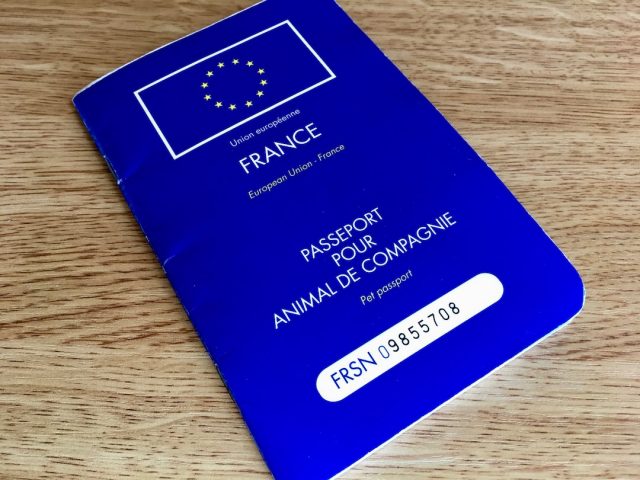
Other than when checking into flights, our pet passport was only checked when we travelled to Malta, plus when we travelled to the United Kingdom prior to Brexit. Malta is one of the countries that is quite stringent with the importation of pets, and I recommend reading my specific guidelines for how to take your dog to Malta .
I’ve also heard of someone being turned down for boarding a ferry to Corsica from mainland France, as their dog’s rabies vaccine wasn’t up-to-date.
On the other hand, despite also needing a worming treatment for dogs travelling to Finland and Norway, our dog’s passport wasn’t checked on either occasion, both at a road crossing and when boarding a ferry.
Any Additional Requirements for These Countries?
Generally, I’ve assumed that there are no additional requirements for pets travelling into any of the EU countries. However, this is not always the case.
For instance, when travelling to Malta you also need to advise the country in advance of your pet’s arrival, so that they can be checked by a vet on arrival. As Malta doesn’t have any land borders, you’ll likely be reminded of this if booking a flight or ferry trip to the country with your dog. I’ve covered the whole process in my guide to travelling to Malta with a dog .

Sweden also has the requirement to advise the country of your dog’s arrival, but only at the customs declaration point or through an online form, with no need to do it in advance. I didn’t actually find out about this until I was leaving the country, and luckily didn’t suffer any consequences. I cover this fully in my guide to travelling in Sweden with a dog .

I’m not aware of any other EU country that has any additional requirement, but I recommend double-checking the individual country websites listed here , if in doubt. When it comes to related countries, as I mentioned above both the Faroe Islands and Iceland have quite strict entry procedures.
What About Puppies?
There are some exceptions to the rabies vaccination requirements for young animals that are too young to be vaccinated. I don’t recommend travelling with animals so young for a holiday, but if they are crossing the border to go to their new home refer to the EU regulations .
Travelling into the EU from Other European Countries
If you are travelling into an EU country or one of the related countries from another European country, the rules are more complex and similar to travelling to Europe with your dog from elsewhere in the world .
Depending on what country you are travelling from, a rabies titre test may or may not be required. Additionally, an animal health certificate or “Annex IV” will be required if you don’t have a pet passport from the EU or a related country.
Which Countries Require a Rabies Titre Test?
If you are travelling into the EU from these European countries, a rabies titre test is required: Albania, Armenia, Azerbaijan, Georgia, Moldova, Montenegro, Serbia, Turkey, Ukraine.
A rabies titre test is not required for “Part 2 listed” countries, as listed on the bottom table on this page . These five European countries are included: Belarus, Bosnia and Herzegovina, North Macedonia, Russia, United Kingdom (including Guernsey, Isle of Man and Jersey).
What are the Requirements of the Rabies Titre Test?
There are a number of rules stipulated by the EU for the administration of a rabies titre test, if your dog requires one to travel to the EU.
The sample for the test needs to be collected by an authorised veterinarian at least 30 days after your dog is vaccinated for rabies. The sample needs to be tested in an EU approved laboratory . Assuming a sufficient level of antibodies are detected (0.5 IU/ml or greater), you then need to wait three months after the sample collection date to enter the EU.
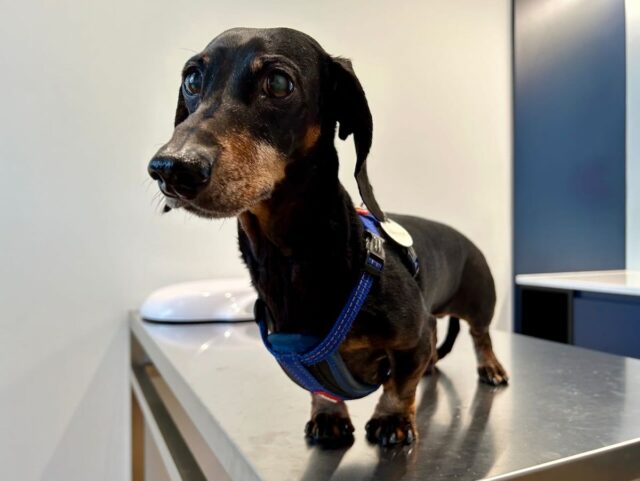
The rabies titre test though remains valid for the life of your pet, as long as they always receive their rabies vaccine booster shot before the previous one expires.
What About Pets from the EU?
If your pet is originally from the EU, it is advisable to get a rabies titre test done before leaving the EU. In this case, there is no waiting period applied. You can immediately travel back to the EU without waiting for three months after the rabies titre test. There is a section in the EU pet passport for recording your dog’s rabies titre test.
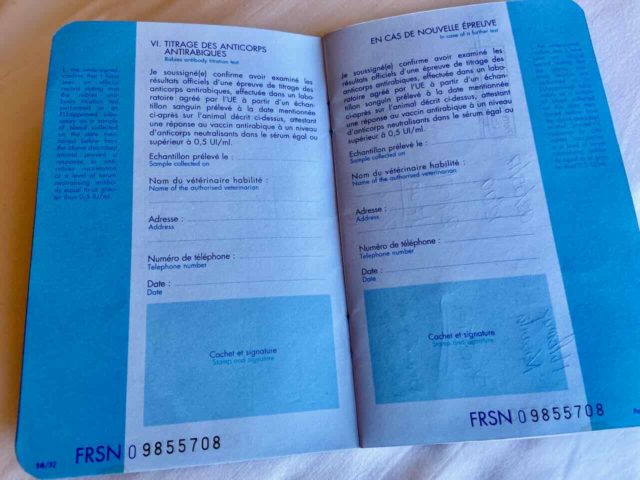
As noted above, the rabies titre test remains valid for the life of your pet, as long as they receive their next rabies booster shot before the previous one expires. If this doesn’t occur, your pet will require another rabies titre test (hence the room for recording multiple tests).
Is the Paperwork Really Checked?
During my travels around Europe, I didn’t actually make it to any of these countries. At first I wasn’t sure of the requirements for dogs travelling in between the countries (and didn’t realise that my rabies titre test from Australia was valid), and then I later ran out of time. So, I don’t have personal experience at travelling between these countries and the EU.
However, I have been informed by other travellers, that paperwork is not always checked when travelling from these countries into the EU. This includes travelling from Serbia into Bulgaria. However, it is advisable to always comply with the regulations and expect that paperwork may be checked.
If you go to cross the border and you haven’t had the rabies titre test done for your dog, there is a long waiting period. Especially if your dog is originally from within the EU and could have skipped the waiting period entirely!
What Entry Points are Allowed?
If you are entering an EU country or any of the related countries with your dog, you are required to enter at specific entry points, where your dog’s paperwork can be checked. These are known as “Travellers’ points of entry”, and may include airports, shipping ports and land border crossings.
To view the list of relevant entry points for each country, click here .
Travelling out of the EU to Other European Countries
When travelling from a country in the EU or one of the related countries to other countries in Europe, the list of requirements differs between different countries. You should check the requirements for the individual country.
Often it is sufficient to assume that travelling with your dog’s EU pet passport and an up-to-date rabies vaccine is sufficient, but this is not always the case.
At the moment, I have not yet travelled personally with my dog to these countries or investigated the details of the rules for most countries. As I investigate each country, I will list them here.
A handy initial place to check the rules is PetTravel.com , but always check the relevant government website to double-check your have the latest rules and the full details required.
Importing a Dog to Serbia
The rules to import a dog to Serbia are quite similar to the rules for importing a dog to EU countries.
For dogs being imported to Serbia from EU countries and the related countries, the rules are listed at the top of this page . Your dog needs to be permanently identified (such as by a microchip), vaccinated against rabies, comply with comply with any preventive health measures for other diseases, and be accompanied by either a passport or a health certificate, quite similar to the EU health certificate.
There are also rules listed for both Part 2 listed countries (as per the EU legalisation) and unlisted countries (generally higher risk countries). For unlisted countries, a rabies titre test is also required, performed by an EU approved lab, followed by a waiting period of three months.
Importing a Dog to Albania
The rules to import a dog to Albania are again relatively simple and similar to those for importing a dog to EU countries. The more complicated part is making sure you can re-enter the EU with your dog from Albania!
Your dog needs to have a microchip, be vaccinated against rabies (with 3 year vaccines recognised) and have a bi-lingual health certificate. For more information, see the guide put together on World Wide Walkies , along with plenty more tips about visiting Albania with a dog.
Importing a Dog to Turkey
The rules to import a dog to Turkey are not that clear, with different interpretations on different websites. At a minimum, your dog needs to be microchipped and vaccinated against rabies, at least 30 days in advance.
It is likely the 3-year rabies vaccine isn’t recognised, so make sure you dog has been vaccinated in the last year. Additionally, a rabies titre test may or may not be required. Read my full discussion on the rules for travelling to Turkey with a dog .

Is the 3-Year Rabies Vaccine Recognised?
Within the EU countries, the 3-year rabies vaccine is recognised. This means that if your dog receives a 3-year rabies vaccine, your dog does not need a booster shot for another three years. However, there are some countries around the world that only recognise 1-year rabies vaccines, and required your dog to have a booster shot yearly.
The following European countries require a yearly rabies vaccine (according to my investigations): Belarus, Moldova, Montenegro, Russia, Turkey, Ukraine.
You May Also Like
- Taking Your Dog to Europe: Vaccines & Paperwork
- Is it Possible to Visit Turkey with a Dog?
- Do I Need a Rabies Titre Test to Travel with My Dog?
About the Author

Shandos Cleaver is the founder of Travelnuity: Dog-Friendly Travel. She has travelled extensively with her Miniature Dachshund, Schnitzel, including to 33 countries across Europe, every state and territory of Australia except Tasmania, and 10 of the United States. She’s passionate about providing inspiration and information to others wanting to travel with their dogs, whether close to home or internationally.
Inspired? Pin this to your Pinterest board!

17 thoughts on “Rules to Travel With a Dog Between European Countries”
Wonderful article and you explained so much. Thank you so much!! We are traveling in Europe for 8 months (from the US) and visiting different locations. Couple quick questions and hope you may know the answer. We have the Pet Certificate and haven’t got a EU Passport, based on your article.. this pretty much takes the place of it. If we decide to get a EU Pet Passport, did this need to be applied for within so many days of our arrival in France or can we apply 3 months after arriving in France and nothing additional is required? We may go to Prague for the day when we are staying in Austria.. I noticed they need approval of your EU Pet Passport? Is this the case? I thought our Pet Certificate was good for travel in an country within the EU? Last question.. We plan on traveling for 8 months and our health certificate is good for four.. How do we get another one for the 2nd 4 months? Do we get that from a vet in the EU or will we have to go back to the US after 4 months. Any help would be appreciated. Thank you
The certificate you have is good for travel for 4 months, including Prague. The best thing to do before this period is up, or before you next cross country borders after 4 months, is to get a pet passport. France is being problematic about giving pet passports to pets who aren’t registered there, since the UK left the EU and many English have tried to get French pet passports. But most other countries should be fine. Some vets won’t transfer across the rabies vaccine, and may insist on a booster shot, that they will then record. Hope this is clear!
Brilliant article. Helps with so much but I think I’m just confusing myself. We’re going to Austria next year with our dog. She’ll get a rabies vaccination and an Animal Health Certificate before going. We’re using the tunnel and she’ll be checked in Calais. Our final destination is Austria. Does she have to get checked at their border too? Or not as it’s all the EU?
No, she only needs to get checked at the Tunnel when first entering the EU. Just keep the certificate handy in case you’re asked later when crossing borders, but it is extremely unlikely.
Great article! Can’t thank you enough! Just one thing that I couldn’t really find an answer anywhere. My pet is in the EU and has an EU passport. We will travel to Turkey and back. Do you know if she needs an EU health certificate also?
I’ve covered the requirements for Turkey here: https://www.travelnuity.com/dog-friendly-turkey/ . For returning to the EU, your dog will not need an EU pet health certificate as long as they have an up-to-date EU pet passport, including rabies vaccine and in the case of Turkey a rabies titre test result.
Great article! Thank you. Just wondering if you have travelled under one year, and have had Rabies vaccinations and titre test prior to leaving Australia, what are the quarantine requirements etc needed to return to Australia with your dog?
Meaning travelled through the EU & UK only.
We had a rabies vaccine and titre test before leaving Australia. Until recently, the titre test was valid for up to 2 years. So, when we returned to Australia after about 22 months, our dog’s titre test was still valid and he quarantined for 10 days. With the recent changes, I believe the titre test is only valid for 1 year, so we would have had to get a new titre test (or return in under a year). I also believe the records from your dog leaving Australia counts as proof of identity. We travelled throughout the UK, EU and USA.
Great article to read, thankyou. Can I ask, i live in Bulgaria, will be taking a road trip to the uk and back to Bulgaria, we will be transiting through serbia into hungry, and then on the way back through hungry, serbia, back into Bulgaria, will I need to get a titre test done ? My understanding is i don’t, because I’m not stopping in serbia. Thankyou 🤞
I recommend getting a titre test done before leaving Hungary. This is technically required for crossing the border from Serbia into Hungary or other EU countries – I haven’t heard about it not being required if you’re not stopping. I have heard that it is rarely checked, but I would get it for my own peace of mind.
The potential headache is that if you get it done in Serbia, there is then a long waiting period before it is valid to enter the EU, but there is no waiting period if you have it done before leaving the EU.
I brought my dogs from Montenegro to the UK in May 2023 and they have Montenegrin passports. We are now planning our trip to Montenegro and are wondering if their passports are valid for travel? We understand that they would still need the health certificate to leave the UK but would their rabies vaccination (given in Montenegro) and titre test (approved by a Serbian lab) be valid?
I haven’t heard whether Montenegrin passports are valid in place of EU pet passports. I know the Swiss ones are, but I don’t know whether this extends to Montenegrin ones. With the EU pet health certificate used to exit the UK, this is then valid for 4 months travel within the EU, including crossing borders.
Hello Shandos, Thanks for the article. I want to ask about crossing the border between Croatia and Hungary (I will be going by train – the dog is allowed on trains in both countries so I know that is ok although I think going actually across the border is by bus). My dog has an AHC as we are from the UK and a pet passport issued on a previous trip to Portugal but I am just wondering is it possible just to take a dog across a land border between two EU countries at any border crossing?
Hi Naomi, While I haven’t crossed the border between Croatia and Hungary with my dog, we crossed plenty of borders between other EU countries (and the EU and Switzerland), without any checks at all – either by road or on trains. I know there’s the list of Travellers Entry Points, but I think they’re mainly for entering the EU from non-EU countries, I’ve never heard of being restricted on border crossings by other travellers either. Have a great trip! Shandos
Hello! I’m travelling to Albania from Finland by car with my two chihuahuas. They have EU passports. Do they need titre test done in Finland as well? We’ll travel via Baltia-Poland-Czech-Austria-Slovenia-Bosnia-Montenegro-Albania and same way back. Is there anything else to pay attention?
I recommend having the rabies titre test done before leaving and entered in the EU pet passports. This way there’s no waiting period. Otherwise, if you have it done in Albania, you’d then have a 3 month wait before you could re-enter the EU. This also applies for Montenegro and Serbia.
I haven’t fully reviewed all the requirements for all the non-EU countries. See the links above for Serbia and Albania, but you may want to search for the government pages for Bosnia and Montenegro. Usually though its microchip + rabies vaccine + pet passport/health certificate, sometimes the rabies titre test. I’ve often heard from people road tripping through the Balkans that dog passports are often not checked, but I would always be prepared.
Leave a Comment Cancel reply
Save my name, email, and website in this browser for the next time I comment.
Country and language
United Kingdom
United States
Deutschland
@media (max-width: 37.5rem){.css-vo707v{font-size:1.5rem;}} Log in
Verify it's you, @media (max-width: 52.5rem){.css-1qvpg8e{font-size:1.375rem;}} no account.
Join Club Eurostar for FREE
- Travelling with Eurostar
- Frequent travellers
- Manage your booking
Frequent or Premium Pass
Please log in to use your subscription pass.
Didn't get the code? Send again

Travelling with pets on Eurostar
Everything you need to know about bringing your pet on board our trains between Belgium, France, the Netherlands and Germany.
Can I take my pet on Eurostar?
Taking your seat.
At Eurostar, we always want to make sure that everyone enjoys their journey. Please check that the passengers seated around you are happy with the presence of your pet. If anyone is a little nervous, the Train Manager will happily find you an alternative seat.
Does my pet need a ticket?
On our trains between Belgium, France, Germany, and the Netherlands, small domestic animals weighing less than 6kg travel free of charge – provided they travel in a carrier (max. 45 x 30 x 25 cm).
Larger dogs that don’t fit in a carrier will need a ticket with our specific “dog” fare (single price of €30). Please speak to the Train Manager to purchase a ticket for your four-legged friend. Your dog must sit on your lap or on the floor of the coach and be leashed and muzzled.
Guide dogs and assistance dogs and cats always travel free of charge on Eurostar.
Animals that are not permitted on Eurostar
As much as we love animals, we can’t welcome all of them on board. Dangerous dogs, wild animals and birds (parrots, canaries etc.) are not allowed on our trains.
You may also like

Our travel classes
Whatever your needs, we've got them covered with our three travel classes - Standard, Standard Premier and Business Premier.
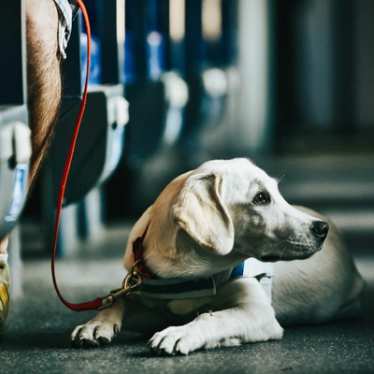
Guide and assistance animals
Come prepared to get on board with your guide or assistance dog and find out which travel documents are required.

All Eurostar destinations
Choose from our great selection of European city and weekend breaks.

An official website of the United States government
Here’s how you know
Official websites use .gov A .gov website belongs to an official government organization in the United States.
Secure .gov websites use HTTPS A lock ( Lock A locked padlock ) or https:// means you’ve safely connected to the .gov website. Share sensitive information only on official, secure websites.

Animal and Plant Health Inspection Service
Bring a Pet From Another Country into the United States (Import)
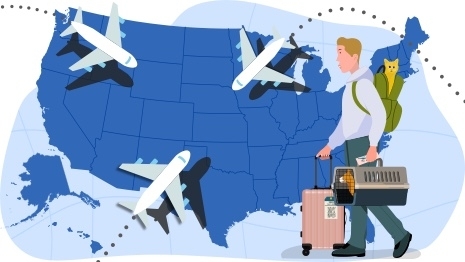
Animals entering the United States may be subject to regulation by APHIS and other Federal agencies. Depending on your destination State, your pet may need to meet State entry requirements in addition to Federal entry requirements. Pet owners are responsible for meeting all Federal and State requirements.
Requirements
Before you travel, make sure you carefully read and understand all import requirements for your animal. Failure to meet these requirements will result in problems upon arrival to the United States, and your pet may be refused entry.
If your animal isn't listed below, it may not qualify as a pet and, therefore, may be subject to different import requirements by APHIS.
If you're traveling with a pet bird or exotic animal, you may need to work with additional agencies, such as the U.S. Fish and Wildlife Service and Centers for Disease Control and Prevention .
Select an animal to view the entry requirements:

*Not all birds qualify for pet travel.
Read on for more information.
The following birds DON'T qualify as pets, meaning they're subject to different regulations . Because they may carry and transmit certain diseases to the U.S. poultry industry, these birds are regulated as poultry.
- Guinea fowl
View the import regulations if your bird does not qualify as a pet
The perfect holiday in Mexico – a land of superlatives
Mayan mysteries, Aztec treasures, empty beaches, culinary sensations – here is our ultimate escape

The luxury goodies you get flying first class with eight different airlines
Europe’s best car-free beach holidays, the hidden corners of britain’s most accessible national park, the sussex town fighting to reopen its french-owned beach, how ‘the galapagos of the indian ocean’ lives up to its name, destinations, the perfect holiday in normandy – the most english corner of france.

How to have an unforgettable weekend in New York

Canary Islands
Italian lakes, uk holidays, 10 underrated corners of the uk for a weekend break.

Where to find Britain’s darkest skies

How owners keep the lights on at England’s stately country piles
Britain’s best (and worst) new towns, the ultimate guide to the brecon beacons, grimsby’s grand plan to become a tourist destination, scotland’s 10 greatest islands, what michelin’s new hotel rating system means for travellers – and what makes a three-key stay.

The best hotels in
North america, south america, ultimate itineraries, the perfect holiday in south africa.
.jpg?imwidth=160)
The perfect holiday in Sicily

The perfect holiday in Canada

The perfect holiday in the Italian Lakes

The perfect holiday in Provence

The perfect Greek island-hopping holiday

The perfect holiday in Alaska

City breaks
The 50 most beautiful cafes on earth.
A great café is as important a pilgrimage site as a cathedral, a world-class museum, an ancient ruin or a modern architectural marvel

Expert city guides
How to spend a perfect weekend in paris, how to spend a glamorous weekend in dubrovnik, the perfect holiday in cape town, how to spend an artistic weekend in florence, the ultimate guide to a cool weekend in copenhagen, the 10 best mediterranean cruises – still with availability for this summer.

The world’s most unusual river cruises

The 10 best Nile cruises for 2024
22 key cruise holiday questions answered – from seasickness to saving money, the ultimate guide to the round-the-world cruise, introducing the new cruise map of europe – with venice falling from favour, every city you can visit from the uk on a cruise, trips of a lifetime, the ultimate guide to a perfect northern lights holiday.

How to visit Antarctica – everything you need to know

The secret to the perfect Machu Picchu adventure

How to do the greatest road trip in Australia

The ultimate travel guide to the Great Barrier Reef

The greatest US road trips – from Route 66 to Highway 1

Essential advice
The easy way to save money on a long weekend away.

Travel insurance
Holiday car hire, airport savings, family holidays, flight delay compensation, winter sun holidays, the tech hack that can save you hundreds of pounds on your holiday, 20 tips for a trouble-free summer holiday, travel scams have evolved – here are the ones to watch out for, the best and worst countries in europe for good weather, the problem with finding affordable travel insurance when you reach 60, activity holidays.

Walking and hiking

Safaris and wildlife
.jpg?imwidth=160)
Rail journeys

More Travel stories

Water sports and Bronze Age forts – why Sardinia is perfect for a family holiday
My cycle tour of germany’s version of the pyramids.
US couple’s trip to Brazil becomes 4-month ordeal after wife gives birth early

A Minnesota couple who traveled to Brazil in February for a two-week vacation have now spent nearly four months there after the wife went into premature labor , delivering their son at 28 weeks.
Chris and Cheri Phillips, of Cambridge, arrived on Feb. 22 in Brazil, where they planned to celebrate the eighth birthday of Chris's daughter from a previous relationship, who lives full-time with her mother in Brazil.
The couple told " Good Morning America " they were also looking forward to spending time relaxing ahead of the birth of their first child together, who was due in early June.
Their plans changed on March 8 -- just days before they were scheduled to fly home -- when Cheri Phillips began experiencing labor pains.
"It started off that I just kind of had a backache ... I thought I just need to go lie down and I'll feel better in the morning," said Cheri Phillips. "About 4 a.m., I started bleeding, so I woke Chris up and off to [the] hospital we went."
Once she was admitted to a local maternity hospital in Florianópolis, a city in Southern Brazil, doctors spent the next four days trying to prevent Cheri Phillips from going into early labor, according to the Phillipses.

Chris Phillips said they initially hoped Cheri's labor pains were minor enough that they would be able to fly back home to Minnesota before she gave birth. But soon, he said, it became apparent that their son would unexpectedly be born in Brazil.
The American College of Obstetricians and Gynecologists advises that healthy, pregnant women can travel safely until they are 36 weeks pregnant, with the ideal time to travel coming between week 14 and week 28 of pregnancy.
Pregnant women who travel by plane also have to take into consideration restrictions and requirements from airlines, which each have their own set of rules.
Editor’s Picks

New requirements for Americans traveling to Europe postponed until 2025

How a female trucker influencer got stuck in Dubai due to an argument with a rental car agent

Groom gets new passport in time for wedding after dog ate it
ABC News' Chief Medical Correspondent Dr. Jennifer Ashton, a board-certified OBGYN, has previously said the primary reason pregnant women are warned against travel in the final weeks before birth is more about logistics and care than medical complications from flying.
"Her pregnancy had been perfect until that point," Chris Phillips said of his wife, adding that prior to their trip, the couple had taken precautions, including identifying the hospital nearest them in Brazil and receiving approval from their OBGYN to travel as Cheri Phillips was still in her second trimester. "Every ultrasound showed that Greyson was perfectly on schedule and perfectly on track for each gestation period."
Related Articles
Mother gives birth to baby mid-air on transatlantic United flight
On March 12, doctors in Brazil had to rush Cheri Phillips, then 28 weeks pregnant, into an emergency C-section, the couple said. After what the Phillipses described as a complicated and tense delivery, their son, Greyson Leo Phillips, was born weighing just over 2 pounds.
"For us, wasn’t a moment to celebrate. It was just pure fear and pure panic, for his health, for Cheri's health," Chris Phillips said. "And then, logistically, how are we going to get home in terms of all the bureaucratic stuff on both the Brazilian side and the American side? What are we going to do about health insurance?"
Almost immediately after his birth, Greyson was admitted to the hospital's neo-natal intensive care unit, or NICU, according to the Phillipses.

For the next 51 days, Greyson stayed in the NICU while his parents found places to live during their unexpectedly extended stay in Brazil, first at the hospital during Cheri Phillips' stay and then at multiple vacation rentals.
While spending their days with Greyson in the NICU, Chris Phillips, who speaks Portuguese fluently, translated between his English-speaking wife and the Portuguese-speaking medical staff.
"It was difficult for me to be fully present as a partner and as a father because I was working as a medical interpreter," Chris Phillips said. "I would retain some of the information that was passing through my brain, but a lot of the times, I would just count on Cheri to remember what I had interpreted, and then catch me up to speed afterwards so then we could make decisions as a parenting couple."
Cheri Phillips said the experience left her with fear that something would happen to Greyson and she wouldn't be able to communicate with nurses and doctors. In addition to being born premature, Greyson was diagnosed at birth with patent foramen ovale, or PFO, a hole in the heart that has failed to close after birth.
"I never quite knew what was happening, especially if I went alone, which happened because Chris couldn't always be there," Cheri Phillips said. "There were definitely days I came back [from the NICU] just absolutely defeated."

At the same time the couple was caring for their son in the NICU, the Phillipses were working around-the-clock to get Greyson the paperwork he'd need to be able to leave Brazil and travel to the United States.
The couple said they fought for weeks to get Greyson's birth certificate from officials in Brazil so that he could be issued an American passport. Their fight included hiring a lawyer to help them navigate legal roadblocks in Brazil, working with their U.S. senator's office in Minnesota and the U.S. Embassy in Brazil and sharing their story with local media outlets to raise awareness.
In early May, when Greyson was discharged from the hospital, he still did not have the birth certificate he needed to obtain a passport, according to the Phillipses.

"I struggled quite a bit that first week or two of having him here with us just knowing that the only reason we were stuck here is because we couldn't get his birth certificate," Cheri Phillips said. "I emotionally had a very hard time with that."
She continued, "I was stuck in this Airbnb that wasn't mine, not speaking the language, didn't have my village, no family, no friends."
The couple also had to purchase all the newborn essentials they needed for Greyson, including diapers, clothes and a crib. Their baby shower, they said, had been scheduled for March 30 at home in Minnesota.
As the days and weeks went on, both Chris and Cheri Phillips also had to return to work, each doing their Minnesota-based jobs remotely from Brazil.
The couple said they also completed the sale of their home in Minnesota and closed on a new home nearby during their time in Brazil, a process they had planned on completing in-person after their originally scheduled return date.
"It is truly overwhelming. You just kind of put your head down and get through it the best you can," Chris Phillips said. "What sustains us is the simple fact that there’s no option of giving up ... we have to get home."
It was not until June 5, nearly three months after his birth, that the Phillipses secured Greyson's emergency U.S. passport.

The couple said they are now planning to leave Brazil with Greyson on June 23, and arrive in Minnesota on June 25, where family and friends will be there to welcome them.
"I’m excited to actually bring home. We haven’t been able to bring him home yet," said Cheri Phillips. "I’m excited to be able to relax in our space, in our home, where we’re comfortable, and with our village, to be able to have grandparents and cousins and aunts and uncles over."
Both Cheri and Chris Phillips said despite the obstacles, one silver lining of the whole experience has been spending time with Chris's 8-year-old daughter Melory, who has been able to bond with her baby brother. By chance of his early delivery, Greyson was born in the same operating room of the same hospital as Melory.
"She has absolutely taken to the role of big sister more than you can imagine," Chris Phillips. "He's the cutest thing in the world to her."
Added Cheri Phillips, "He’ll always have a special bond with Brazil, being born here and his sister lives here."
Up Next in Family—

Naomi Campbell reveals she welcomed both of her children via surrogacy

Mom shares realistic summer reminder for parents: 'It's OK to be in a hard season'

Nike releasing 'Girl Dad' sneakers in honor of the late Kobe and Gigi Bryant
Shop editors picks, sponsored content by taboola.
- Privacy Policy —
- Your US State Privacy Rights —
- Children's Online Privacy Policy —
- Interest-Based Ads —
- Terms of Use —
- Do Not Sell My Info —
- Contact Us —
© 2024 ABC News
Navigate at sbb.ch
- To contents
Service links
- Search Open Search term Search
English is currently selected as the language.

Rail replacement bus for journeys to Milan via Domodossola.
From 9 June to 8 September 2024, EuroCity trains to Milan from Basel, Bern and Geneva will only run to/from Domodossola. Some EuroCity trains between Geneva, Lausanne and Milan will be completely cancelled during this time. In addition, the section between Iselle and Domodossola will be closed from 9 to 30 August 2024. To ensure that you can still get from Switzerland to Milan, the rest of Italy and back home again, we are organising rail replacement buses together with our cooperation partner Trenitalia.
Reason for the track closures: the 4-metre corridor between Arona and Verbania is being expanded for freight traffic. A bridge between Iselle and Domodossola also needs to be renovated.
The timetables for journeys to Italy from Basel, Bern, Geneva and Lausanne via Domodossola and the journey times for the rail replacement buses have been amended in the digital timetables on SBB.ch and in the SBB Mobile app. Please note that the journey involves longer journey times and fewer seats. However, together with Trenitalia, we are doing everything we can to ensure that you arrive safely and we ask for your understanding.
- Detailed information on the rail replacement buses and their points of departure can be found by making a timetable enquiry on SBB.ch or via SBB Mobile.
- You can find specific information about trips that have already been booked on this website. For this, all you need is the date of travel and the bus number, both of which appear on the ticket.
- EuroCity rail replacement buses can be identified by the bus number ‘EC000’.
- Important information: rail replacement buses are also being organised within Italy for the regional trains between Domodossola and Milan. These can also be found in the timetable, but the information here does NOT apply to these regional rail replacement buses.
General information about the EuroCity rail replacement buses.
Come aboard..
- Your ticket is your key to the rail replacement bus. Present it to the bus staff either as a printout or on your smartphone. When you buy a ticket, you automatically receive a reservation for a guaranteed seat.
- There is free choice of seats on the bus.
- Food and drink are permitted on the buses.
- You can store large items of luggage in the luggage compartment on the bus, which is accessible from the outside.
- Hand luggage that fits in the upper luggage storage space or under your seat can be taken on the bus.
Unfortunately, it is not possible to transport bicycles on the buses.
- Small dogs with a height of less than 30cm at the withers can be taken on the bus in a transport box.
- For space reasons, larger dogs are not permitted on the bus.
- This does not apply to assistance dogs, which are always allowed on the bus.
Rail replacement buses for the EC trains between Domodossola and Milan.
Information on the EuroCity rail replacement buses running from 9 June to 8 September 2024 between Domodossola and Milano Centrale. Tip: Even if you are travelling from Geneva or Lausanne, this is the quickest option for you.
Domodossola.
The stop for the rail replacement bus in Domodossola is located at Piazza G. Matteotti in the official bus station.

Milano Centrale.
The stop for the rail replacement bus in Milano Centrale is located at Piazza IV Novembre, at the ATM stop near the Hotel Gallia.

Bus features.
Domodossola–Milano Centrale / Milano Centrale–Domodossola.
Bus numbers.
Bus operator., direct buses between geneva, lausanne and milan..
From 9 June to 8 September 2024, direct buses will run via the Great St Bernard Pass on the Geneva–Lausanne–Milan route and vice versa. A reservation is required. You can get tickets on SBB.ch.
Stops for the direct buses.
The stop for the direct bus in Geneva is located at Cornavin railway station in front of the Amavita pharmacy.

The stop for the direct bus in Lausanne is located at bus stop F.

The stop for the direct bus in Milano Centrale is located at Piazza IV Novembre, at the ATM stop near the Hotel Gallia.
Buses with the numbers EC134 / EC136 / EC137 / EC139.
Geneva–Lausanne–Milano Centrale / Milano Centrale–Lausanne–Geneva.
Intertours.
- 1 space for wheelchair-users
- Toilet (not disability-accessible)
- Power sockets
- Sale of coffee and other drinks
Buses with the numbers EC132 / EC141.
Journeys with a change in iselle and domodossola between 9 and 30 august 2024..
From 9 to 30 August 2024, the Brig–Domodossola line will also be closed along the Iselle–Domodossola section. Shuttle trains will run between Brig and Iselle and rail replacement buses will run between Iselle and Domodossola and between Domodossola and Milan. These journey times will also be longer and there will be fewer seats available. The exact rail replacement concept is currently being developed with our Italian partners and will be published on this page by 10 July at the latest. Essentially, it will look like this.
Transfer concept.
- If you are travelling to Milano Centrale via Domodossola, travel to Iselle and change to the rail replacement bus there. The bus will take you to Domodossola, where you will then have to change to the rail replacement bus for Milan.
- If you are travelling from Milano Centrale to Switzerland via Domodossola, take the rail replacement bus from Milan to Domodossola and change there to the rail replacement bus that takes you to Iselle. From there, your journey can continue by train.
- This will extend the journey time by 30 minutes.
The bus stop in Iselle is located at the railway station itself.
Further content
More on the topic..
- Orario online
- By train to Italy
- Planned construction work in Europe
Help & contact.
Replacements for Internet Explorer 11.
Microsoft is gradually discontinuing its support for Internet Explorer 11 ( more info on microsoft.com Link opens in new window. ). If you continue to use Internet Explorer to access SBB.ch, you may experience functional limitations and display problems in the future. For this reason, we recommend using a more modern browser (e.g. Mozilla Firefox Link opens in new window. , Google Chrome Link opens in new window. , Microsoft Edge Link opens in new window. ).
We are aware that switching to a new browser may take some getting used to and cause some uncertainties. A more modern browser will allow you to benefit from faster and more secure internet access in future. We are committed to continuing our work with the utmost enthusiasm in the future to guarantee you accessible and inclusive access to SBB.ch.
Help & Contact
Do you have questions, need help or want to get in contact with us? We’re here to help you.
Rail traffic information
Find the latest information on the current service situation, information, disruptions as well as planned construction work on the Swiss rail network and on strikes and on important disruptions and strikes abroad.
Newsletter & Social Media
Our newsletter regularly informs you of attractive offers from SBB via e-mail.
- Display the SBB Facebook page. Link opens in new window.
- Display the SBB X account. Link opens in new window.
- Display the SBB Youtube channel. Link opens in new window.
- Display the SBB Instagram account. Link opens in new window.
- SBB Social Media
- Jobs & careers Link opens in new window.
- Business customers Link opens in new window.
- Company Link opens in new window.
- SBB News Link opens in new window.
- SBB Community Link opens in new window.
Timeless SBB design.
Would you also like to get your hands on an official Swiss station clock by Mondaine? Whether you’d like it as a watch, wall clock, pocket watch or alarm clock, order the model you want online now. Link opens in new window. Take a look and order Link opens in new window.
- Cookie settings
- Legal information
- Data protection
- Accessibility
In collaboration with
Taking the long way home from Alaska

On an epic road trip, a family plots a course from Alaska to the Lower 48, passing through some of Canada’s most spectacular scenery. The tally: 2,200 miles, five national parks, numerous hot springs and one excellent reindeer hot dog.
- Show more sharing options
- Copy Link URL Copied!
Within months of the Pearl Harbor bombing on Dec. 7, 1941, the United States, in cooperation with Canadian authorities, set out to build a highway from British Columbia to Alaska, then a territory and viewed as vulnerable to attack by Japan. The original 1,685-mile road took more than 10,000 soldiers less than nine months to complete.
An upgraded version opened in 1948 and has been continually resurfaced and rerouted; It now measures just shy of 1,400 miles from Dawson Creek, British Columbia, to Delta Junction in Alaska, according to “The Milepost,” a guidebook to the drive.
The highway formed the heart of a family road trip I took last September from Alaska to Idaho, passing through the Yukon, British Columbia and Alberta, in Canada, along the way.
Relying on Google Maps won’t get you far on this drive, where cellphone service is sparse. In preparation, my son found a 1972 road map of western Canada and eastern Alaska that has remained fairly accurate.
The route, which takes motorists through some of the most stunning landscapes in North America, lends itself to a budget trip. We spent about $300 on fuel for the whole trip in a medium-size SUV. We often camped and ate picnic meals, starting in coastal Valdez, Alaska, where we overnighted on a 32-foot powerboat listed on Airbnb ($68 a night) with a great blue heron and a harbor seal as neighbors.
May and September, the start and end of the high-season months for traffic along this route, are also good times to see wildlife that is often pushed to lower elevations by snow.

Lessons in patience
From Valdez, we made our way to Wrangell-St. Elias National Park & Preserve (free), the largest U.S. national park, and then joined the Alaska Highway at Tok , a small town about 90 miles from the Canadian border that plays a large role in servicing sparsely populated eastern Alaska with its grocery stores, gas stations and restaurants.
We planned to drive deep into the Yukon on Day 1, but even with just 10 vehicles ahead at the border checkpoint, it took two hours to reach the lone agent, who asked us a few questions — mostly concerning firearms and hunting — and sent us on our way.
It was the first slowdown of many caused by stretches of unsealed road, construction detours and spots where the blacktop had pitched above frozen ground.

Yukon wilderness
Nearly 600 miles of the Alaska Highway traverse the Yukon.
From the border, the road travels southeast, passing yawning valleys with snaking streams and long glacier-fed lakes en route to Kluane National Park and Reserve , home to 19,551-foot Mount Logan, the highest mountain in Canada, and more than 2,000 glaciers. It, along with neighboring Wrangell-St. Elias and other parks, forms a UNESCO World Heritage site that enshrines the largest ice fields outside of the polar caps.
“This is how the Rockies would have looked years and years ago,” said Fitz McGoey, the visitor experience product development officer for the park, about 80 percent of which is covered by snow and ice.
Losing daylight, we opted for the first campground we could find north of the park. Quiet Lake Creek (20 Canadian dollars, or about $15, a night) offered riverside camping where we made quesadillas over a fire and fell asleep to the sound of a hooting owl while clutching cans of bear spray.

After days of driving and camping, and one excellent reindeer hot dog from a gas station in Haines Junction , we stopped in Whitehorse , the capital of the Yukon and the only major city on the highway, which was on the 52 Places to Go in 2024 list as a destination for northern lights tourism.
Across the 350 forested acres of the nearby Yukon Wildlife Preserve , a three-mile trail linked the habitats of 12 tundra species, including thinhorn sheep, arctic fox and Canadian lynx (admission CA$19).

Checking into the Raven Inn (CA$284), we explored Whitehorse’s walkable downtown and splurged on dinner at Belly of the Bison (bison Bolognese, CA$34). Afterward, our server directed us to the ’98 Hotel lounge for “a real taste of Whitehorse.”
It was open-mic night in the bar, which was decorated in animal skins and antique rifles, and free mugs of Molson beer arrived whenever someone rang the bell above the bar to buy the house a round.
The emcee encouraged reluctant talent by reminding the crowd, “There is no tomorrow if you don’t live today.”

Yukon kitsch
For the most part, the Alaska Highway is free of roadside kitsch with one enormously engaging exception: Signpost Forest in Watson Lake, Yukon (free).
Roughly 270 miles southeast of Whitehorse, a forest of poles displays innumerable road signs posted by motorists since 1942 when a homesick American soldier named Carl K. Lindley erected a sign with the mileage to his hometown, Danville, Ill.
Now license plates and tributes constructed of everything from flip-flops to a toilet seat compete with the signage.
“We call it the largest public display of stolen property in North America,” said Chris Irvin, the mayor of Watson Lake, in a phone interview, who estimated there are about a million signs in the forest.

In British Columbia, springs and safaris
In Alaska and the Yukon, we’d spotted bear and moose. But the wildlife in northern British Columbia, which we entered shortly after the Sign Post Forest, felt like a safari.
We saw black bears emerging from the woods and frequently stopped to view caribou grazing or herds of wood bison on the highway shoulder. A family of thinhorn sheep licking salt from the road nearly collided with our vehicle, their hooves skittering on the pavement.
Reassuringly, our next stop, Liard River Hot Springs Provincial Park , offered camping behind an electric bear fence (CA$26 a night). Campers have unlimited access to the springs, reached via a boardwalk — the original was built in 1942 by American forces — over a warm-water swamp and a boreal forest so unusual in nurturing species like orchids that it was originally named Tropical Valley.
With mossy banks, rubble bottoms and temperatures that ranged from about 108 to 126 degrees, the park’s natural pools stayed open around the clock, and we found solitude both at night while stargazing and the next morning in the fog of dawn.

The highway flattens as it nears its origin in Dawson Creek , a British Columbia town of 500 that grew virtually overnight to roughly 10,000 when highway construction began. Black-and-white photos of servicemen working on the road, sitting atop a truck mired in mud and bathing in a river filled the hallways at our hotel, the no-frills George Dawson Inn (CA$174, including breakfast).
The highway’s much-photographed Mile Zero marker neighbors a former grain elevator that has been restored as the Dawson Creek Art Gallery (free).
The gallery’s back stairway exhibits a collection of photos, letters and tributes called “The Road.” It included this anecdote: When the Indigenous people of Canada’s north questioned the speed of the road’s construction, they were told about Hitler’s plan for world domination, to which one replied, “What’s he want all that land for? He will surely die someday like everyone else.”
Alberta’s parks
From Mile Zero, the most direct route to the Lower 48 crosses into Alberta and transits two marquee attractions of the Canadian Rockies: Jasper National Park and neighboring Banff National Park .
In view of rising mountains, immense river valleys and herds of elk, we drove 280 miles, primarily on Highway 40, to Jasper National Park (CA$22 per family or group). Its main road follows the glacial blue Athabasca River to the town of Jasper, where we checked into HI Jasper hostel (CA$306 for a four-bed private room).
Rising early, we beat the tour buses to the park’s Maligne Canyon to peer into a river-carved chasm, following the flow from a cliff-top trail that descended with the river to rapids and pools.

Connecting Jasper and Banff over roughly 145 miles, the Icefields Parkway offered spectacular views of waterfalls and peaks winking in and out of the clouds. We picnicked on the rocky shores of the Athabasca and skipped tourism developments like the glass Columbia Icefield Skywalk , where admission starts at CA$41.
A double rainbow arched across Highway 93 as we entered Banff, the popular Canadian mountain town. We stayed just outside the busy city center at the Juniper Hotel (CA$317) and used its free shuttle service to hit the town center for a round at Three Bears Brewery and Restaurant (pints CA$9) and stock up on picnic supplies at Wild Flour Bakery .

A quiet alternative
On a sunny morning, as Banff flexed its magnetism, framing mountain views down seemingly every lane, we backtracked about 18 miles to rejoin Highway 93 as it takes a southwestern swing into Kootenay National Park (CA$22 per family or group).
In Kootenay, we had Marble Canyon, a 200-foot gorge with marble walls polished by a roaring river, to ourselves. Seven bridges allowed us to cross the narrow gap as ruby-crowned kinglets sang from the pines.

We found Kootenay’s crowds at Radium Hot Springs (CA$17.50). Surrounded by forested slopes, the large pool lacked the aura of a wilderness hot springs, but with family-friendly shallows and a stinging cold plunge, it was a great diversion.

From Kootenay National Park, the U.S. border lies about 140 miles south on uncrowded roads that follow rivers and lakes, skirting the British Columbia ski town of Kimberley , where we spent our last night at its new boutique hotel the Larix (rooms from CA$155 dollars, including breakfast).
The tiny former lead-, silver- and zinc-mining town is now an outdoorsy destination with three golf courses, a downhill ski area and over 60 miles of bike trails. Restaurants and breweries in the pedestrian center included Hourglass , serving cocktails, charcuterie and cheese plates (from CA$22). “We do pack a lot into this little town,” said Breanna Fast, a co-owner.
Just over an hour from the border, Kimberley made a fitting finale to a trip so packed with sights that I never cracked the novel I brought.
Glusac writes for The New York Times.

Get U-T Arts & Culture on Thursdays
A San Diego insider’s look at what talented artists are bringing to the stage, screen, galleries and more.
You may occasionally receive promotional content from the San Diego Union-Tribune.
More in this section

How to cope with restless leg syndrome while traveling
June 4, 2024

Tracing the long, winding path of an ancient Roman aqueduct
The Aqua Marcia was the longest of the city’s aqueducts, running nearly 60 miles from the countryside to the heart of ancient Rome. We followed its course, above and below ground.
June 2, 2024

Sober travelers find something to savor in wine country
Mocktail trails, olive oil tours and elevated dining experiences are among the many ways the renowned wine-producing areas of Sonoma, Mendoza and Tuscany are appealing to sober or sober-curious travelers

Navigating security lines at San Diego airport just got a little easier
San Diego is one of just 13 airports across the country that will now have a place where travelers can apply for TSA PreCheck, which speeds the process of going through security while you keep your shoes and belts on
May 29, 2024

Planning a national park trip this summer? Booking changes, new features in the works
More sites require reservations, the annual pass gets a big change, Juneteenth is now a new free entrance day and more changes for 2024
May 26, 2024

New to riding a sleeper train in Europe? Here’s what to know
More climate-friendly option growing in popularity in Europe

IMAGES
COMMENTS
Travelling with pets: dogs, cats and ferrets. EU rules make it easy to travel to another EU country (in this case the 27 EU countries + Norway and Northern Ireland) with your dog, cat or ferret. These rules also cover travel to the EU from a country or territory outside the EU.
It really all depends on when you're traveling and where you're traveling to. However, bringing your dog on a flight in the cabin usually costs around $125 to $250. Whereas transporting them in the cargo hold can usually be well over $1,000. For international pet shipping, licensed companies usually charge between $1,000 and $6,000.
In 2023, my dog Poppy flew United Airlines 37 times, vacationed in Aruba and Mexico, and, most exciting of all, got her European Union pet passport in Barcelona.. Poppy, who is trained to assist me with a psychiatric disability, flies free as my service animal.However, we were spending a small fortune each year on international health certificates (around $300 per certificate) required each ...
European countries require incoming pets to be identified with a microchip or transponder, which they verify by scanning and matching your dog's microchip number to your paperwork. A non-compliant nine or 10-digit chip may not be scannable. The 15-digit microchip meets ISO standards 11784/11785, making it readable anywhere.
Here's a list of 10 b est places to travel with a dog in Europe: Country. Pet-Friendly Highlights. 🇫🇷 France. Pet-friendly cafes and restaurants abound. 🇮🇹 Italy. Enjoy dog-friendly beaches along the stunning coastline. 🇪🇸 Spain. Many hotels and parks welcome your furry friend.
Paperwork for Travelling to Europe with a Dog. The paperwork for taking your dog to Europe depends on what country you're travelling to. The situation is easiest if you're initially travelling to a country in the European Union (EU), with the same rules apply for dogs arriving in nearly every country, making it easier to keep on top of what you need to prepare. (I
The 10 Tips for Traveling With a Dog to Europe. 1. Research the Destination Country's Travel Policy. Image Credit: Kampus Production, Pexels. Before you start booking flights, make sure to familiarize yourself with your destination country's pet travel laws. If you're going to a country that is a member of the European Union, you can ...
3. Check-in counter. At the check-in counter, the airport worker weighs the carrier with a pet inside and gives the owner a ticket to pay. A person can't get a boarding pass without paying a fee that varies depending on the animal and the airline company. 4.
Europe is largely rabies free, although wildlife-mediated rabies still occurs in some countries, including in the EU. Due to this, it's a requirement that your dog is vaccinated against rabies before travelling to the EU. If you're vaccinating your dog for the first time, it must be completed at least 21 days before arriving in the EU (plus ...
Travelling with more than 5 pets. You cannot take more than 5 pets to an EU country or Northern Ireland unless you're attending or training for a: competition. show. sporting event. You'll ...
Traveling Europe by car with dogs can be an enriching and memorable experience for both you and your furry companions. With careful planning, preparation, and a sense of adventure, you can create unforgettable moments exploring the diverse landscapes and cultures of this beautiful continent together. So, pack up the car, buckle up your pups ...
For dogs travelling to the European Union (the majority of countries in Europe), I list all the steps in this post, plus briefly cover the requirement for other non-EU countries. Key Steps to Travel to Europe with a Dog. If you're travelling directly from the USA to the EU (and most other European countries), the steps required are quite simple:
The capital of Latvia is a wonderful destination ; it has been selected by thousands of travellers as one of the best destinations for a city break in Europe. With more than 230 pet friendly accommodations, Riga is also one of the best pet friendly destinations in Europe . Book your hotel, B&B, guesthouse, appartment at the best price in Riga ...
Here are some simple steps that will get you and your dog safely, legally, and happily to Europe. 1. Make sure your dog is healthy, microchipped, and ready for travel. To travel internationally with your dog, you'll need to get an international standard microchip (HomeAgain is a common brand) and make sure your dog is up-to-date on his or her ...
Contact your veterinarian or a designated animal health authority in your country to obtain an EU pet passport application form. Complete the form accurately and include all necessary information, such as your contact details, pet's identification details, vaccination records, and health certificate.
Pet owners traveling with their cat or dog to Europe, specifically to an EU country, will need to get an EU animal health certificate issued within 10 days before the animal enters the Union. It's helpful to know that non-EU European countries, such as Switzerland, will often accept this document too. However, if you're traveling to a ...
Although some people might use the term pet passport to refer to any documentation that is required for dog travel, the European Union (EU) does issue an official Pet Passport. These documents are ...
Step 2, book a taxi from Folkestone to Calais via the Eurotunnel shuttle with Pet Travel Abroad. Book your trip by calling Pet Travel Abroad (part of Folkestone Taxis) on 01303 246 925 (+00 44 1303 246925 from outside the UK), see their pet transport page at pettravelabroad.co.uk.
WOOF, small dogs can travel for FREE as long as they're in a bag, basket, or able to sit on your lap. If you are traveling with a larger dog, you can purchase a "dog ticket" for €3.30 online. This "dog ticket" is mandatory for larger dogs and is only valid in domestic NS and Arriva trains. Large dogs must also be leashed.
Check your dog regularly for parasites and carry a tick removal tool with you when you travel. Ticks are widespread but different species of ticks, each bringing with it a separate risk of other infections, predominate in distinct areas of Europe, therefore advice will be provided as appropriate in each country.
When travelling between countries within the EU and a number of "related" countries, this page sets out the requirements for your dog. Essentially, your dog needs to be microchipped, have been vaccinated for rabies at least 21 days ago, and have a pet passport. For a handful of countries, there is also the requirement for the dog to have a ...
On our trains between Belgium, France, Germany, and the Netherlands, small domestic animals weighing less than 6kg travel free of charge - provided they travel in a carrier (max. 45 x 30 x 25 cm). Larger dogs that don't fit in a carrier will need a ticket with our specific "dog" fare (single price of €30). Please speak to the Train ...
Requirements. Before you travel, make sure you carefully read and understand all import requirements for your animal. Failure to meet these requirements will result in problems upon arrival to the United States, and your pet may be refused entry. If your animal isn't listed below, it may not qualify as a pet and, therefore, may be subject to ...
ITravelInsured Travel GT: The Travel GT plan is a group plan for 10 or more travelers. Benefits include trip cancellation reimbursement up to $30,000 and interruption coverage up to 125% of trip ...
Telegraph Travel offers the best holiday inspiration, advice, hotel reviews, news and interviews, first person stories, analysis, comment, data and interactive tools from the best writers in the ...
Travelling in Europe 2023. The European Health Insurance Card. Saving fuel costs with energy efficient tyres. Consular protection outside the EU. If you are a non-EU national, you can find information on the conditions to migrate to an EU country. Roaming: Using a mobile phone in the EU.
New requirements for Americans traveling to Europe postponed until 2025. How a female trucker influencer got stuck in Dubai due to an argument with a rental car agent. Groom gets new passport in time for wedding after dog ate it.
Journeys with a change in Iselle and Domodossola between 9 and 30 August 2024. From 9 to 30 August 2024, the Brig-Domodossola line will also be closed along the Iselle-Domodossola section. Shuttle trains will run between Brig and Iselle and rail replacement buses will run between Iselle and Domodossola and between Domodossola and Milan.
June 10, 2024 2:05 AM PT. Within months of the Pearl Harbor bombing on Dec. 7, 1941, the United States, in cooperation with Canadian authorities, set out to build a highway from British Columbia ...